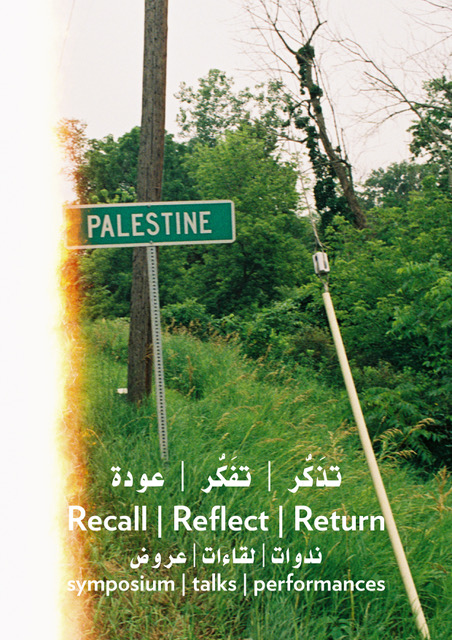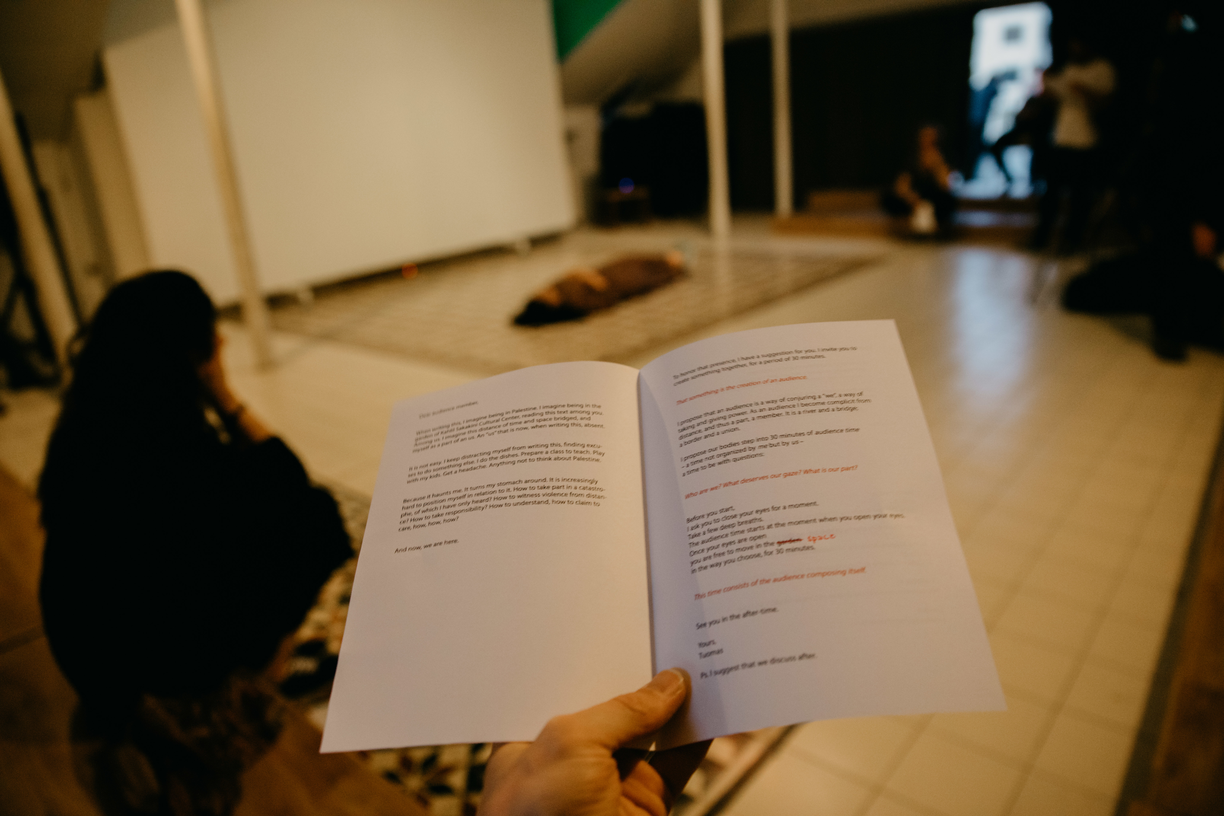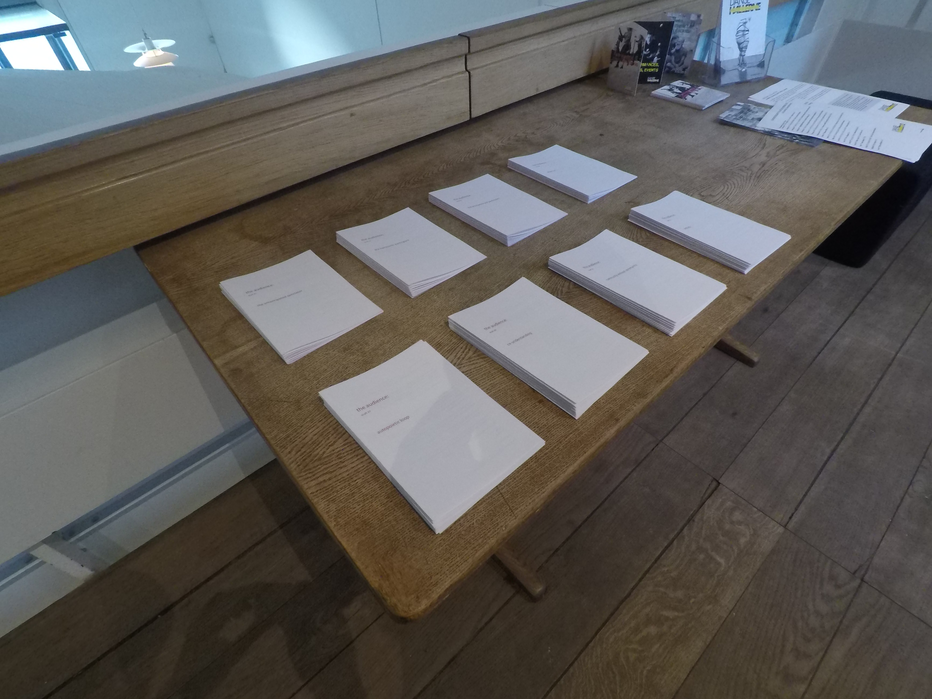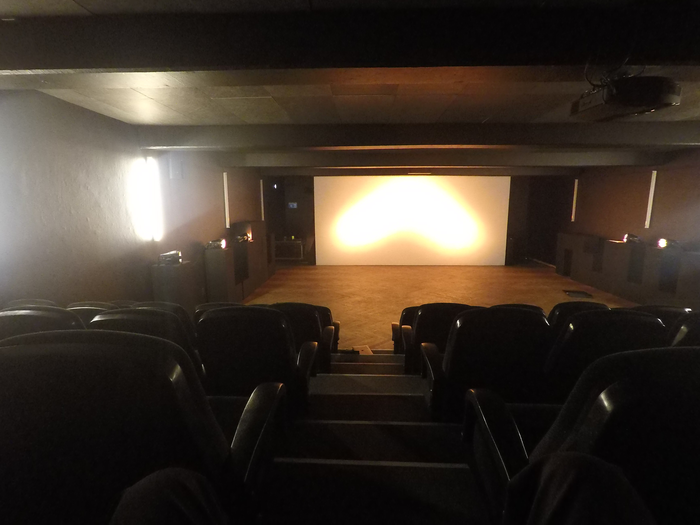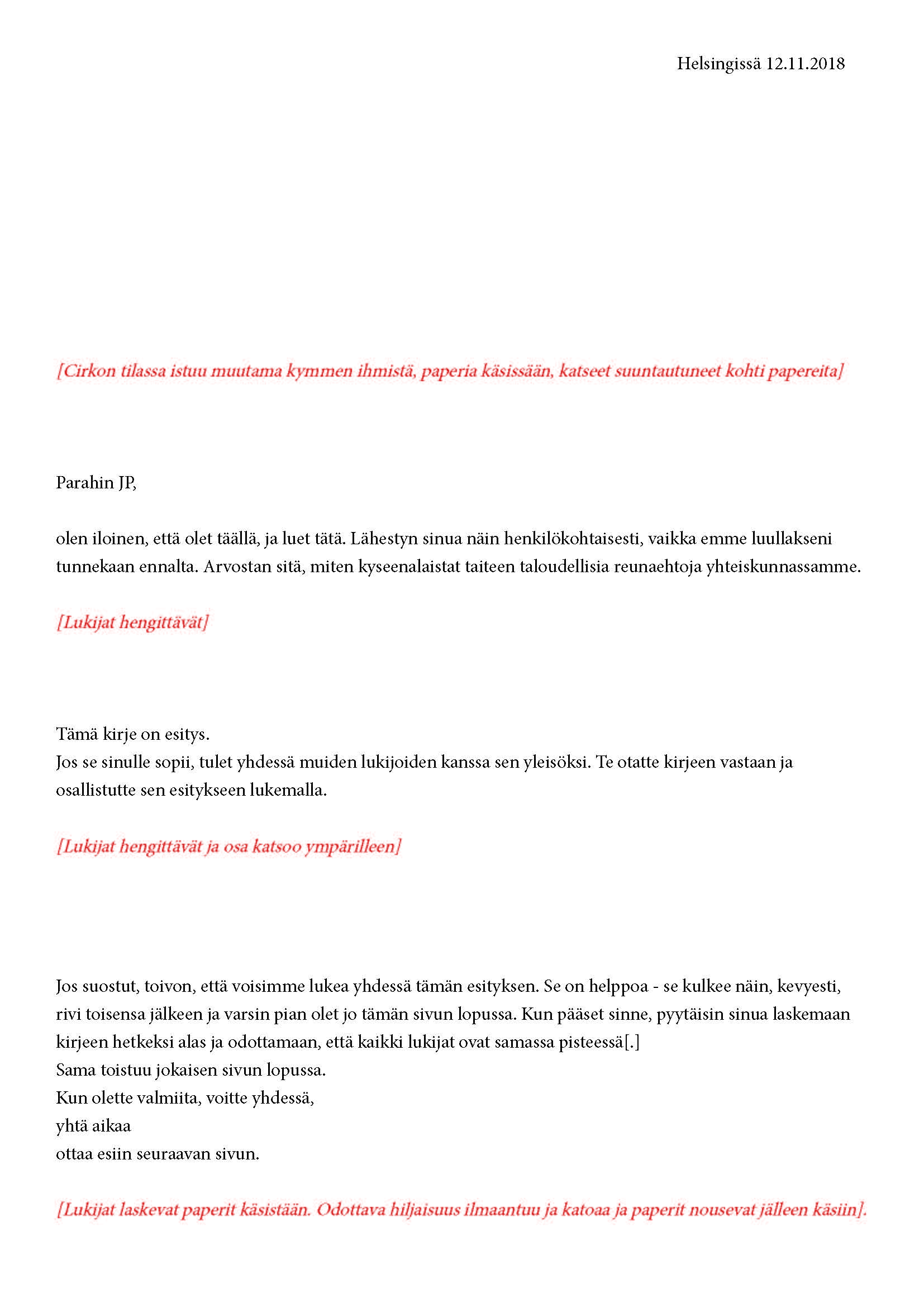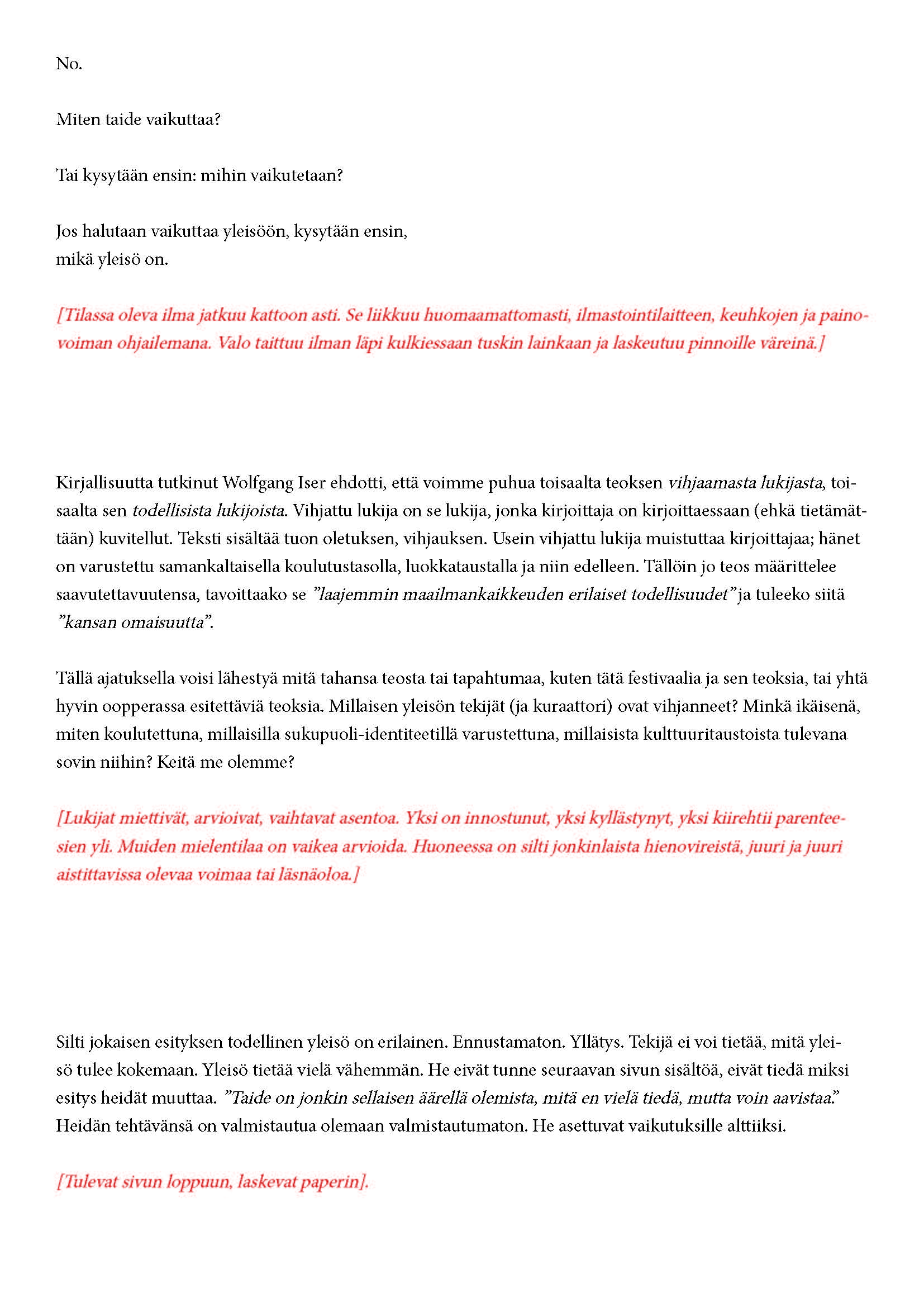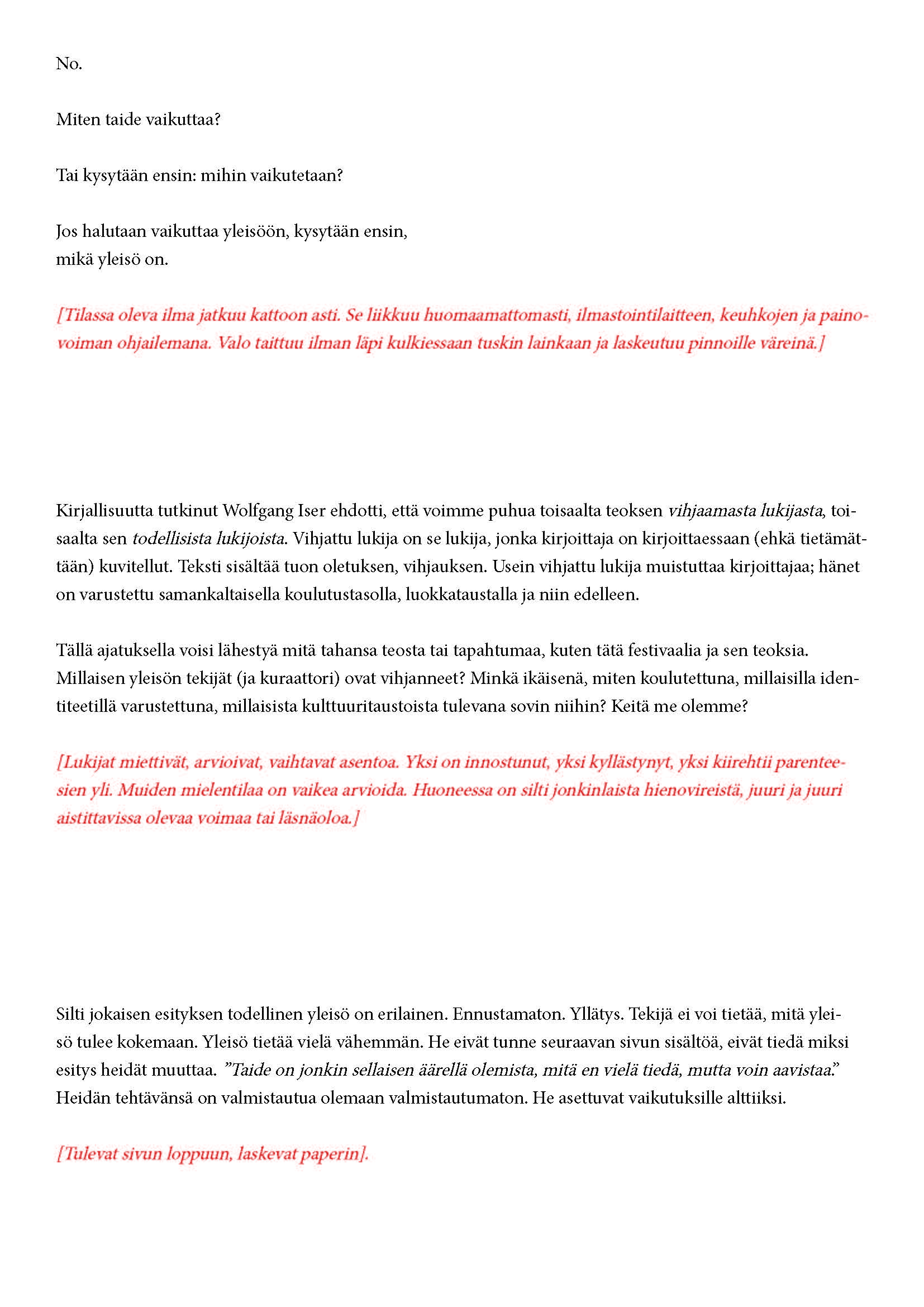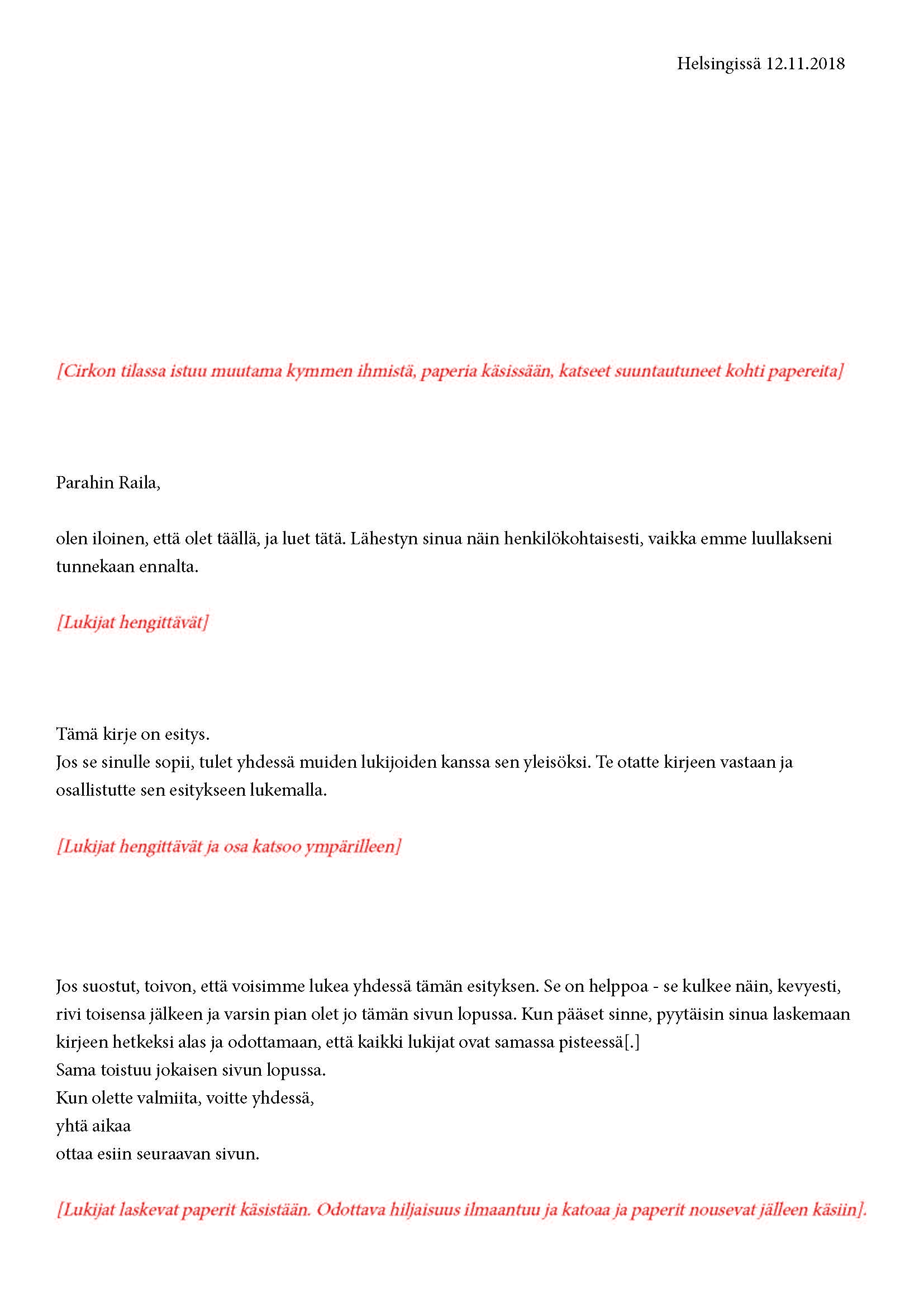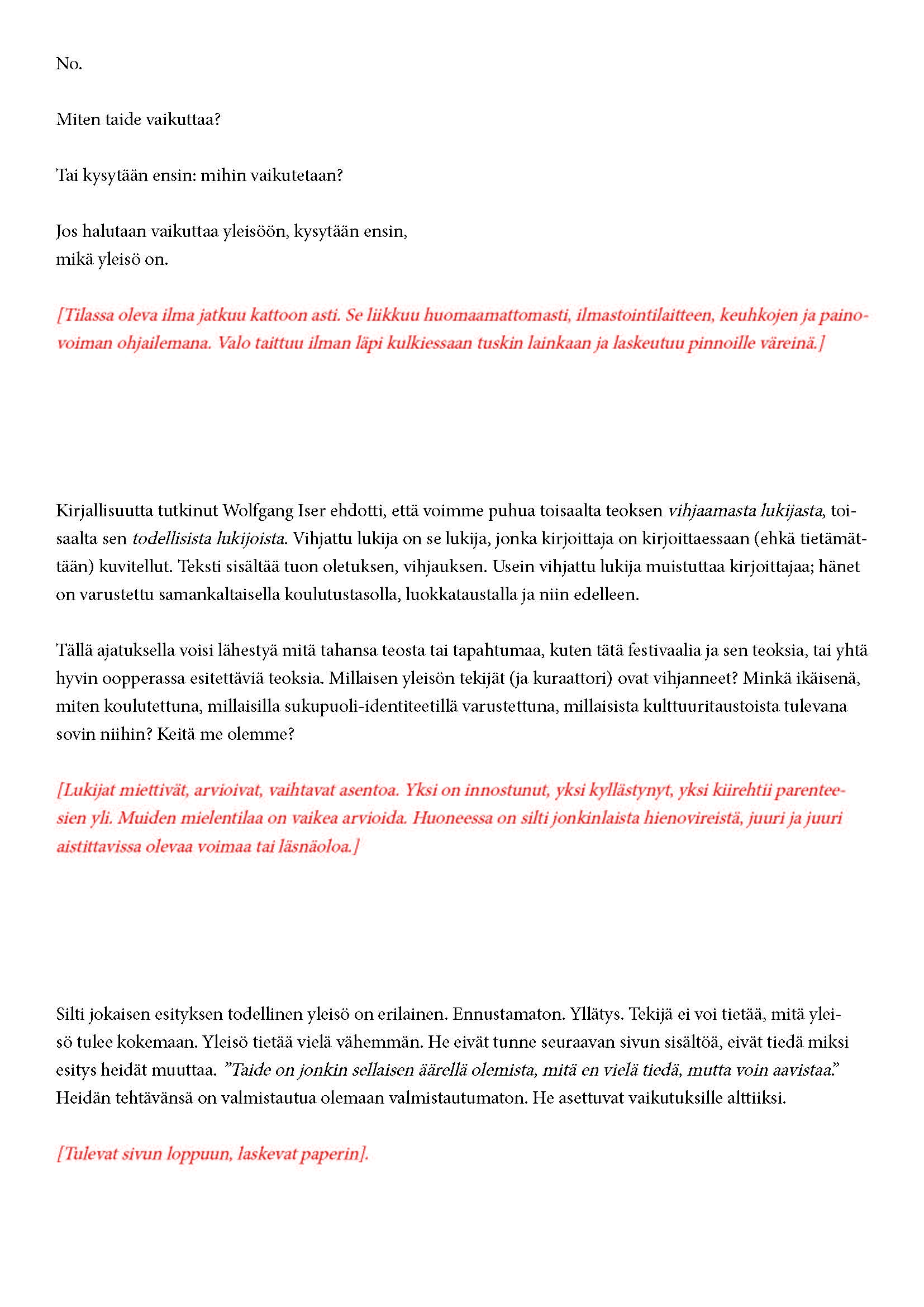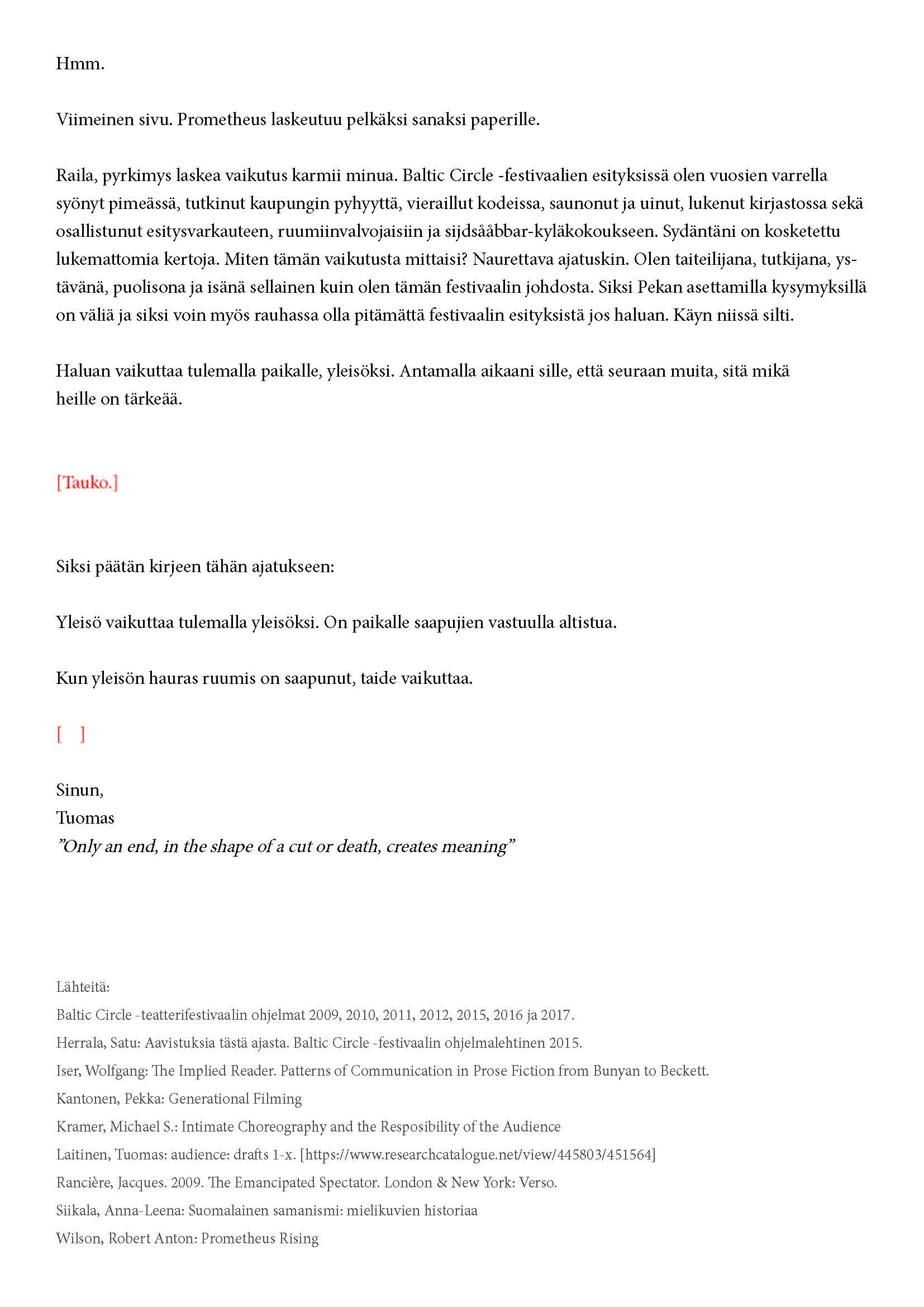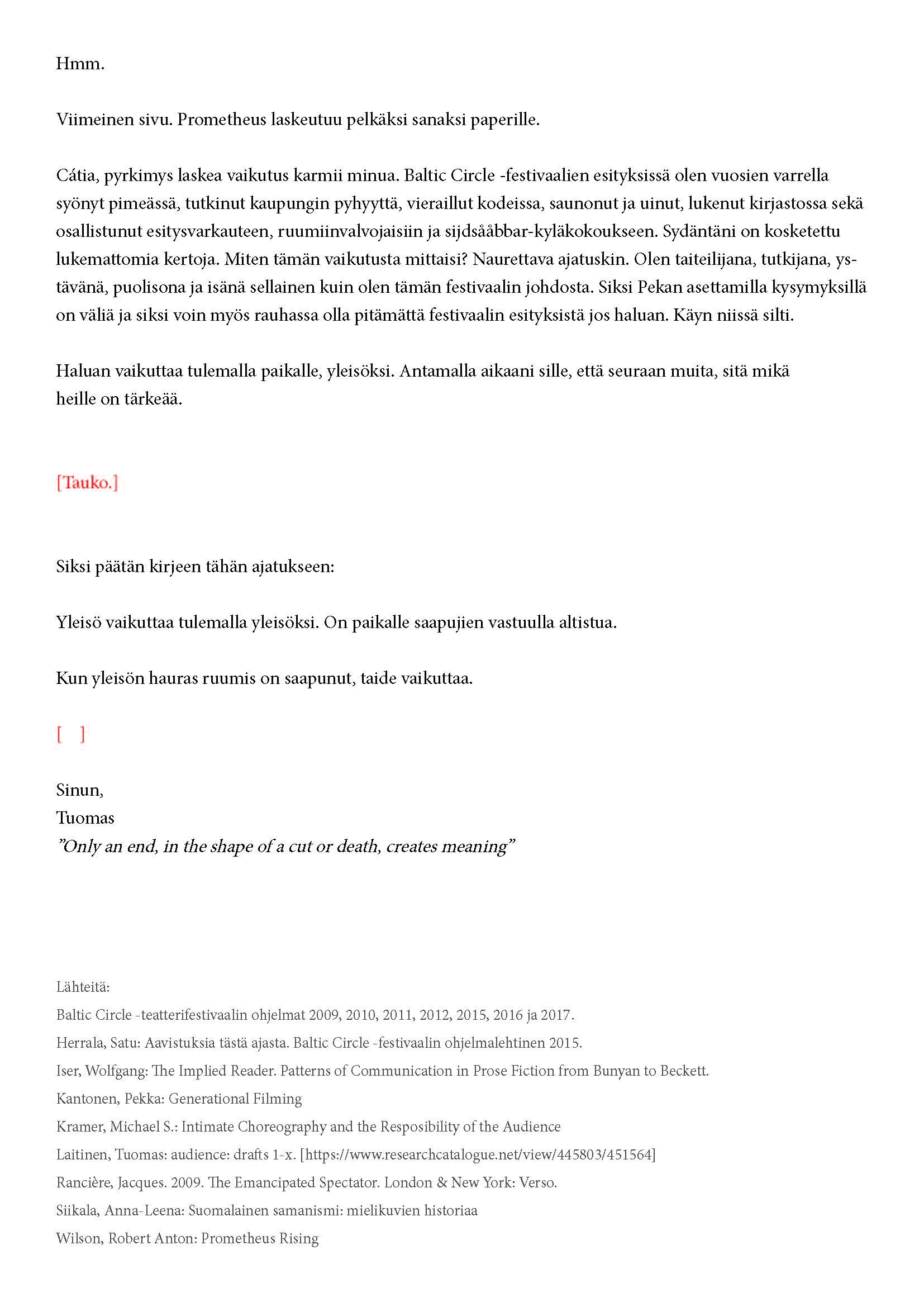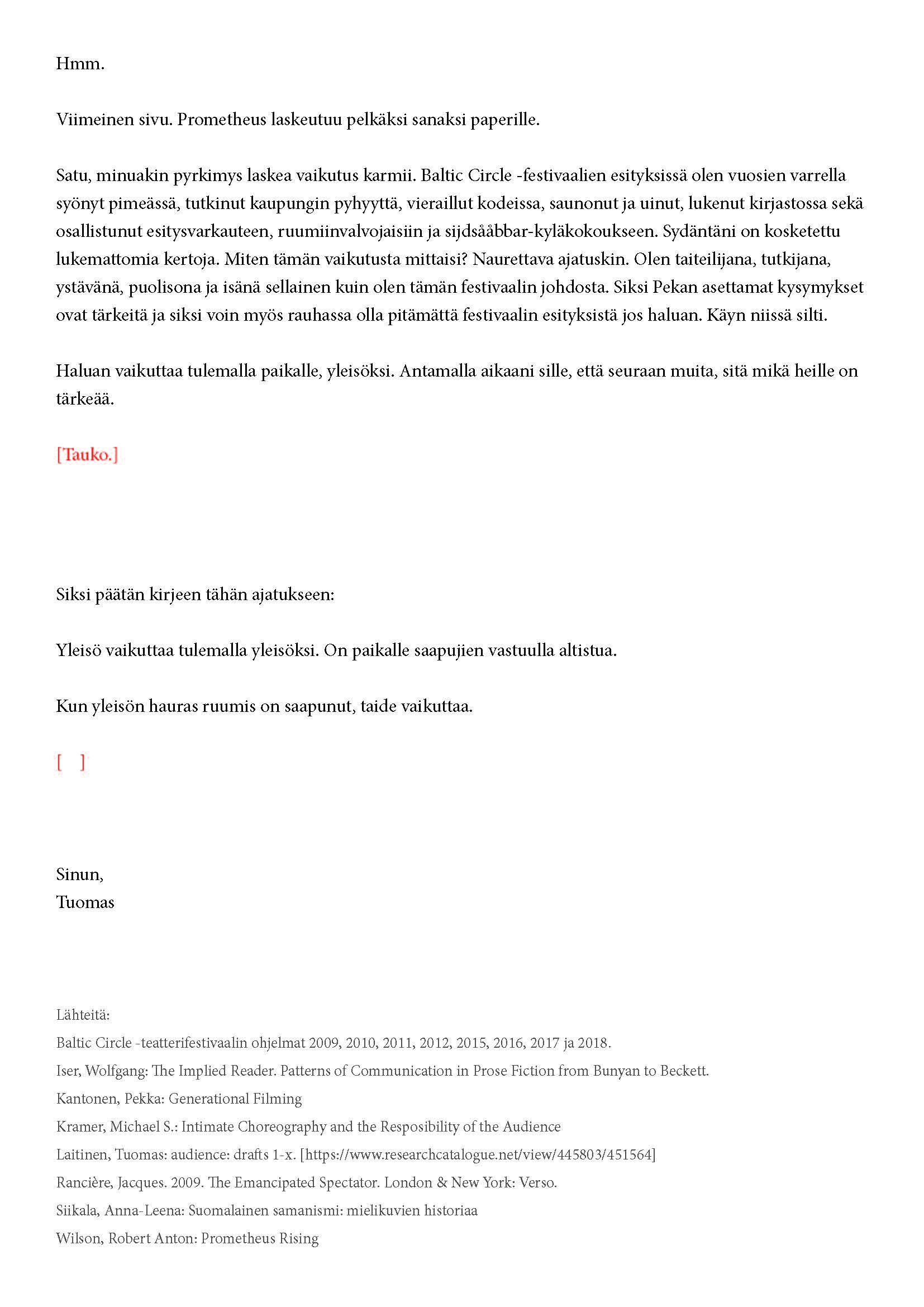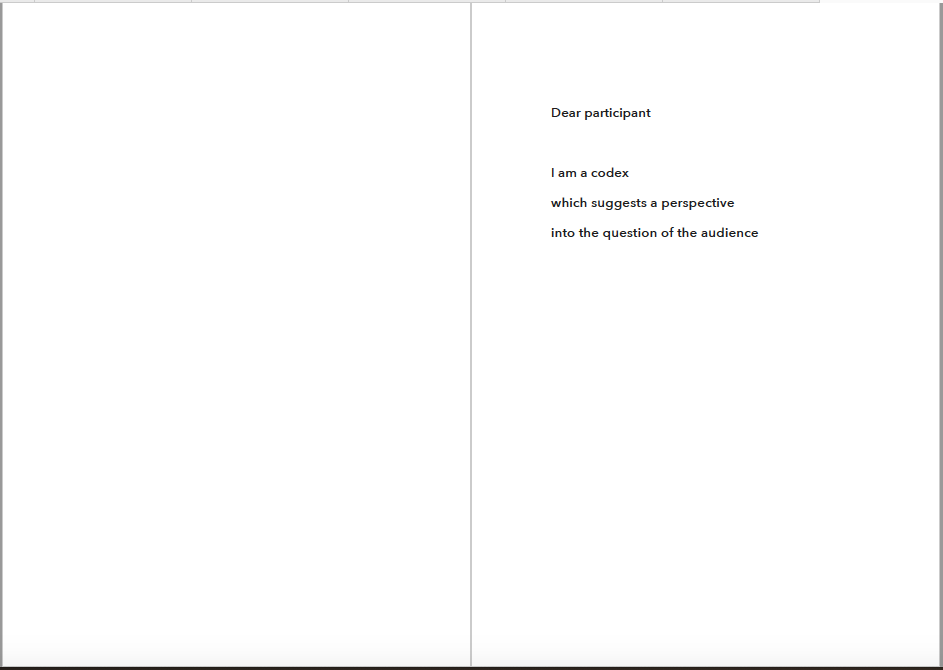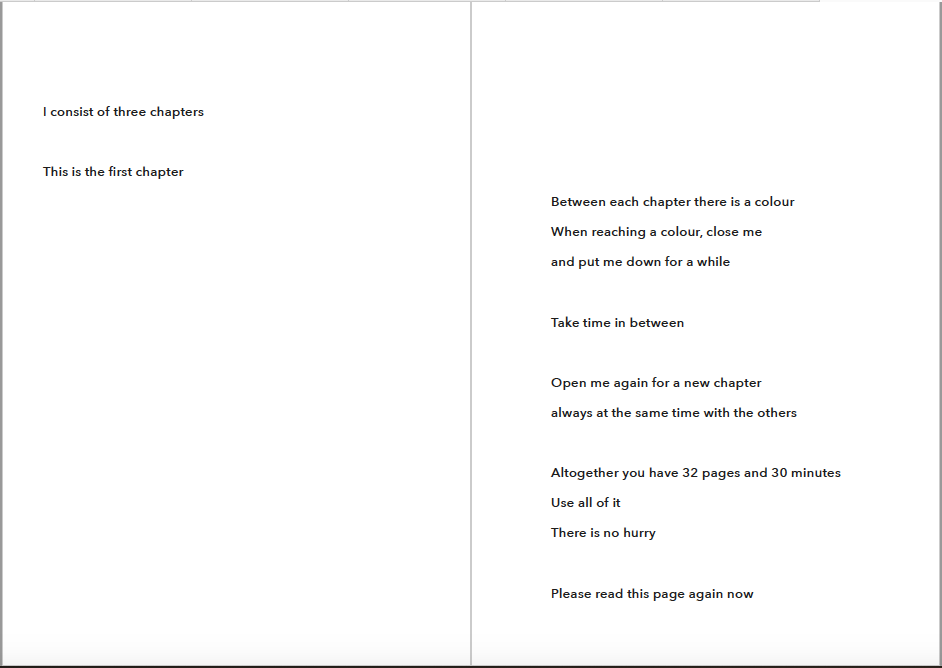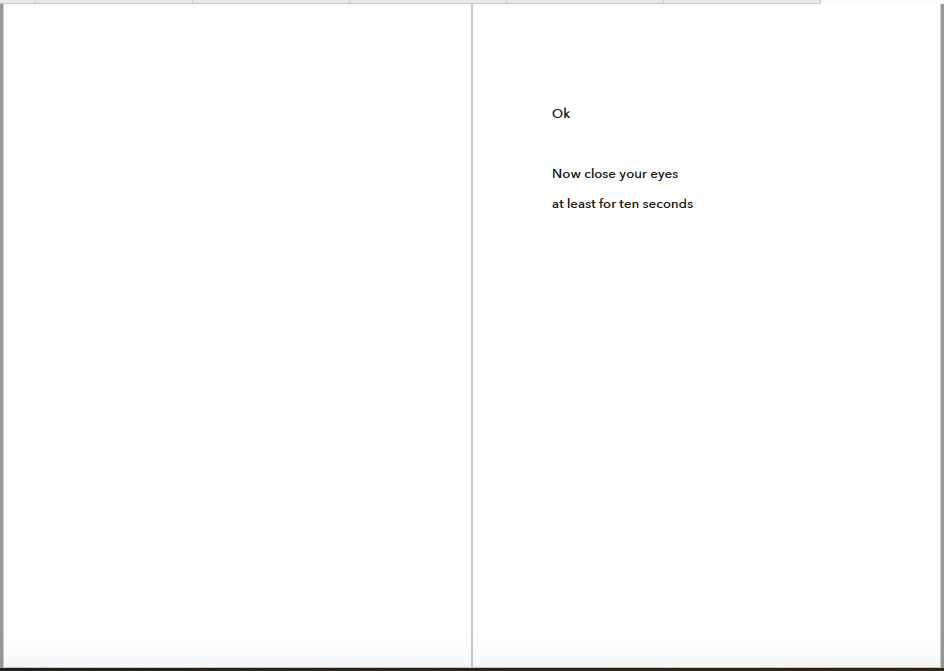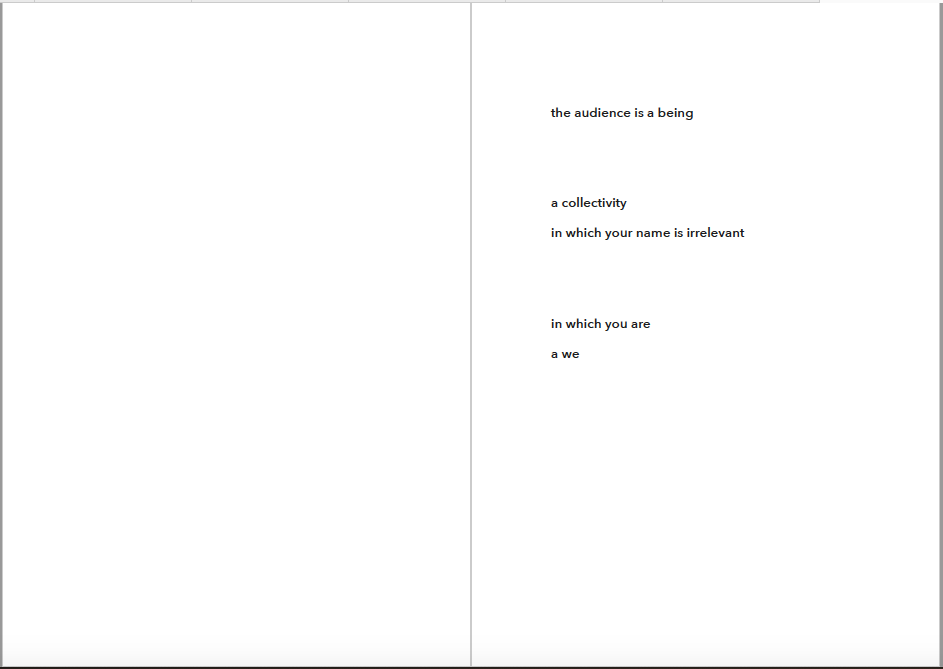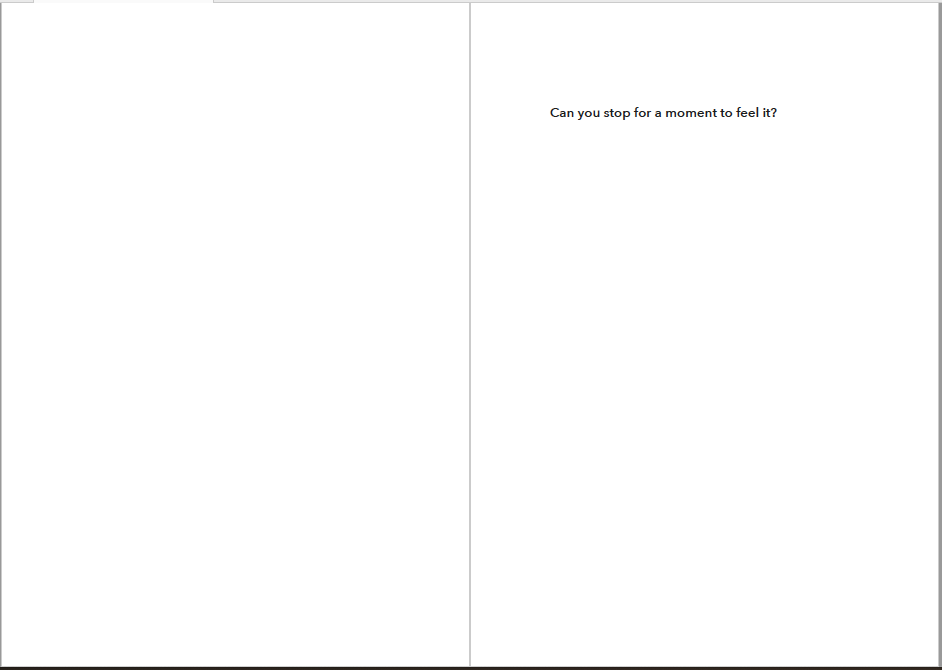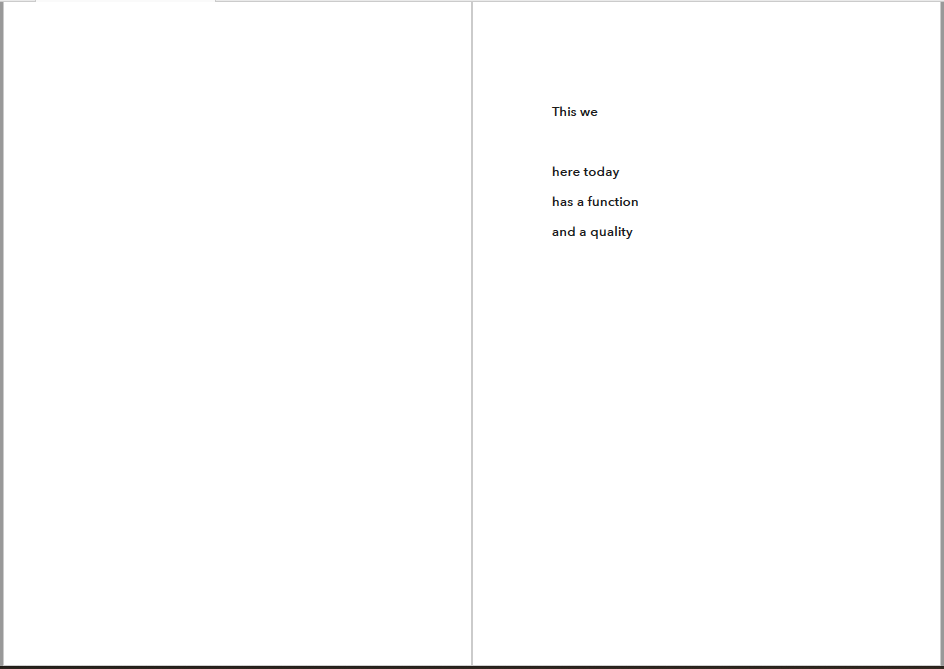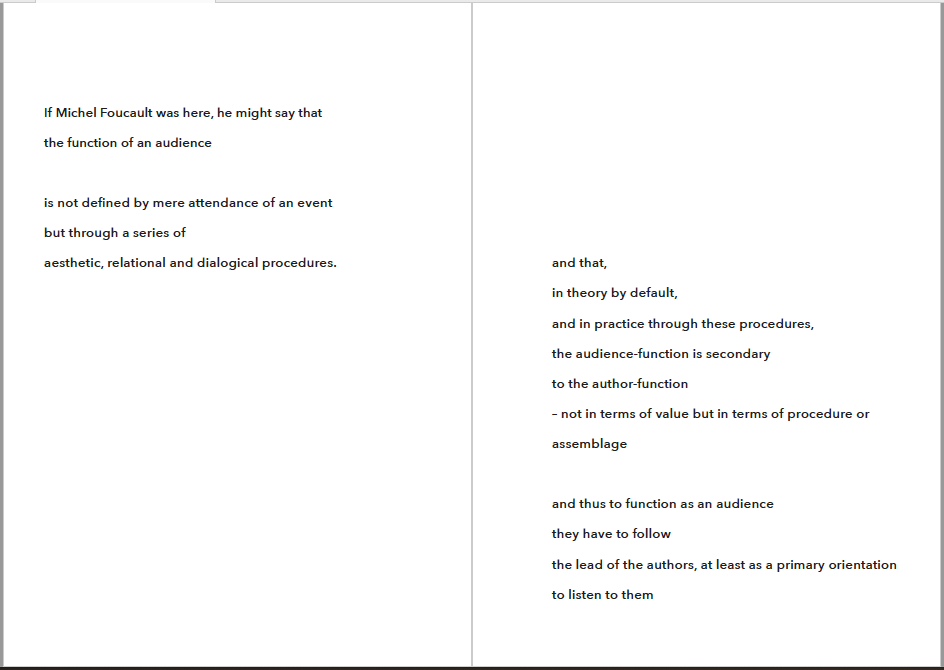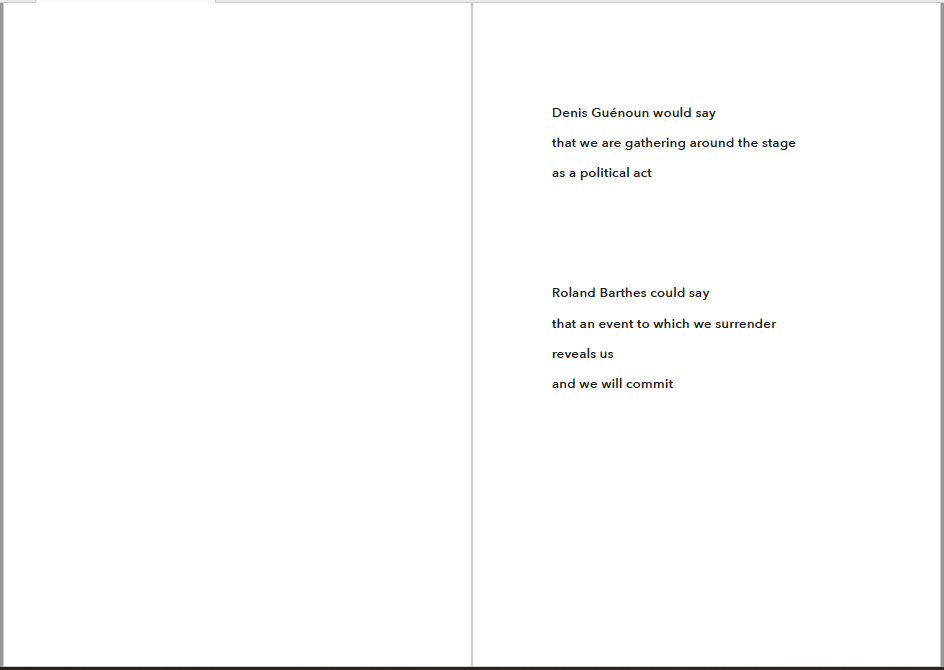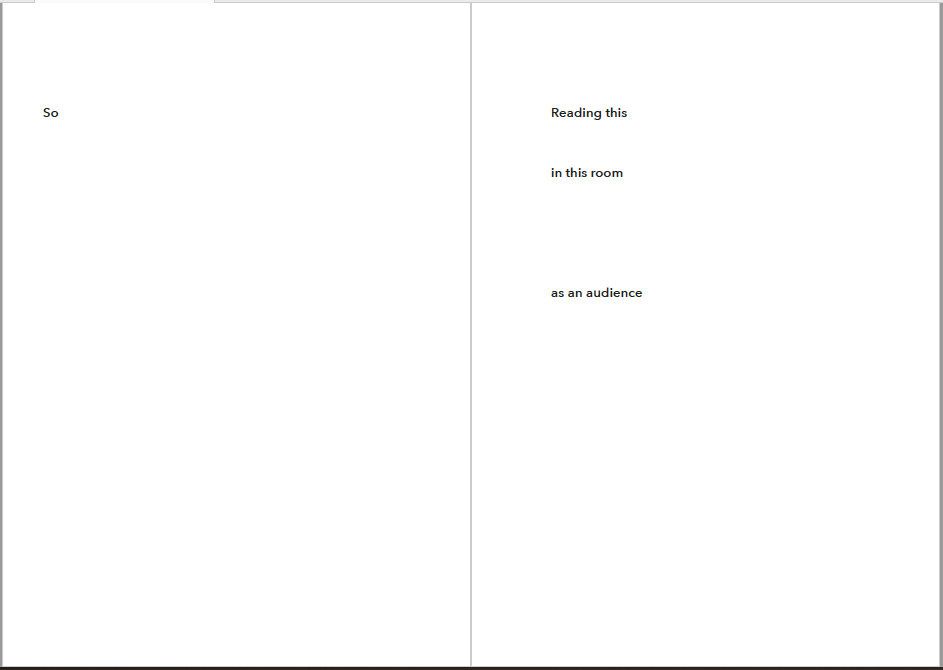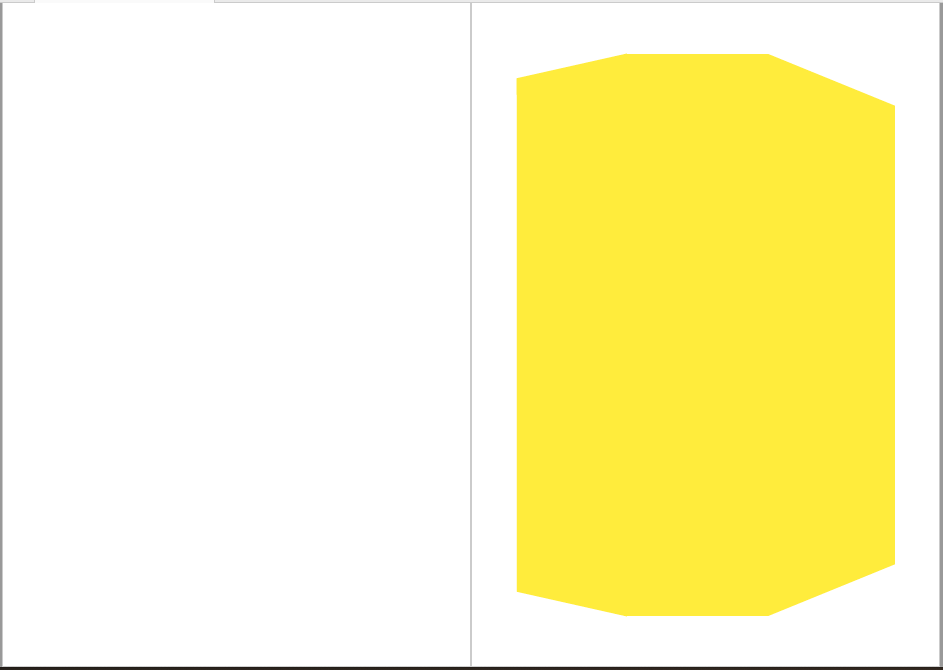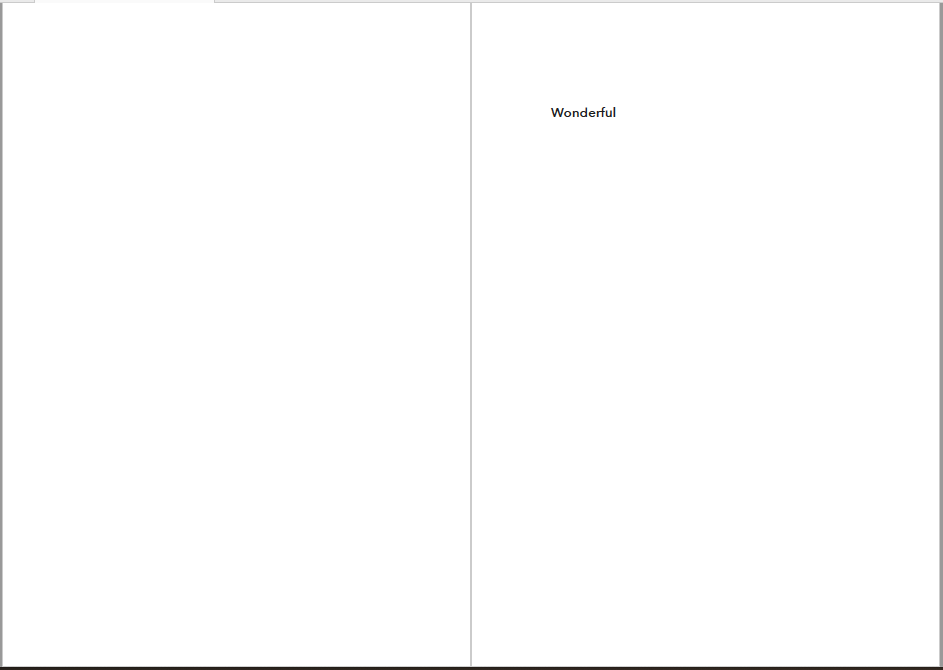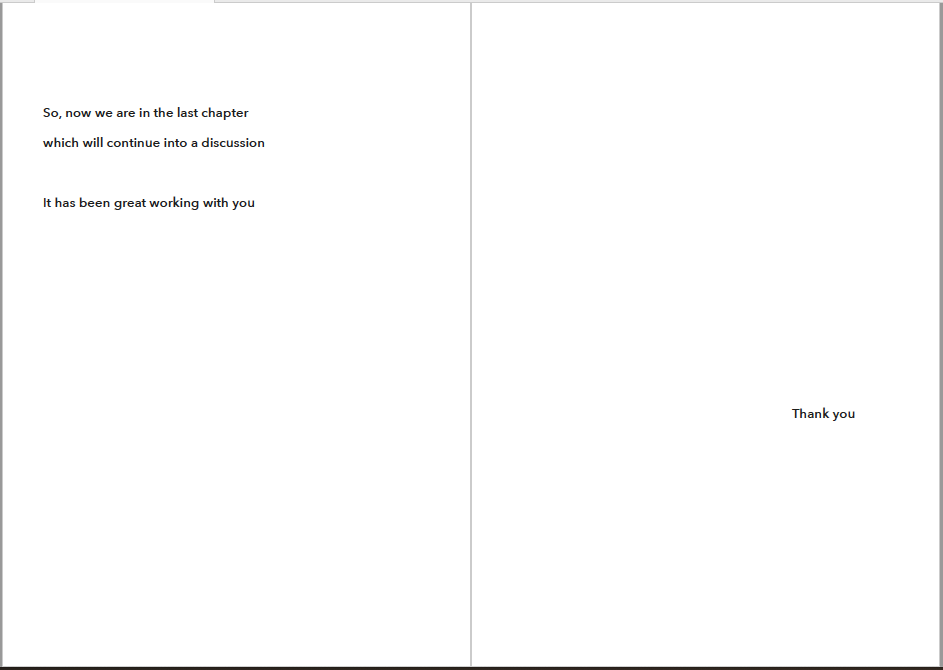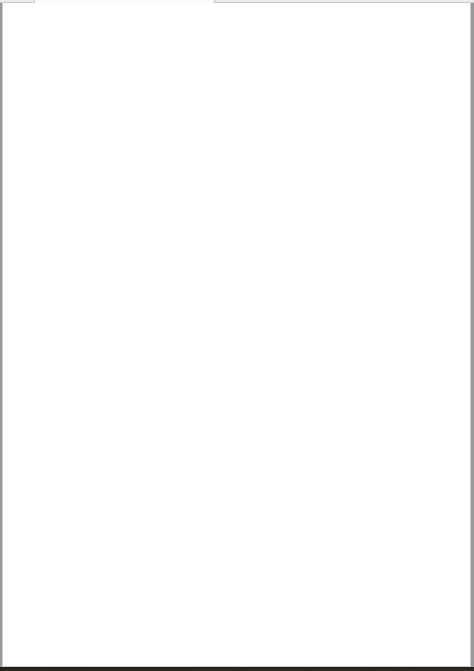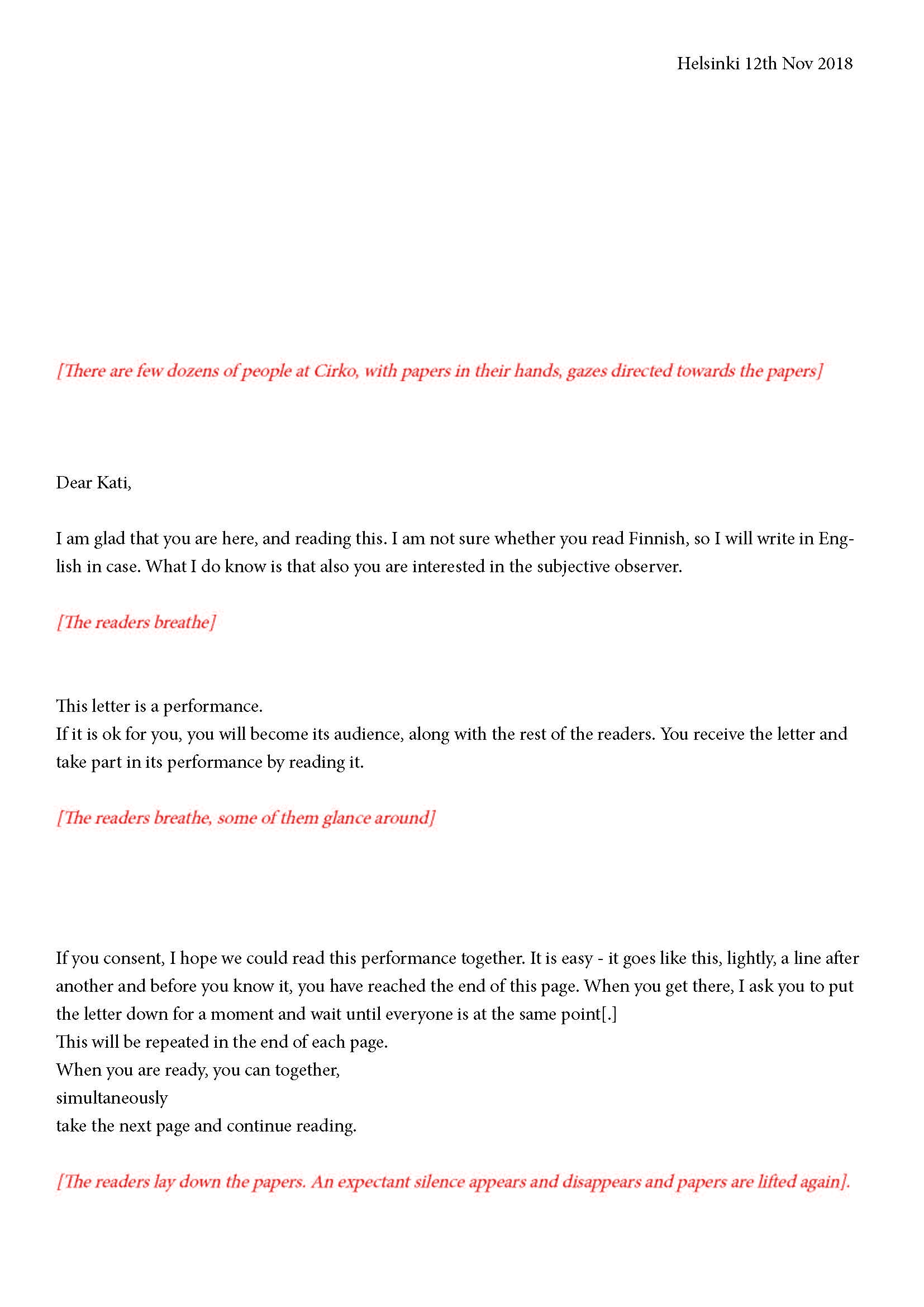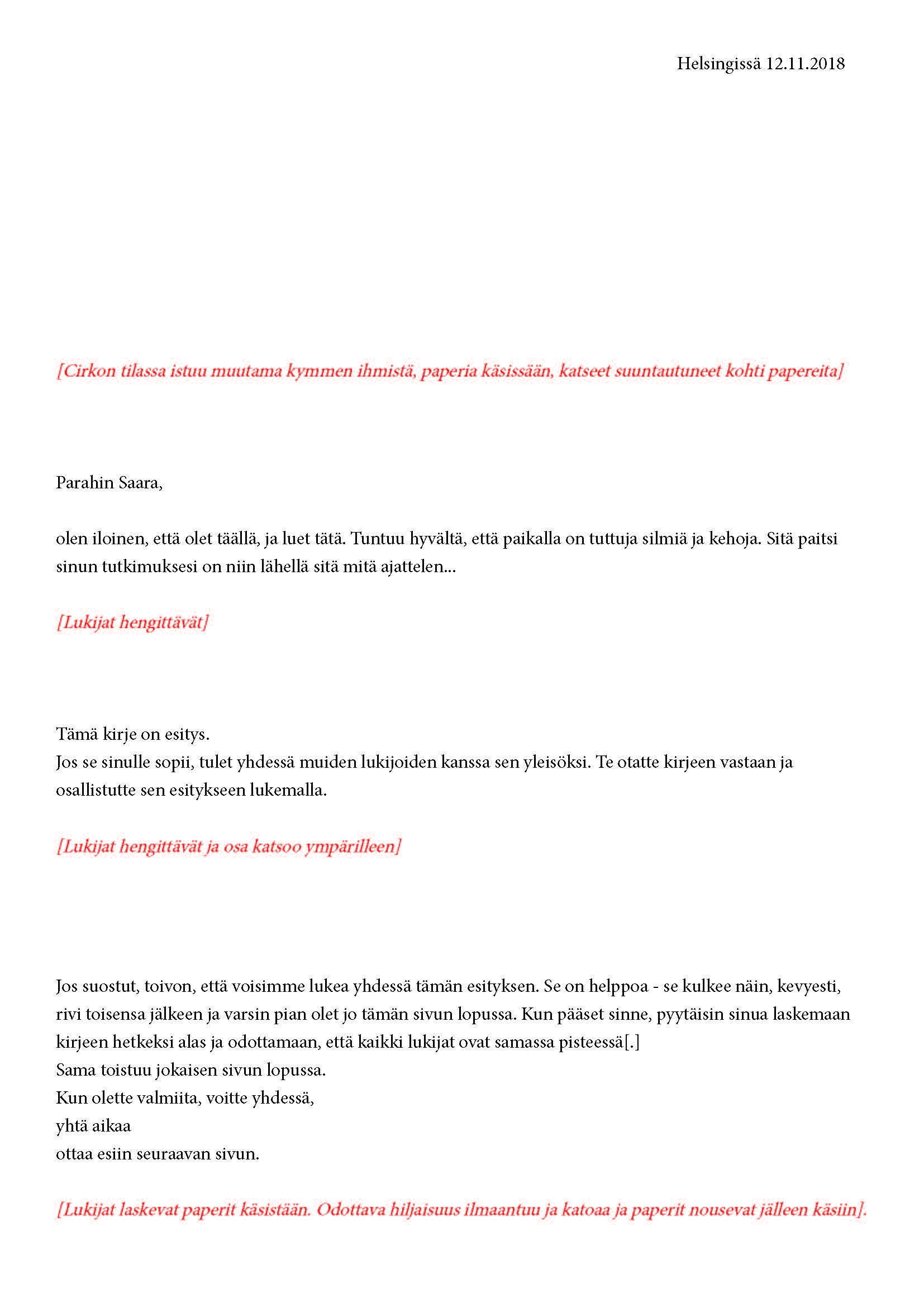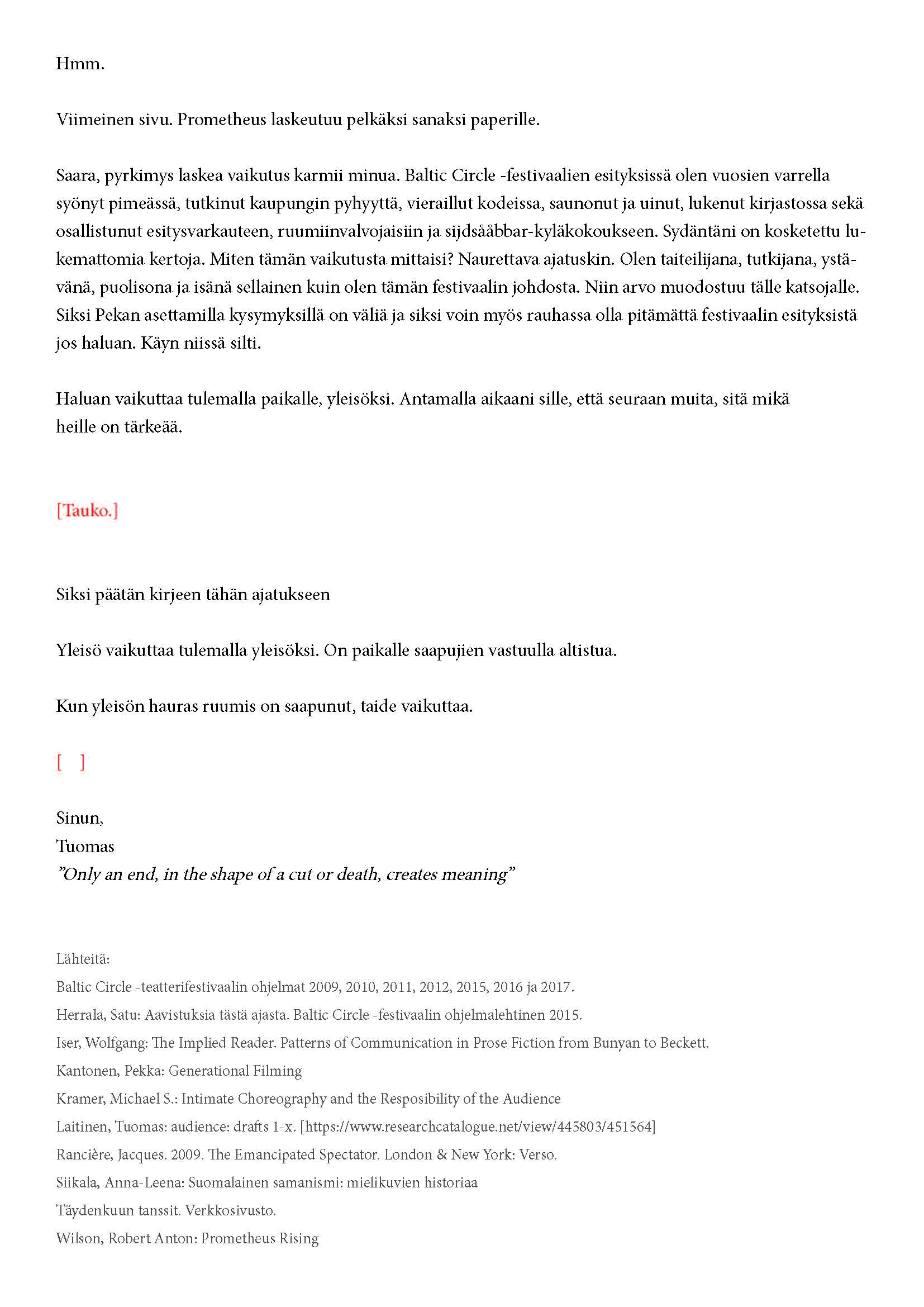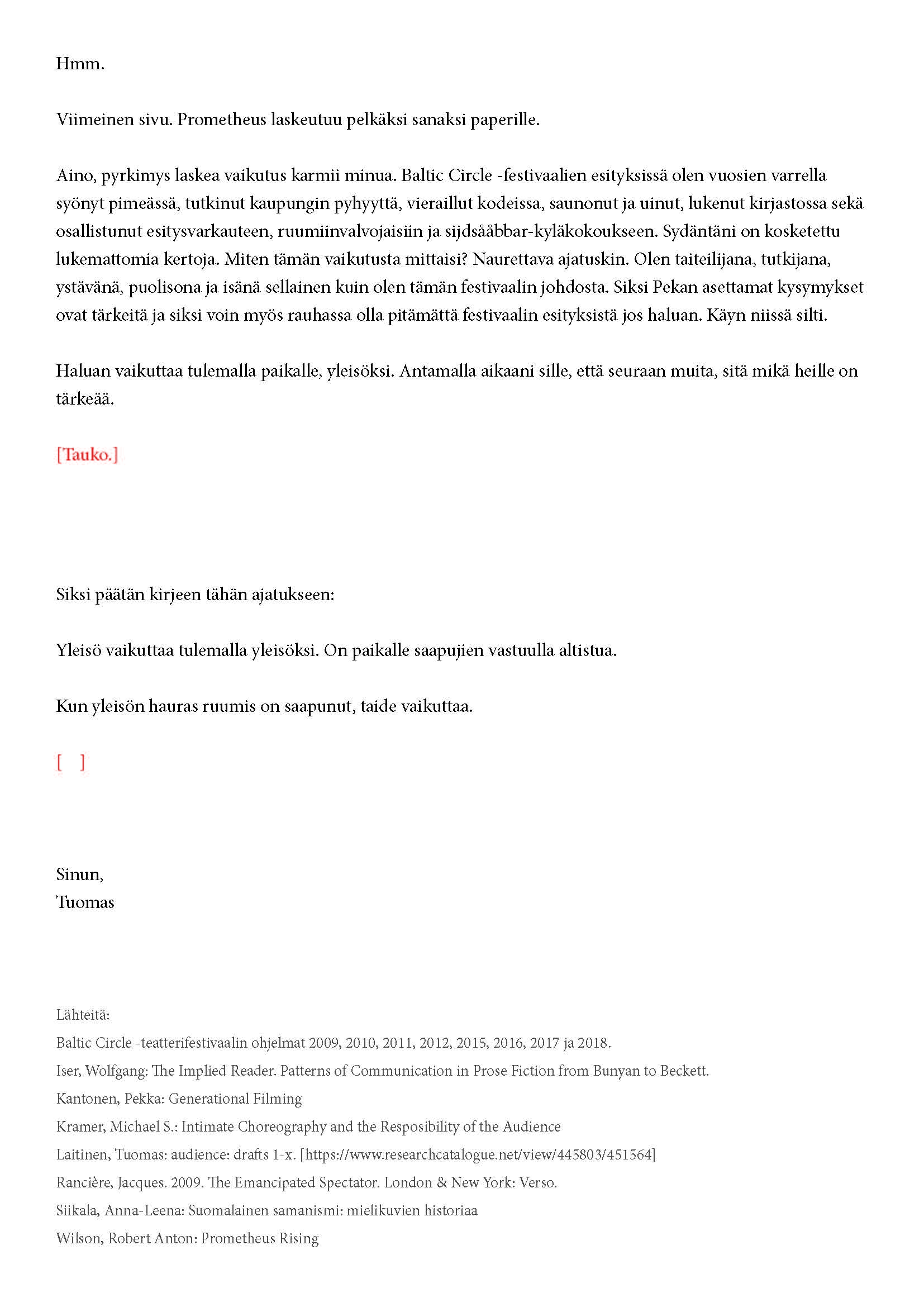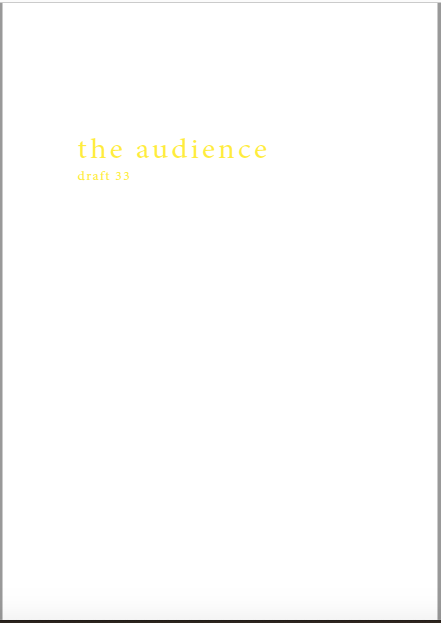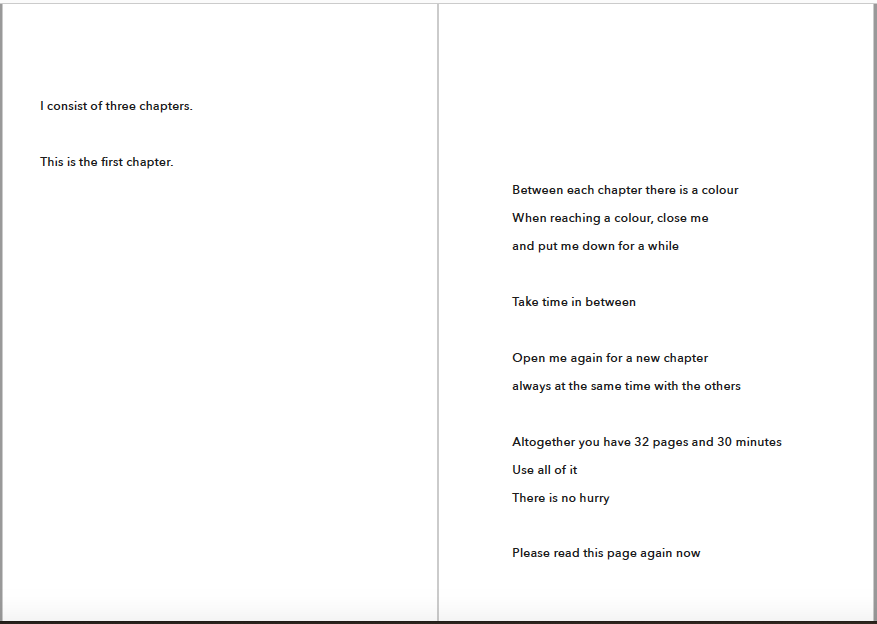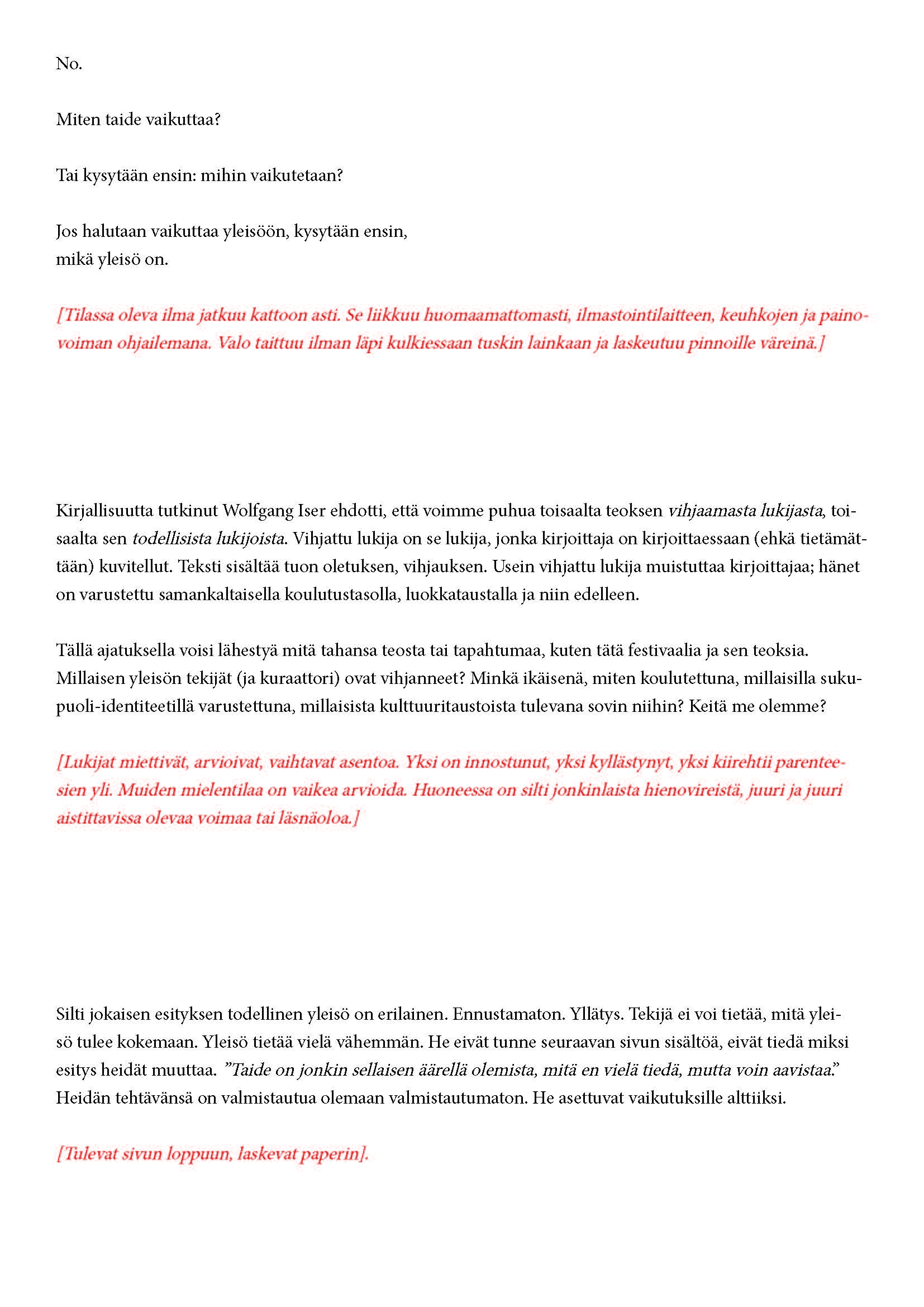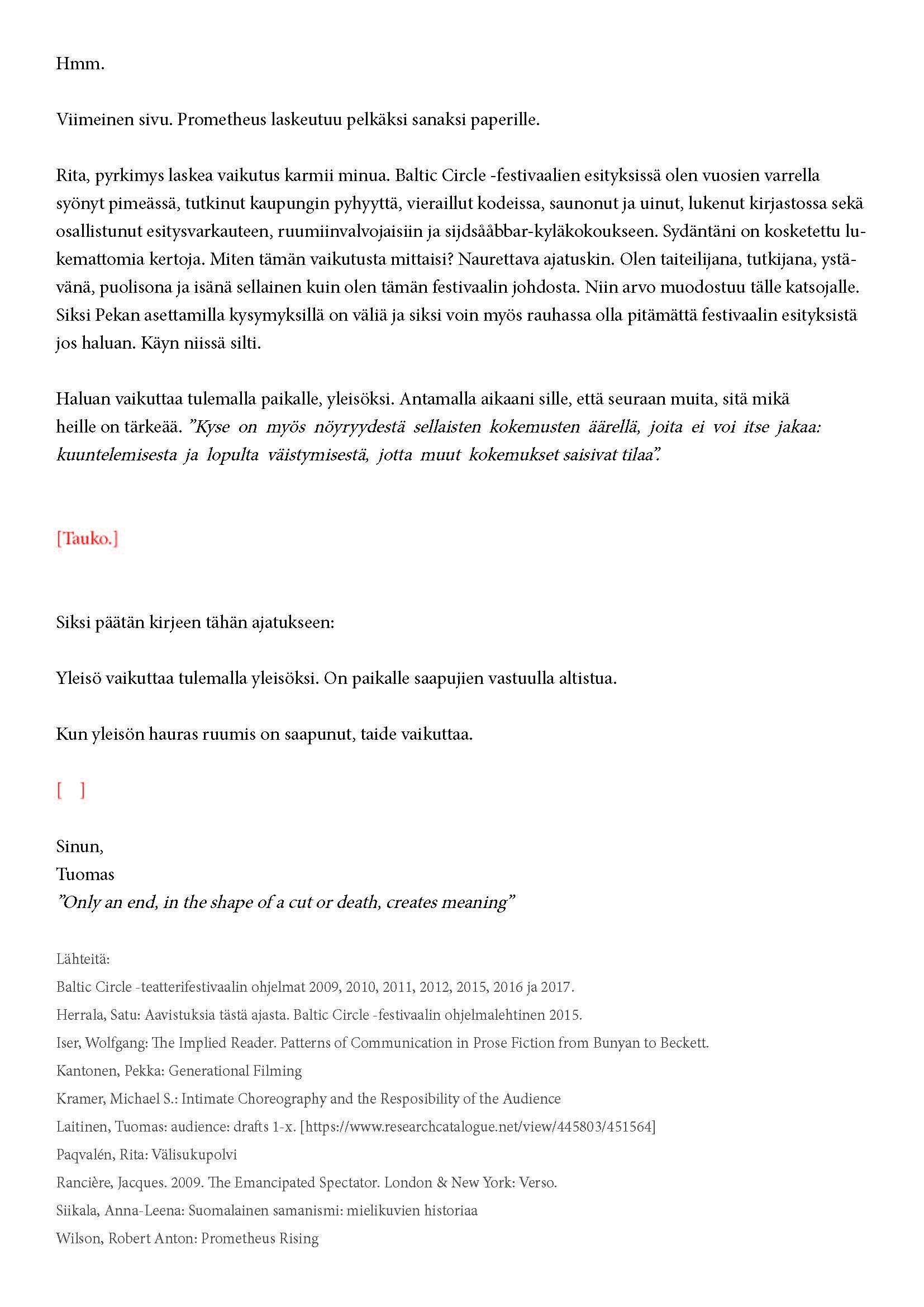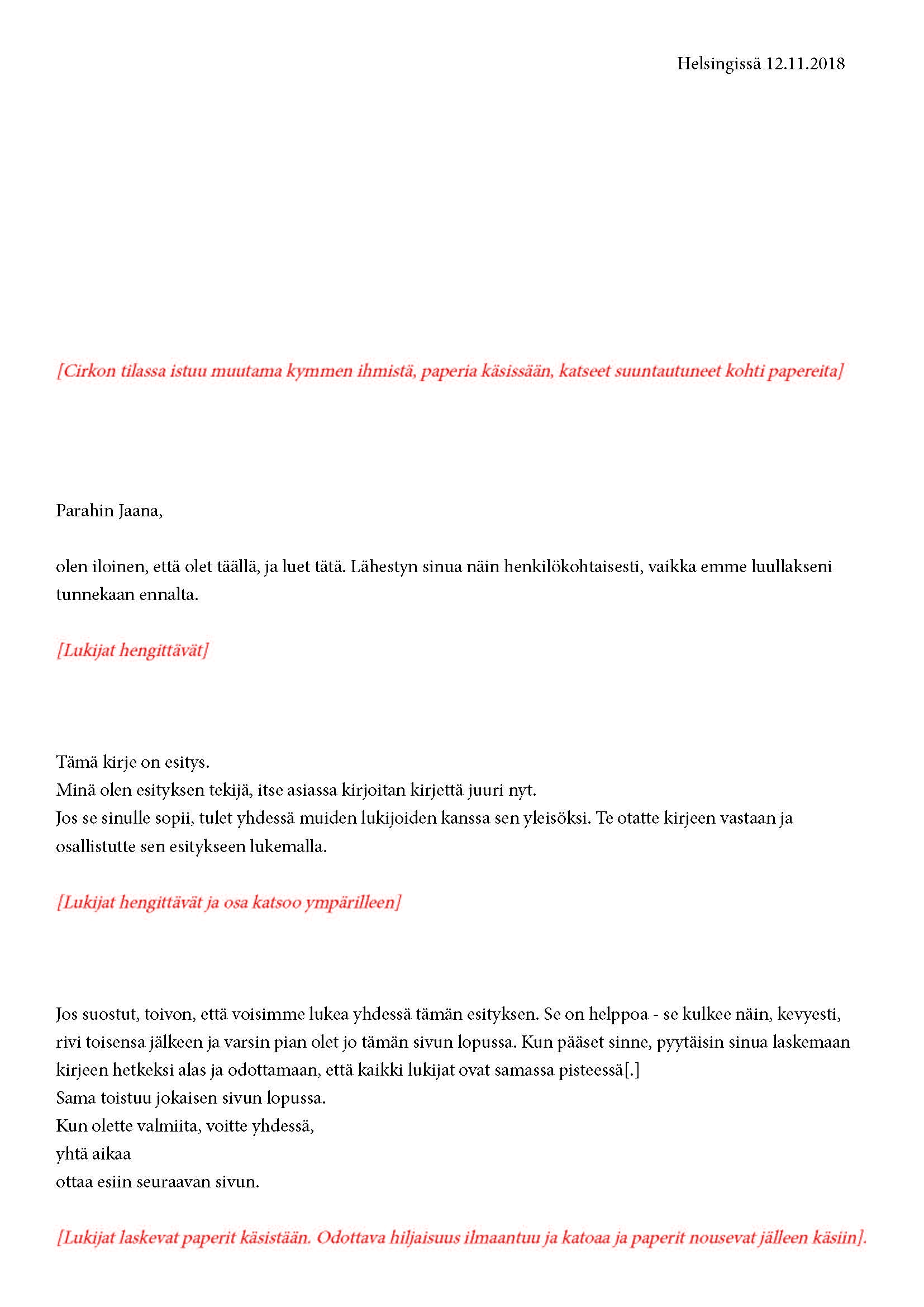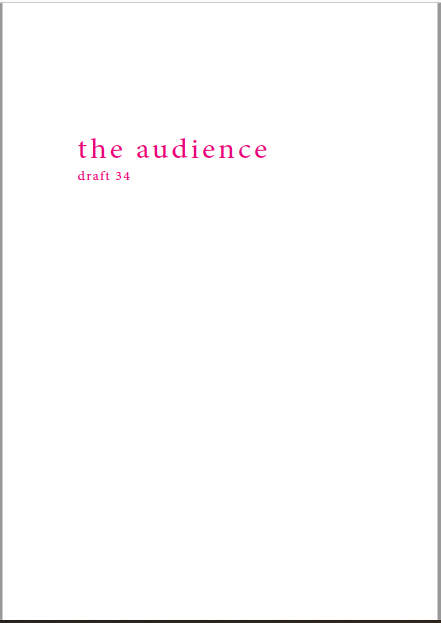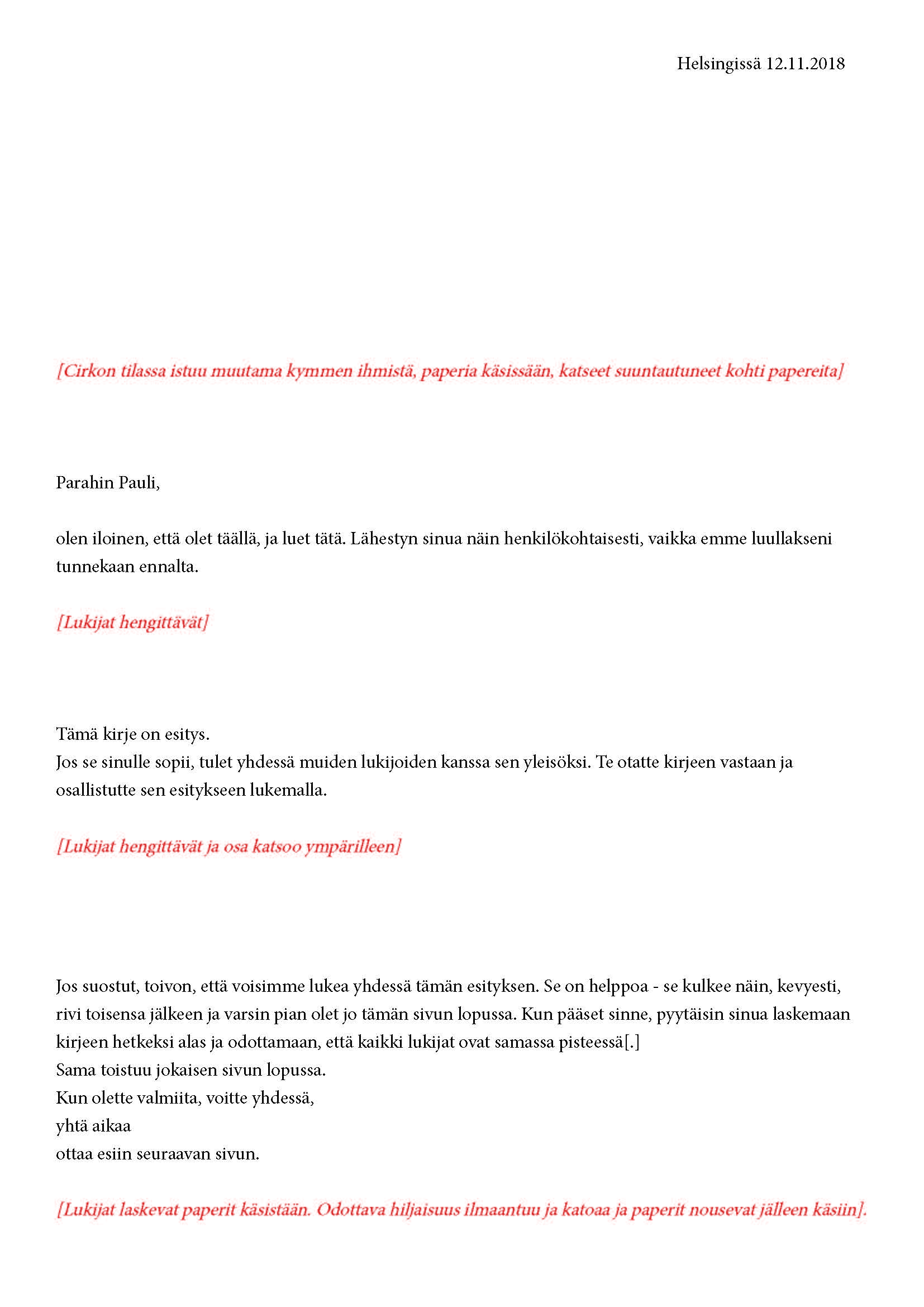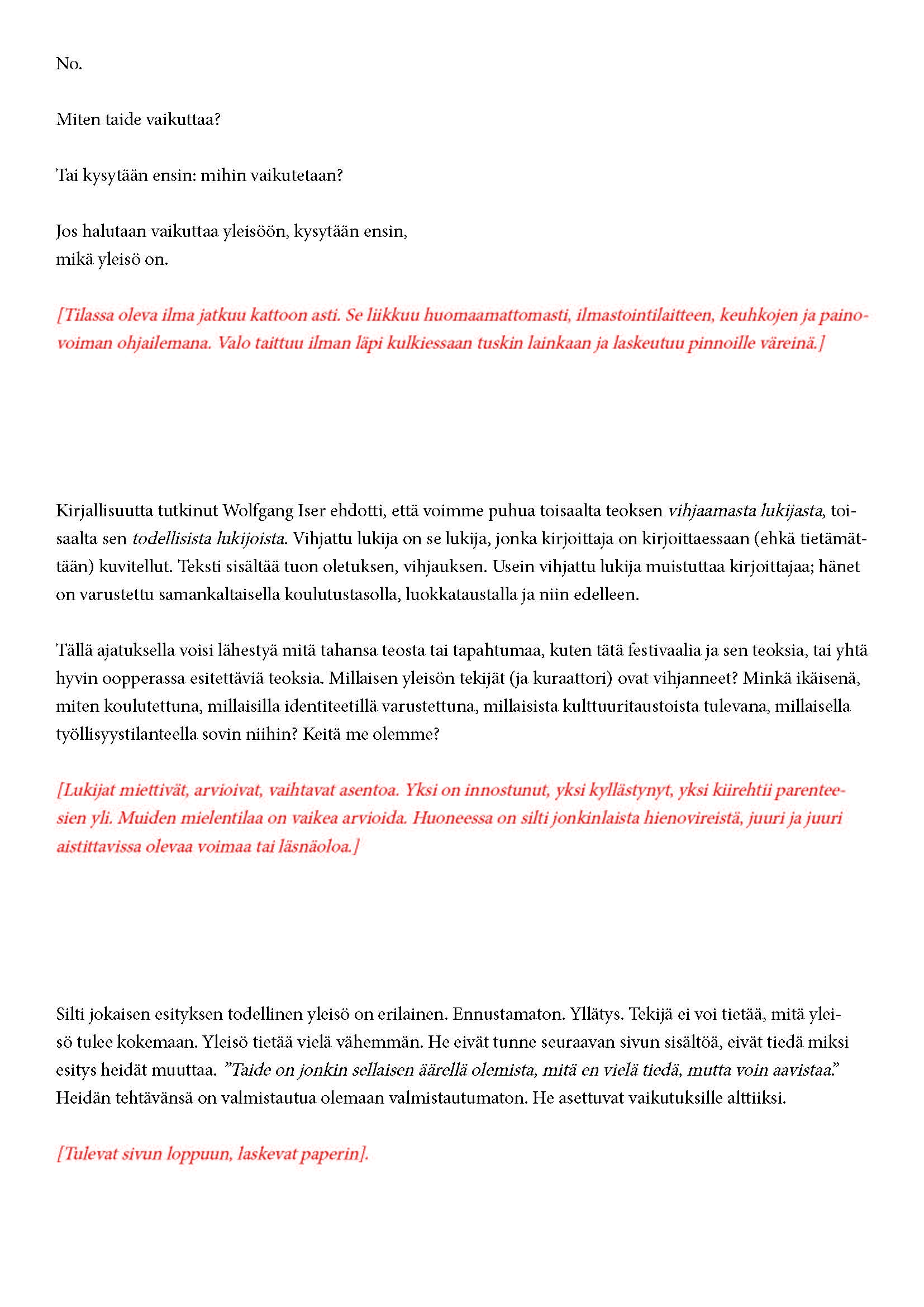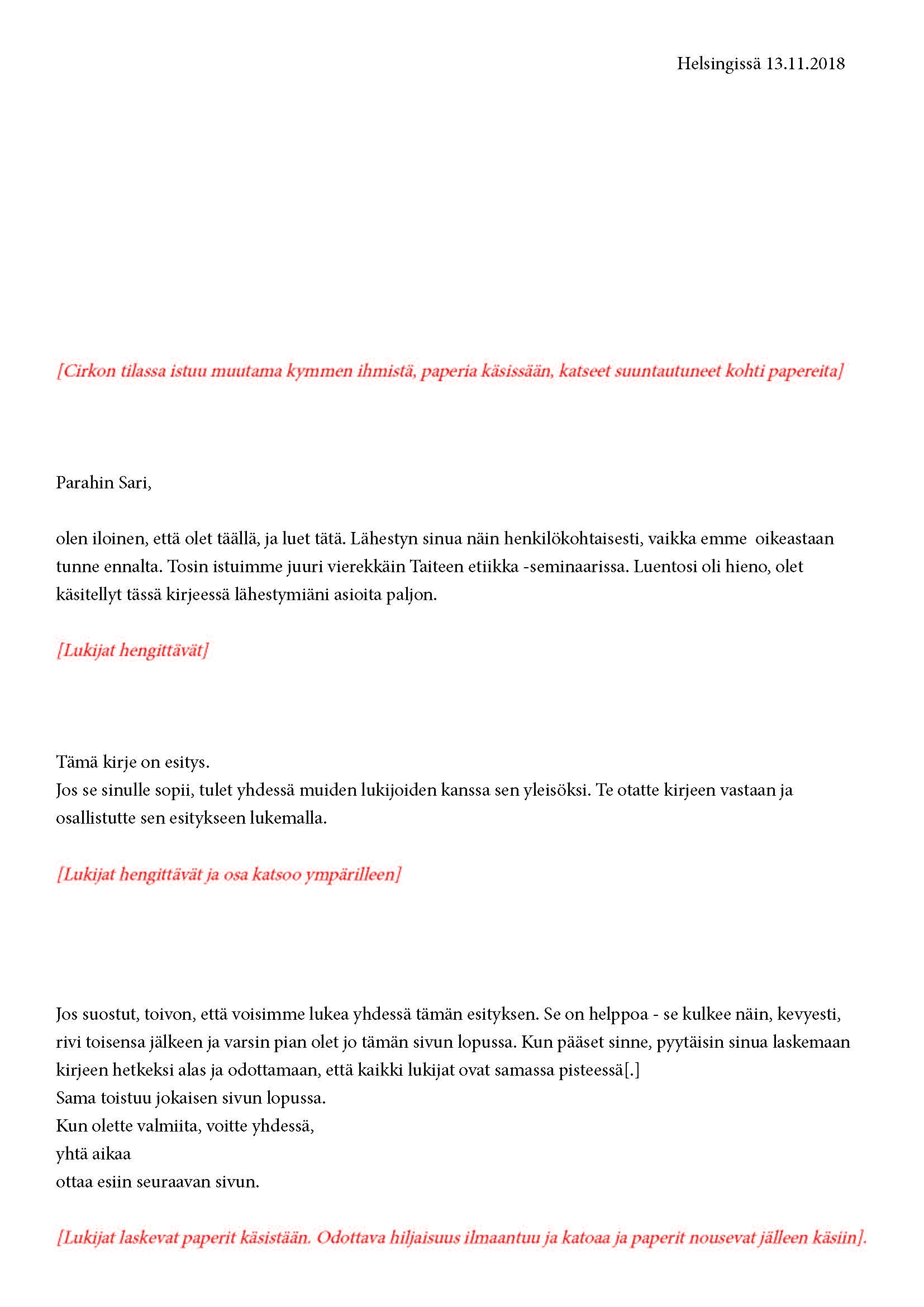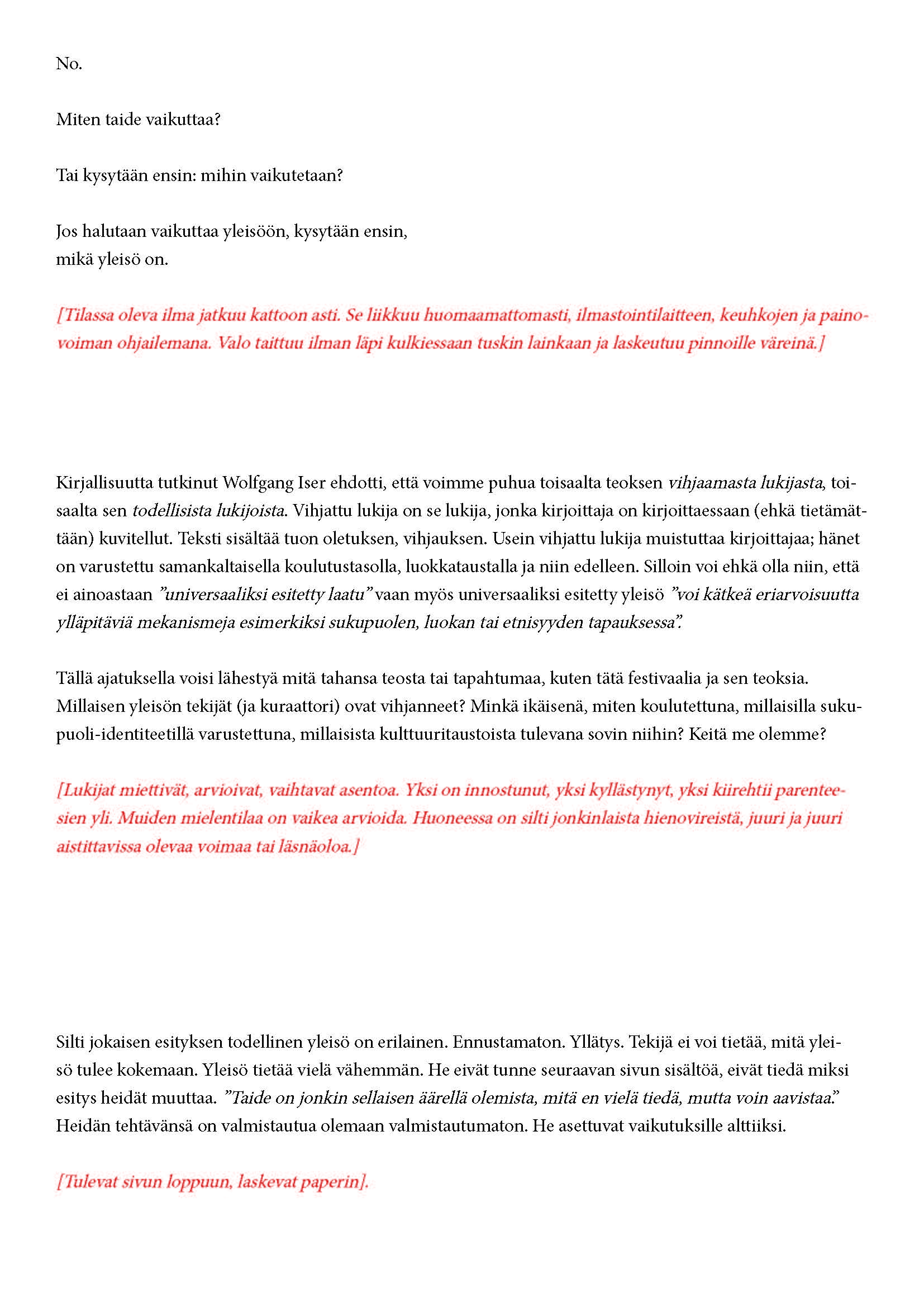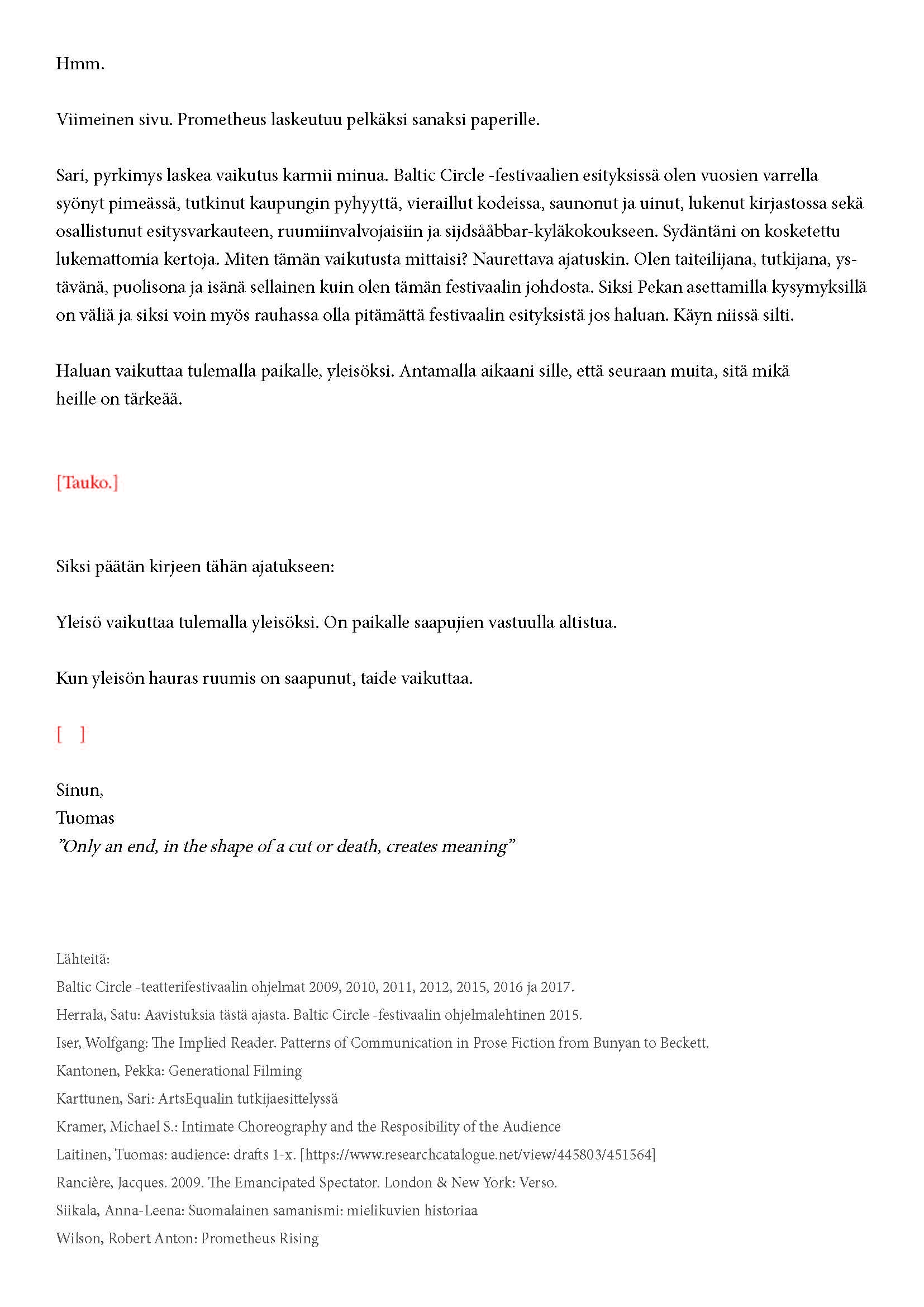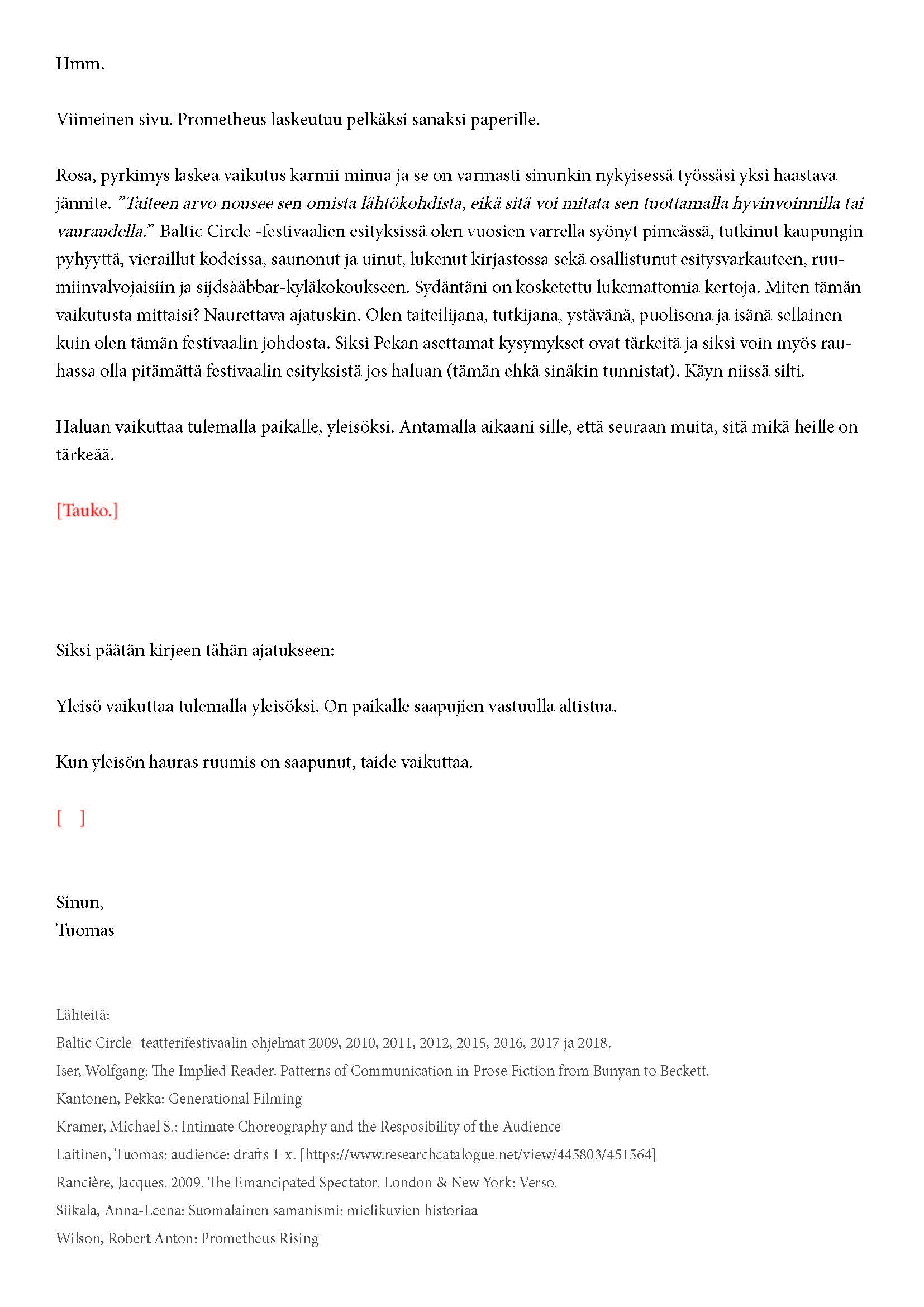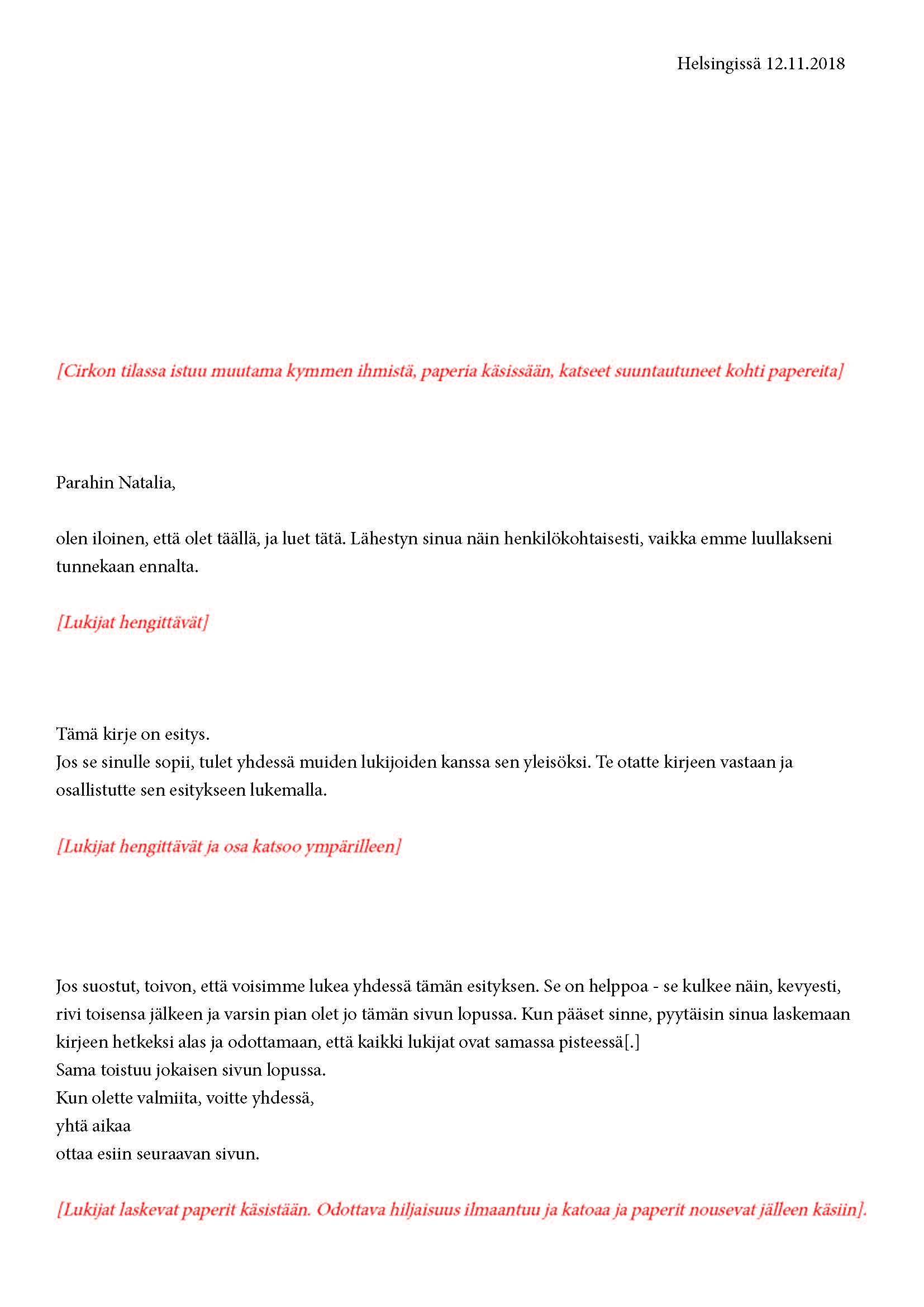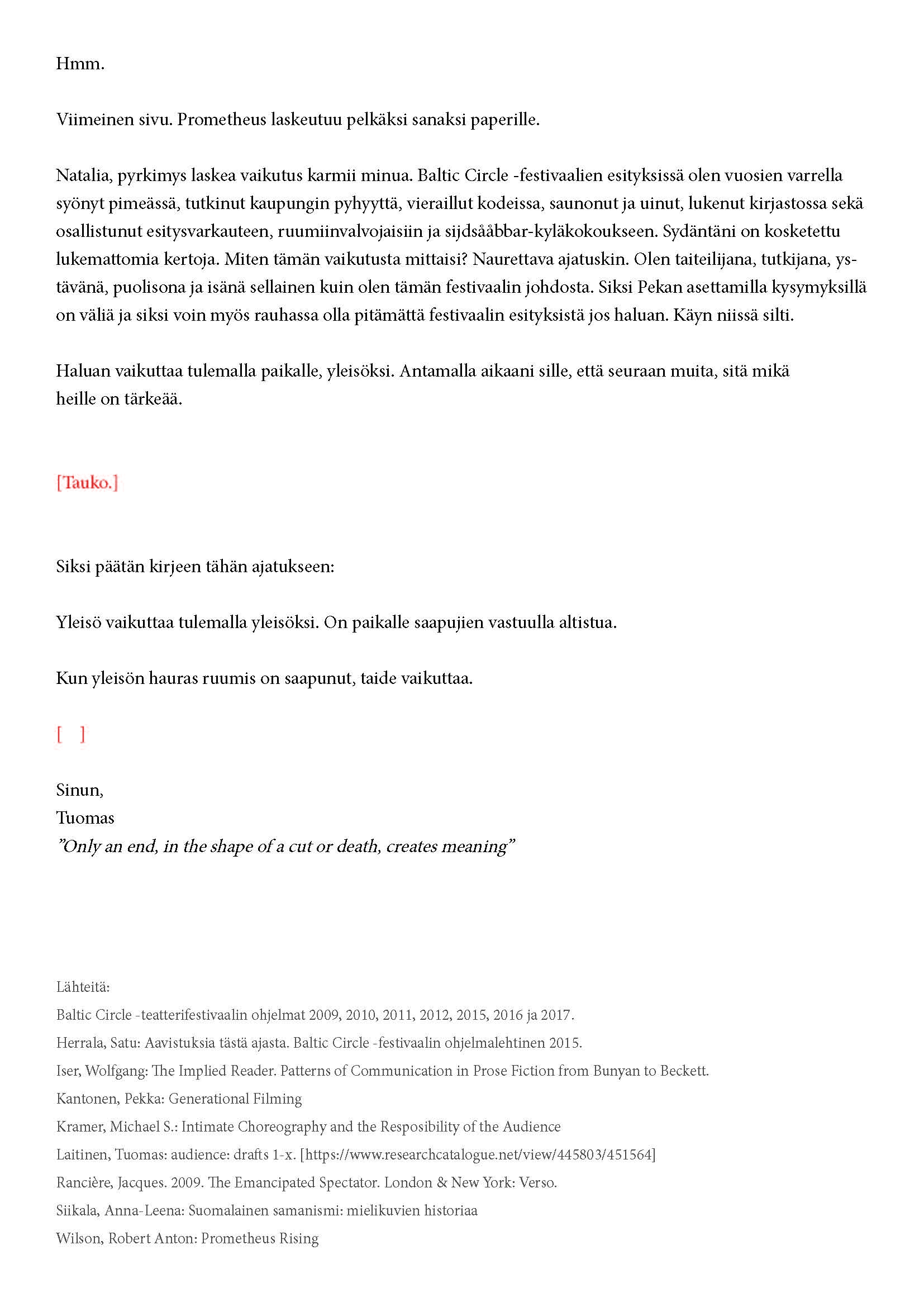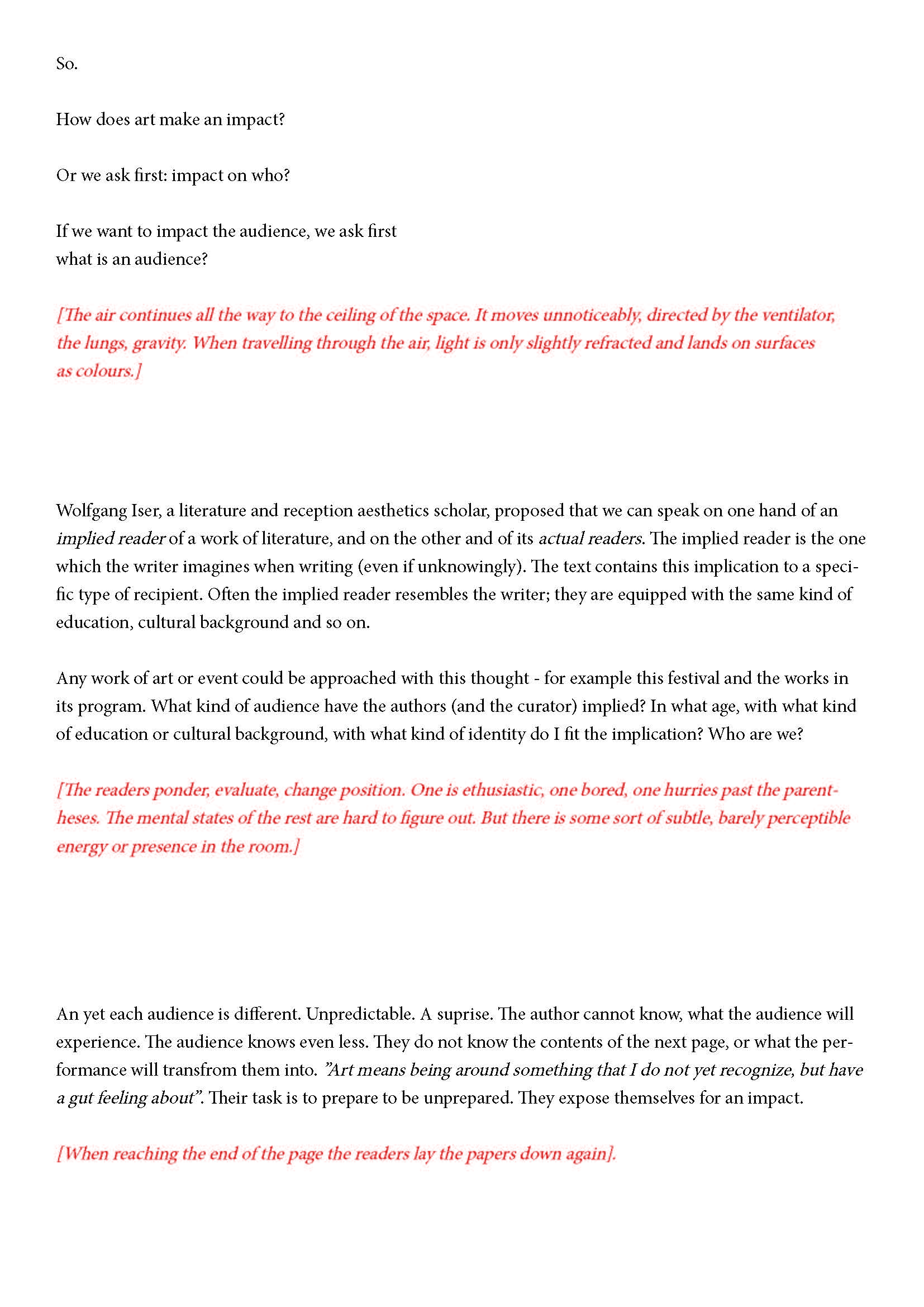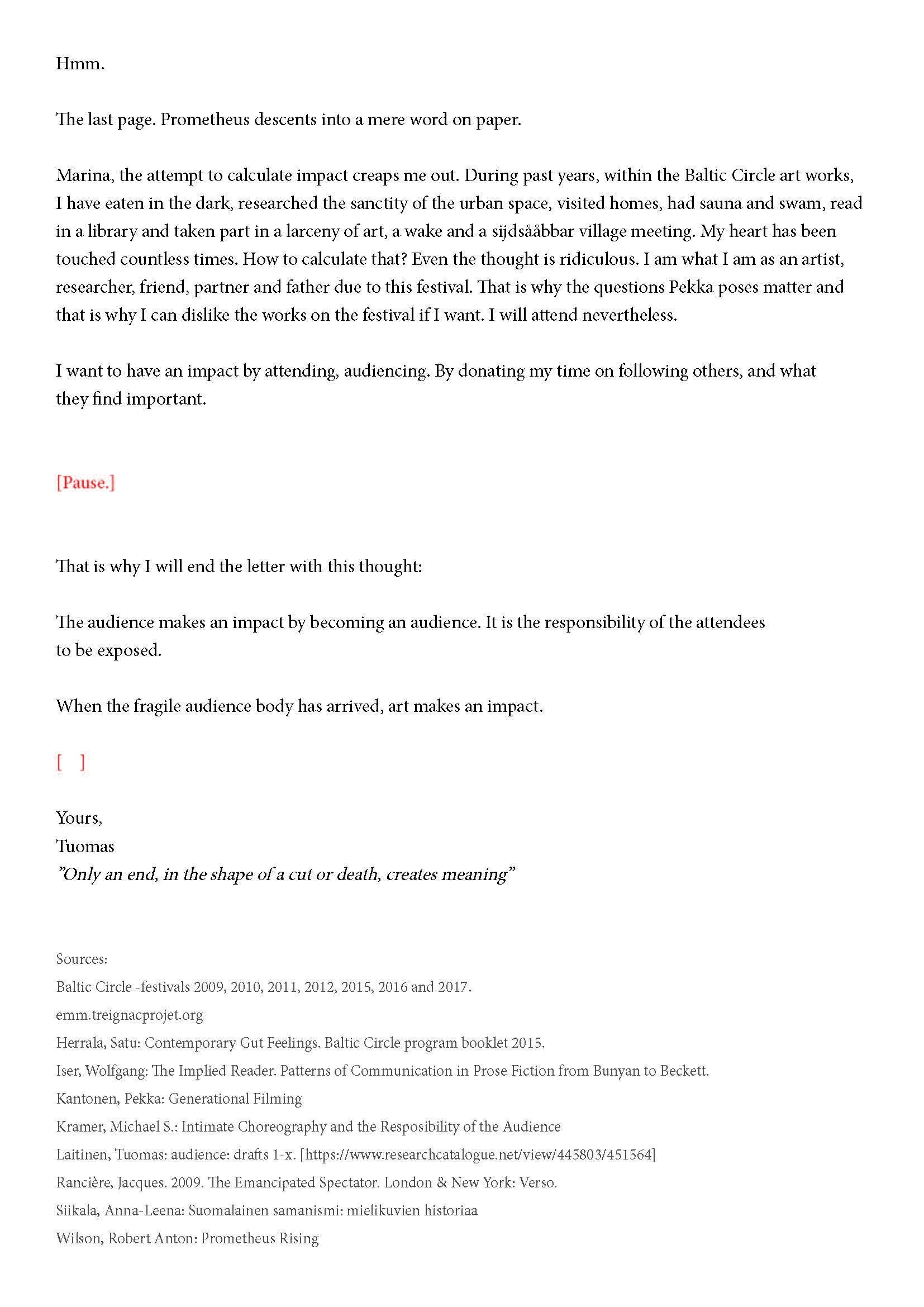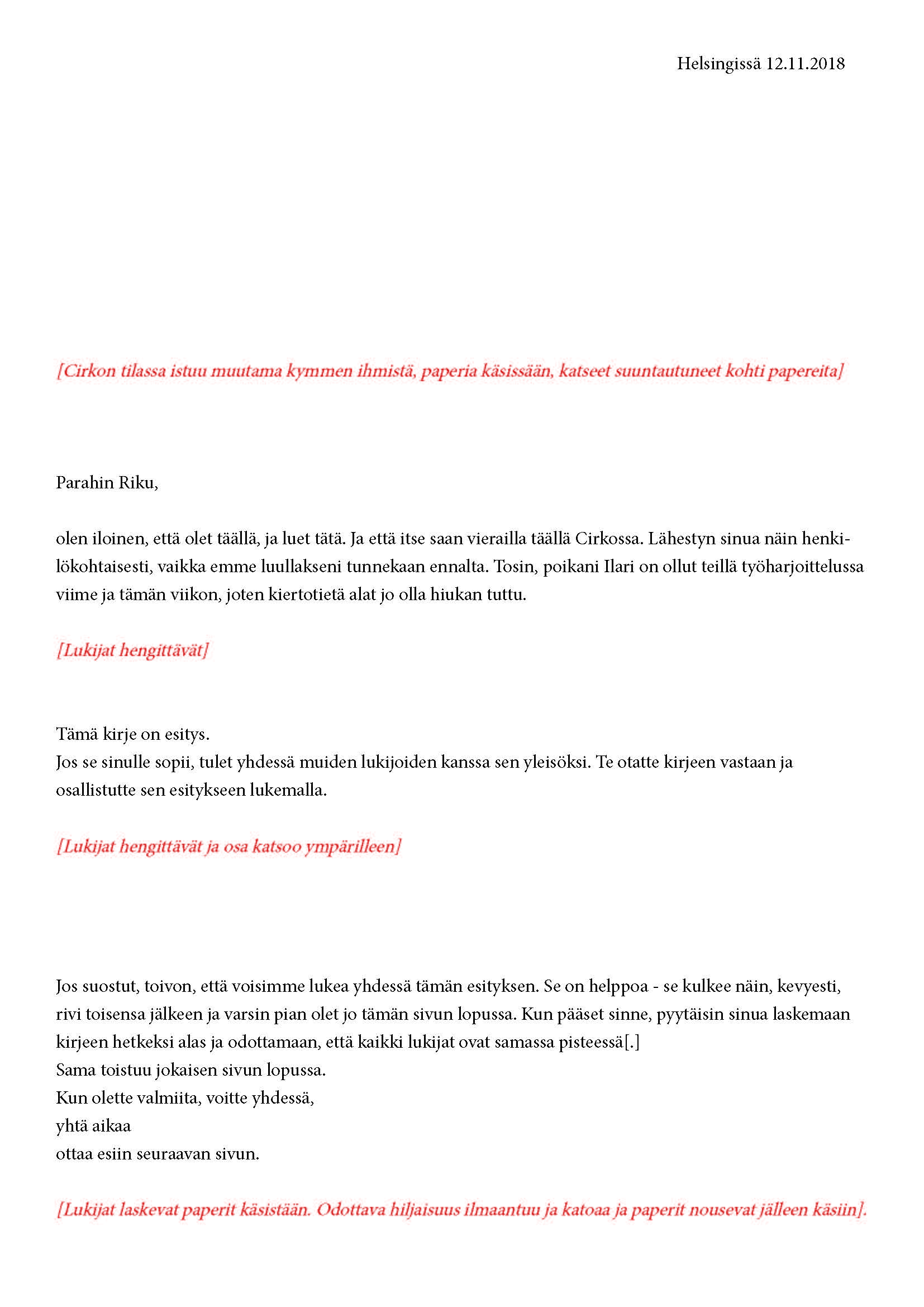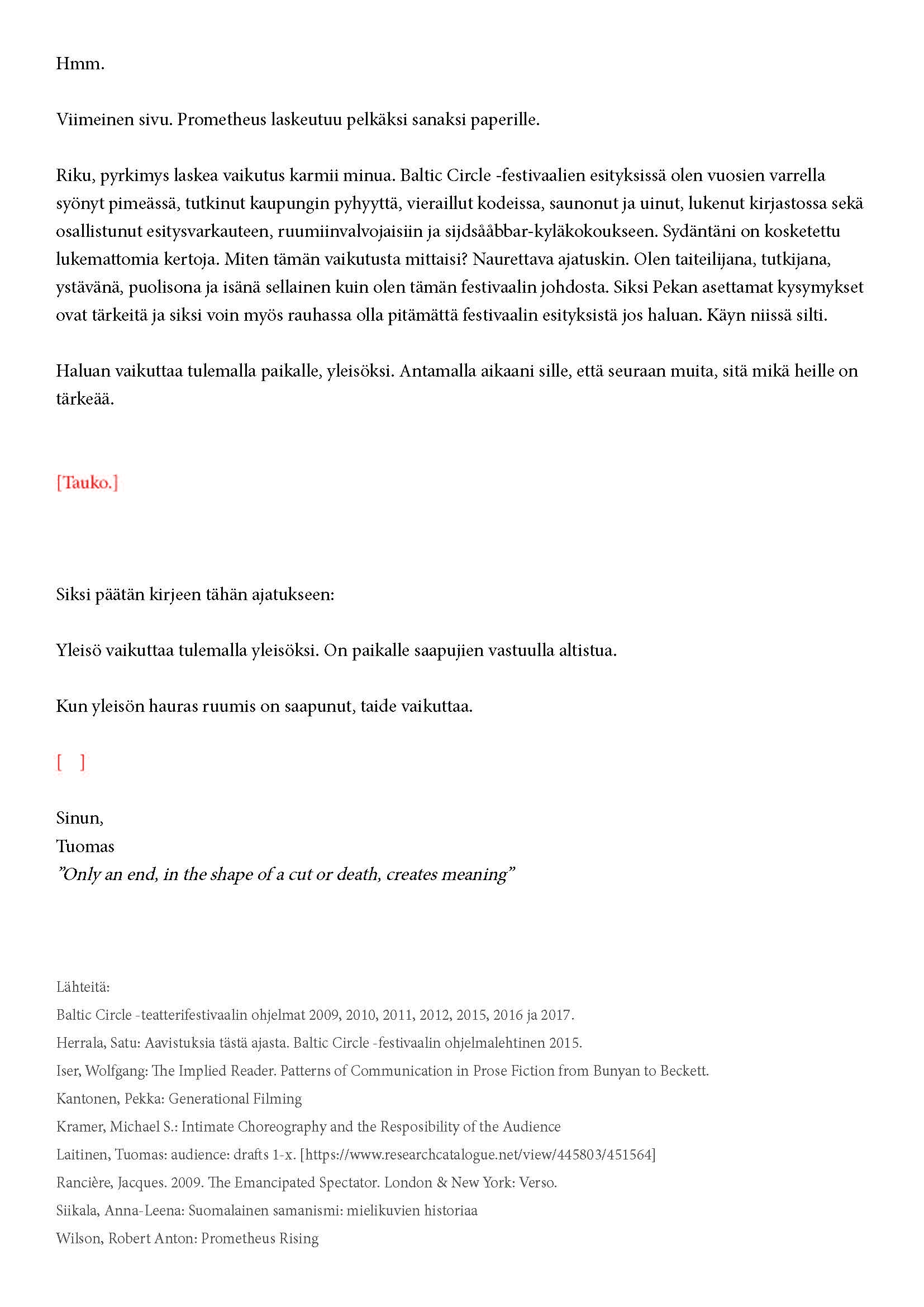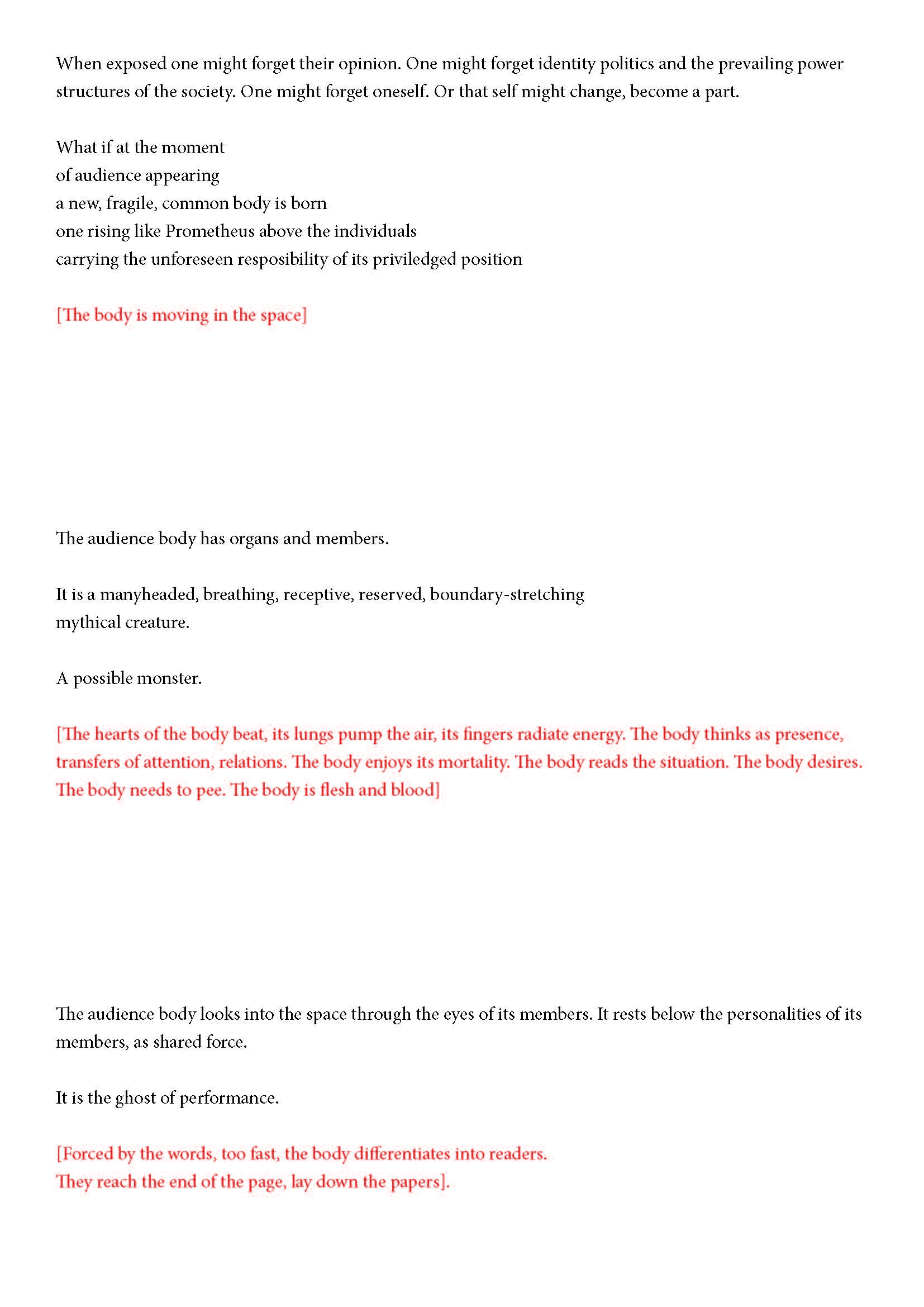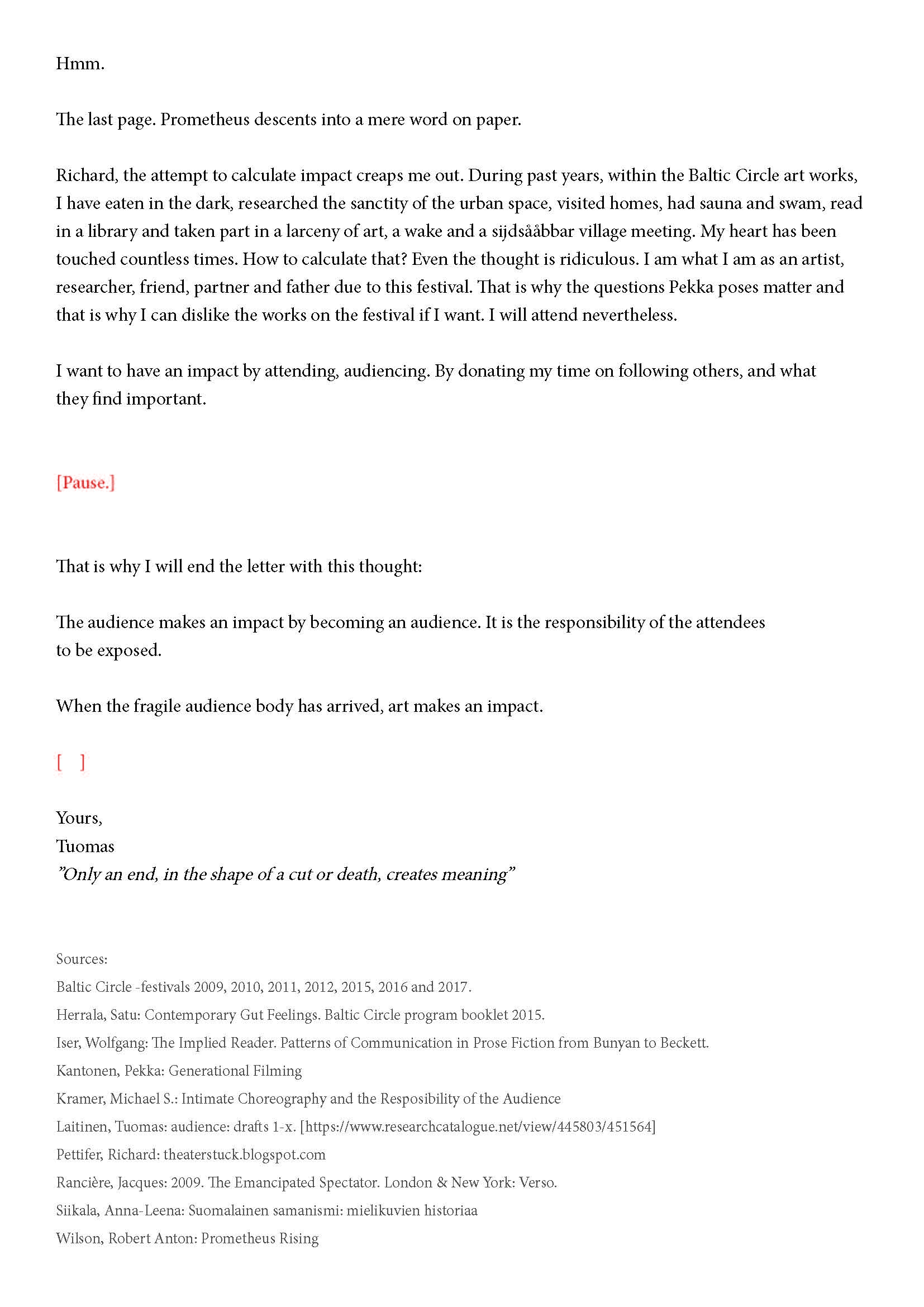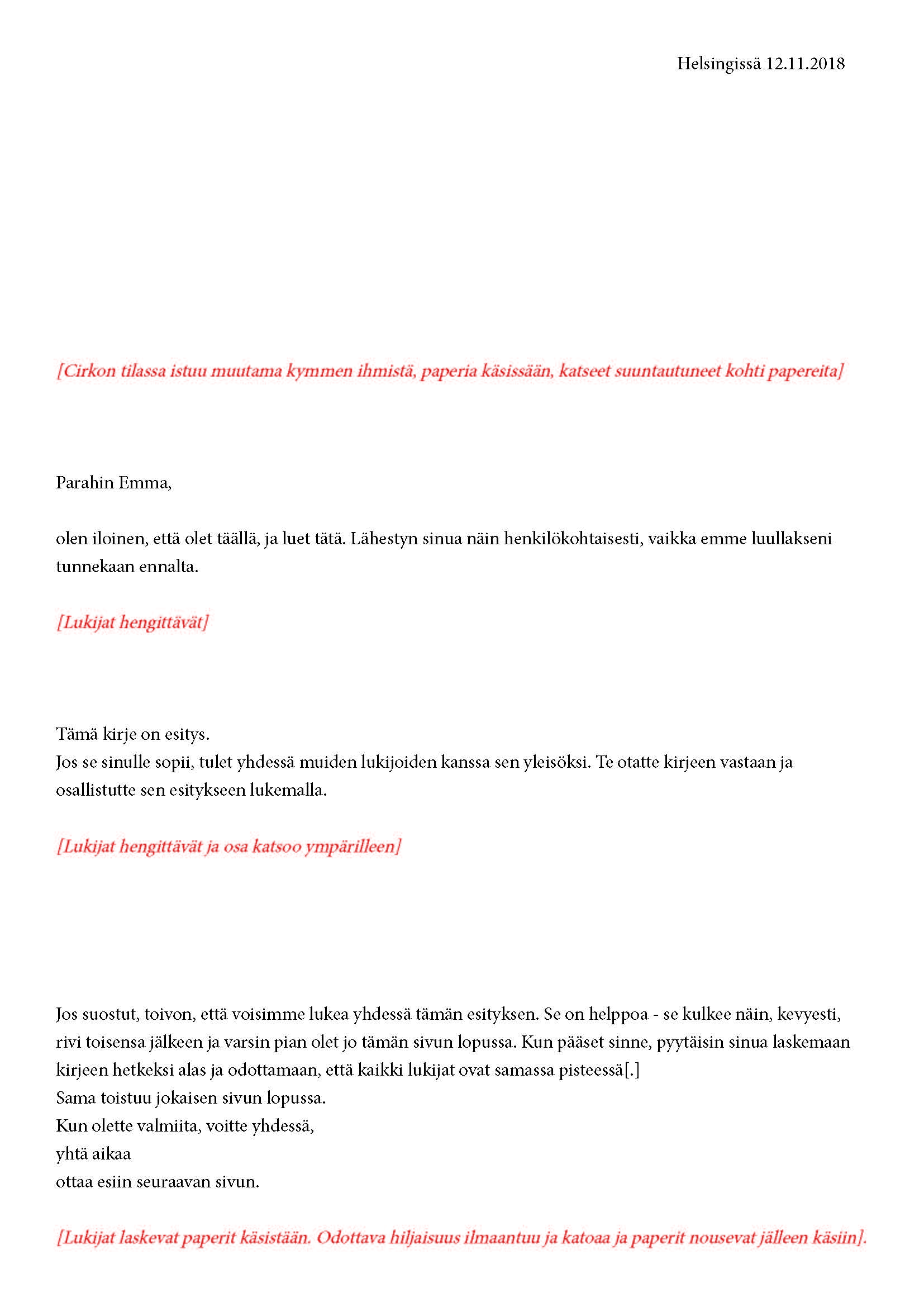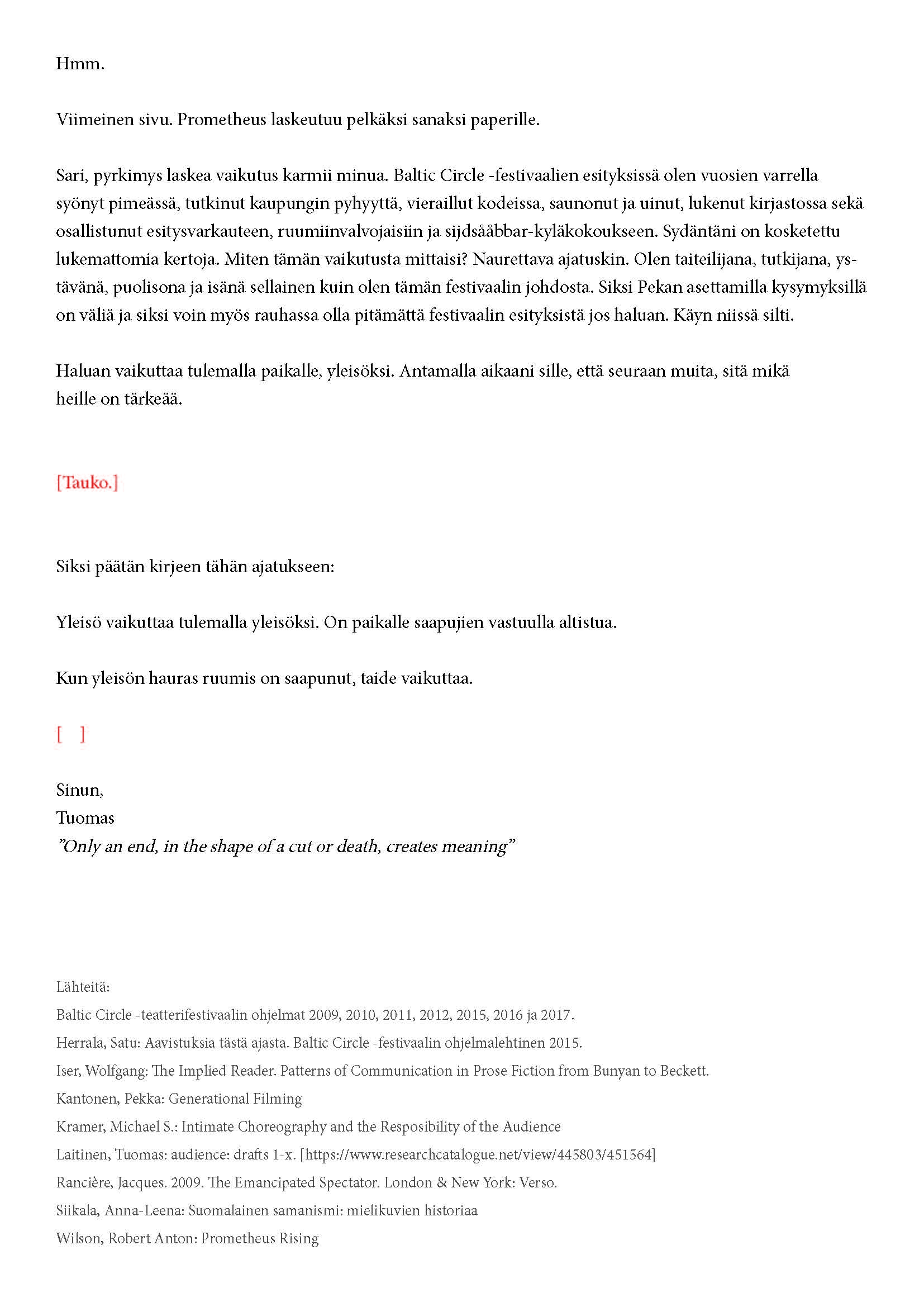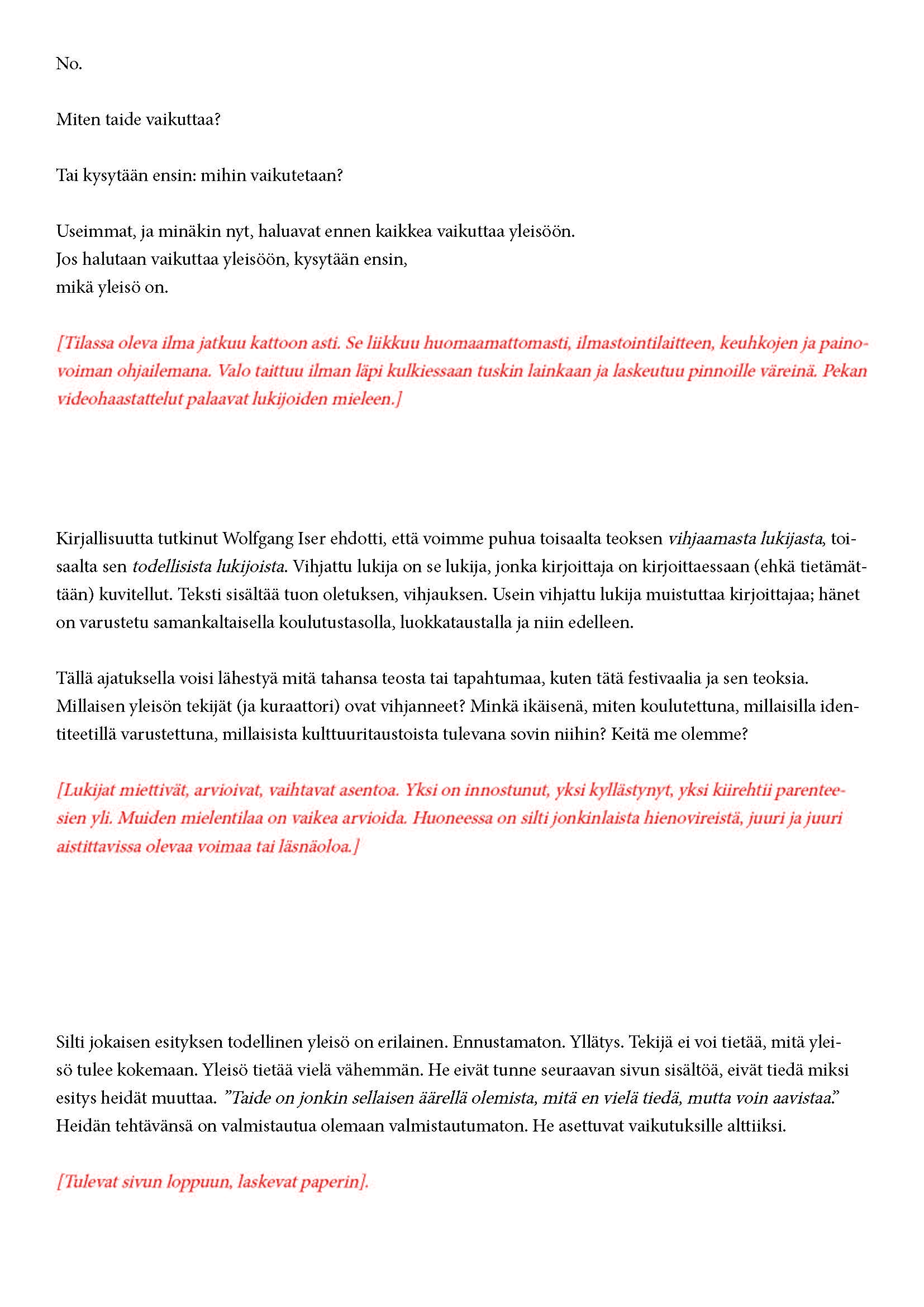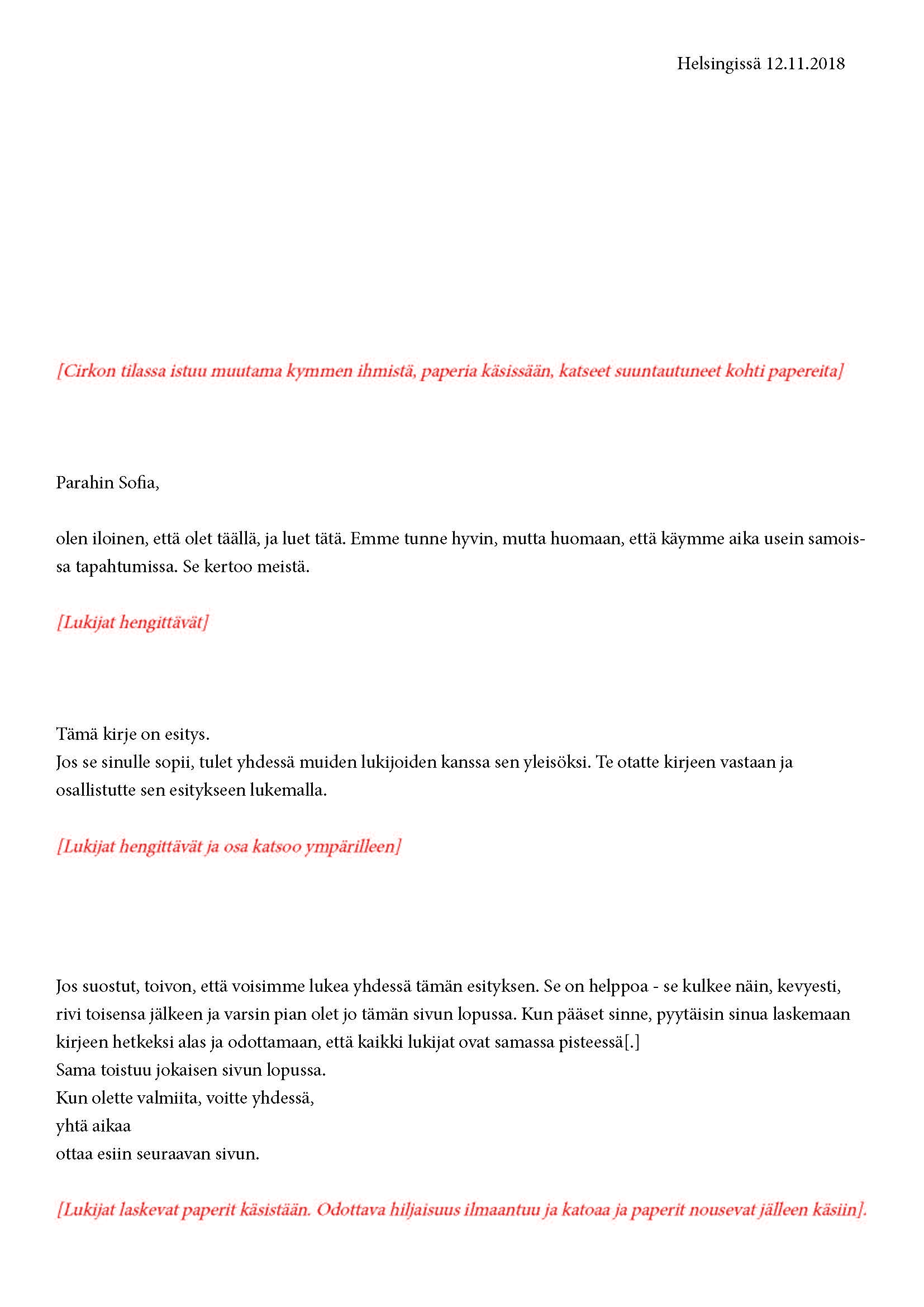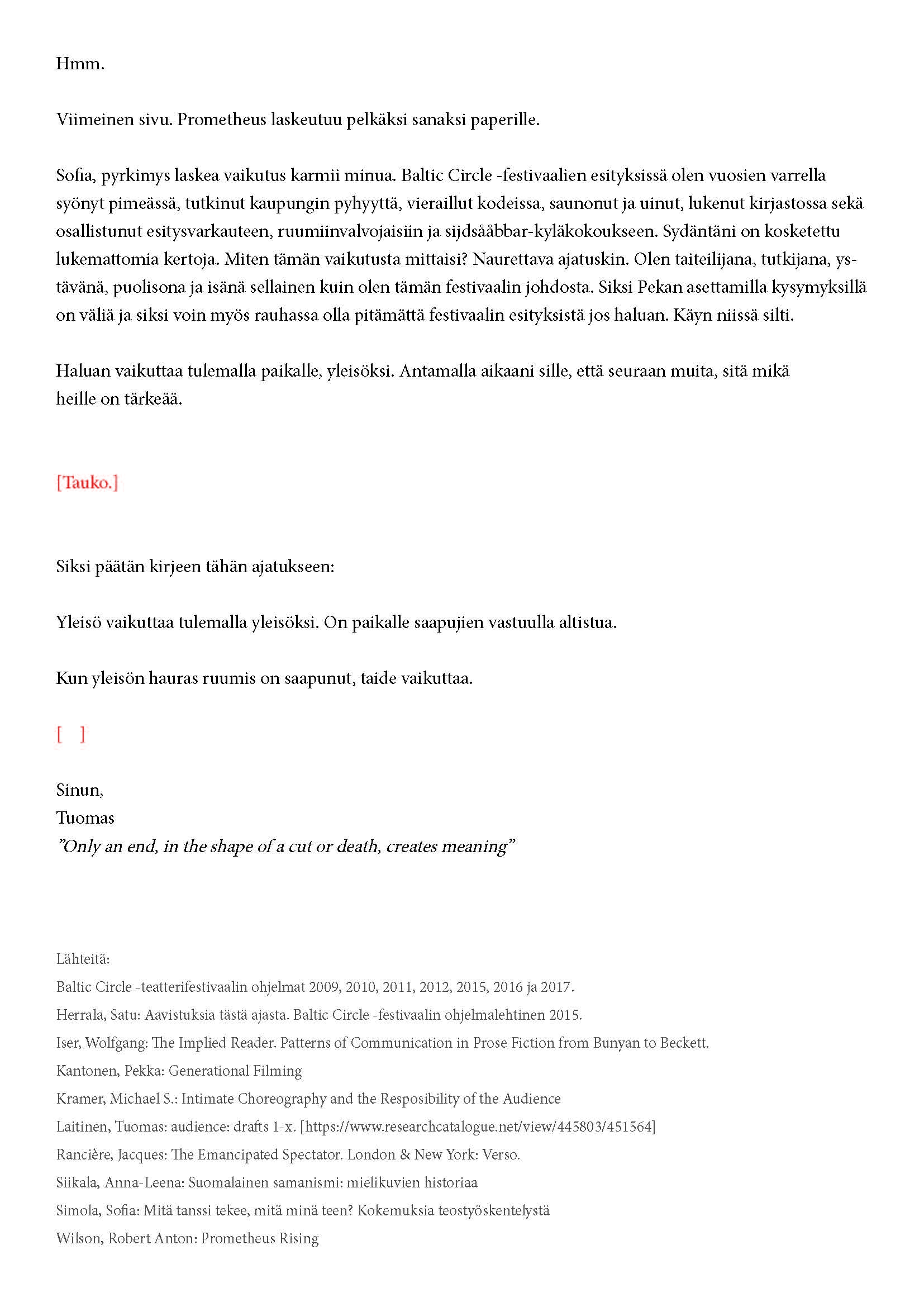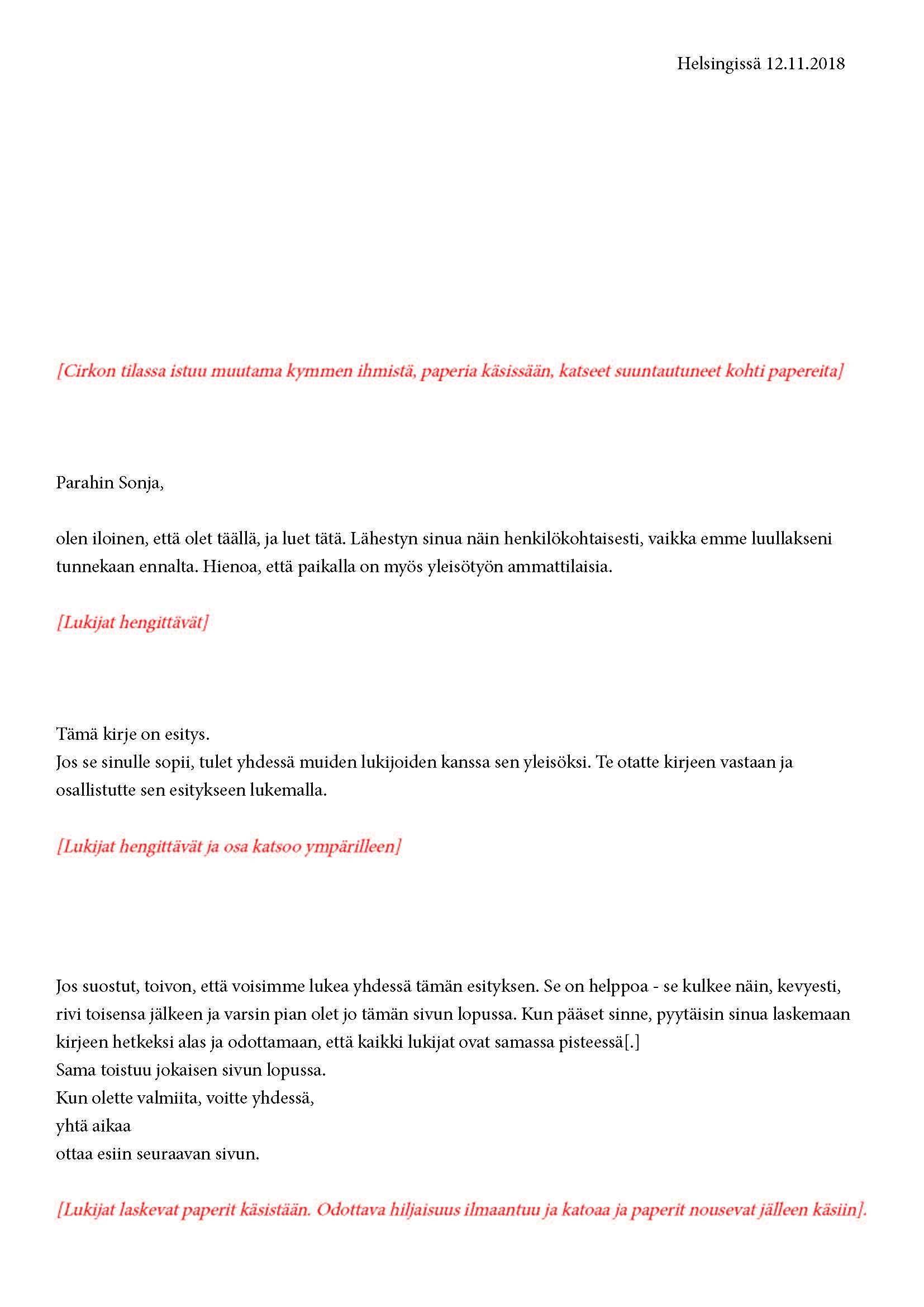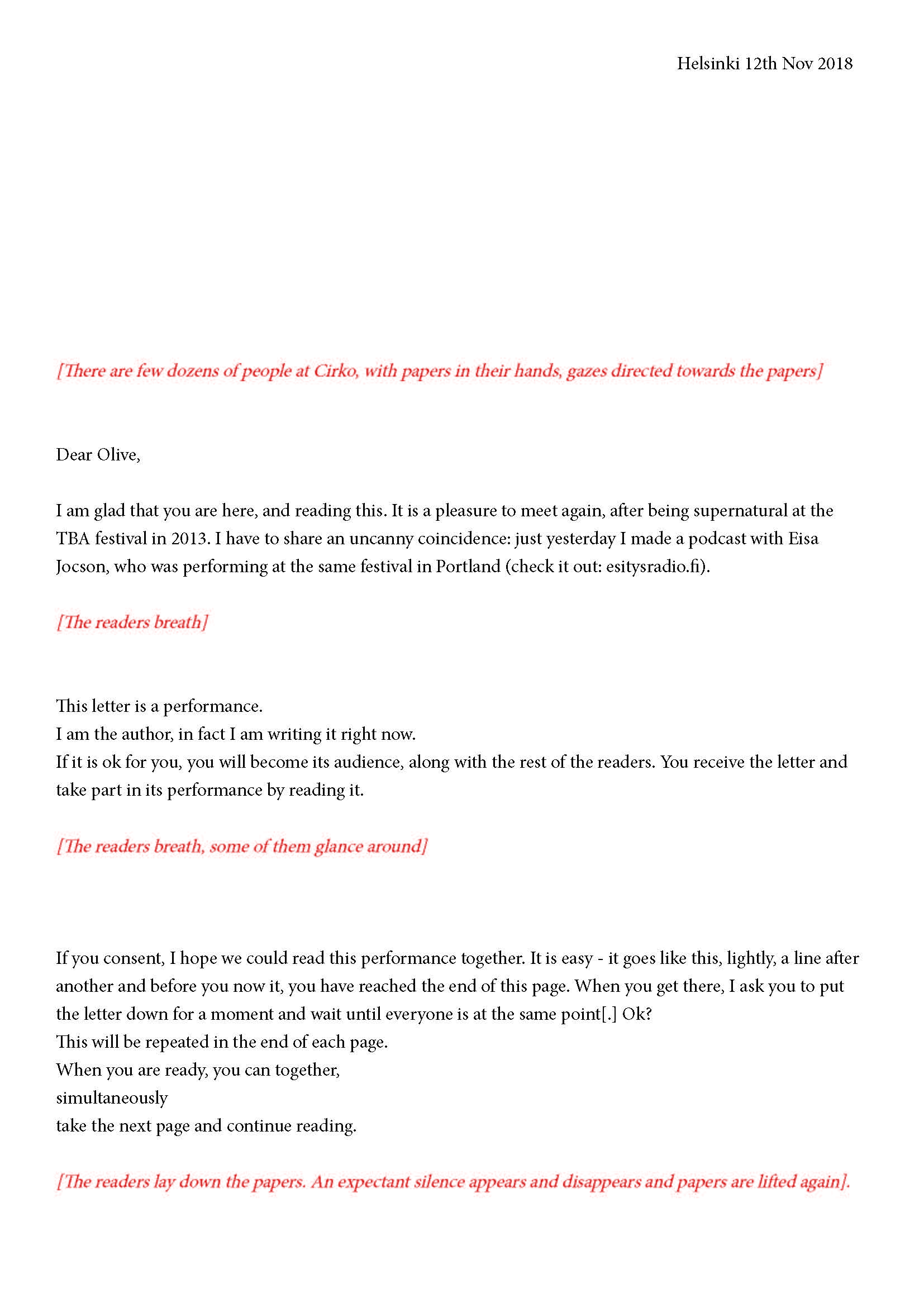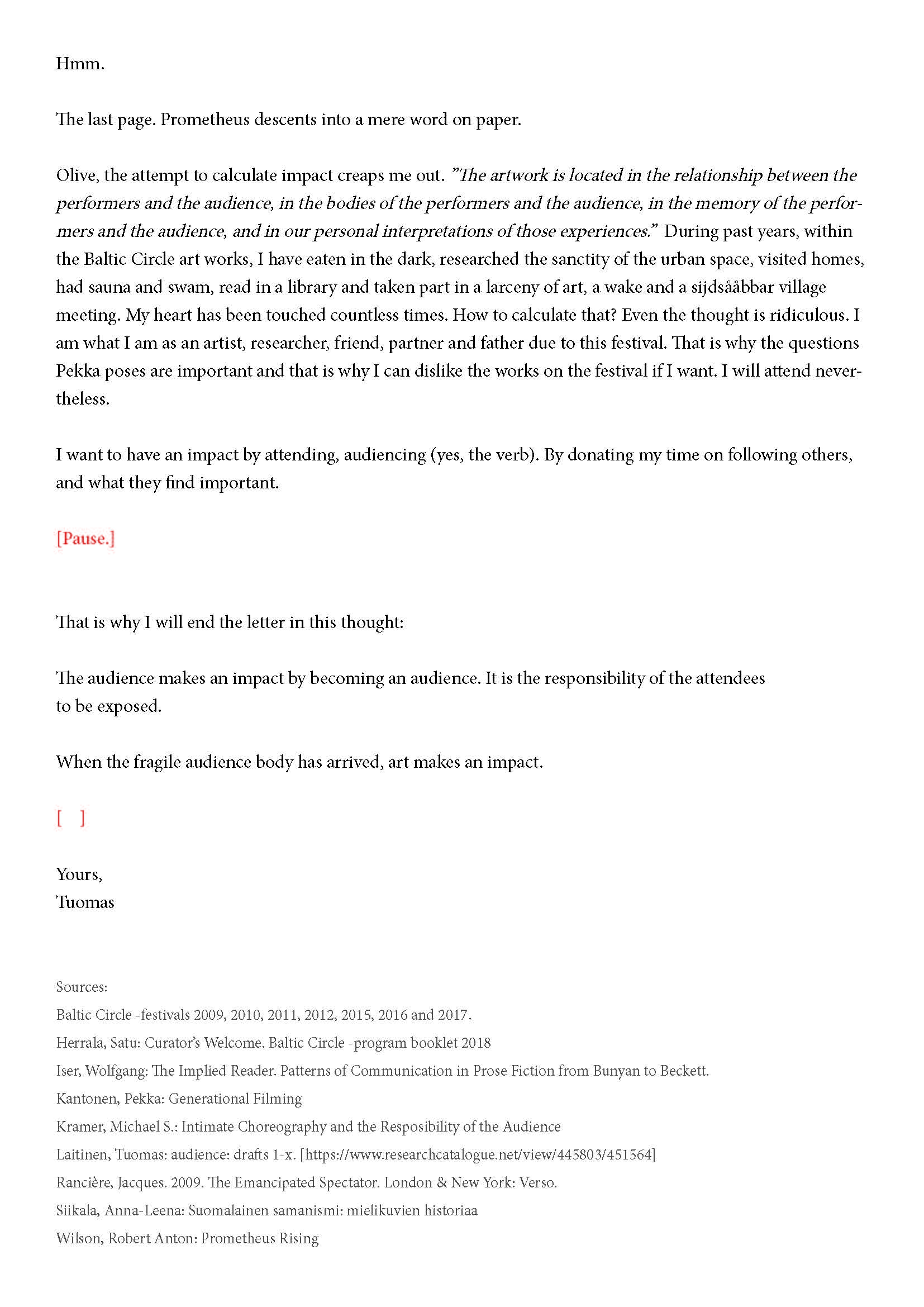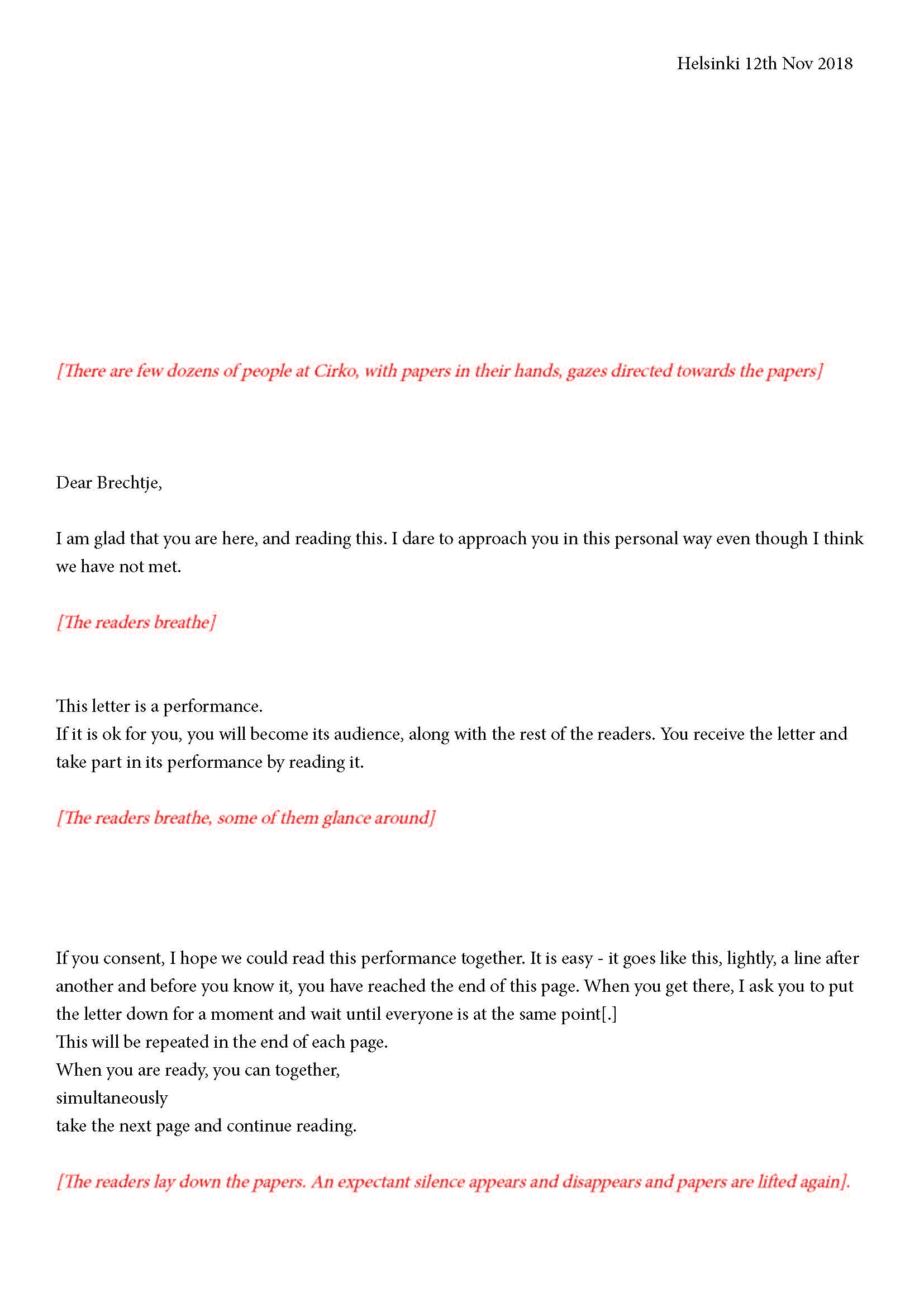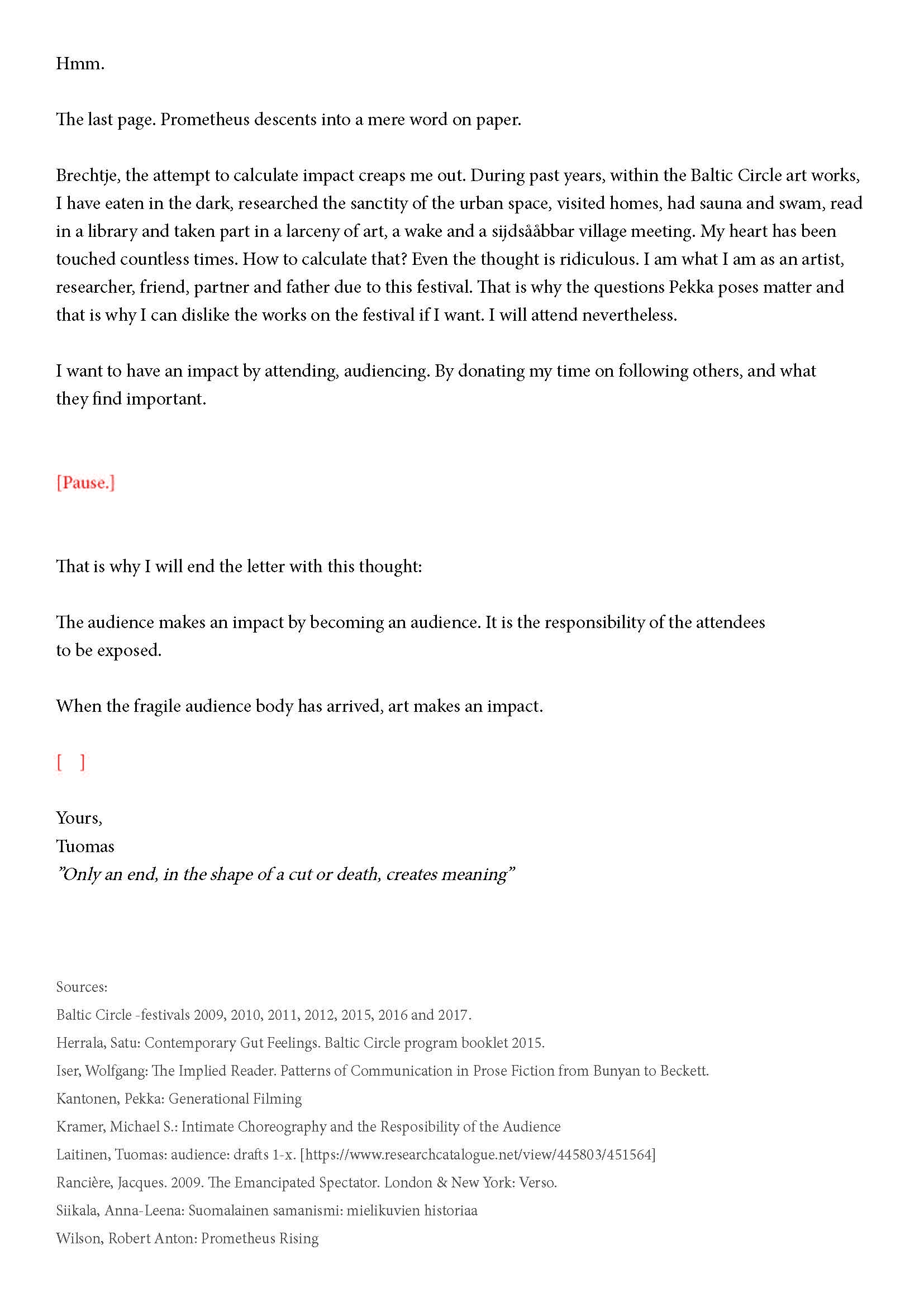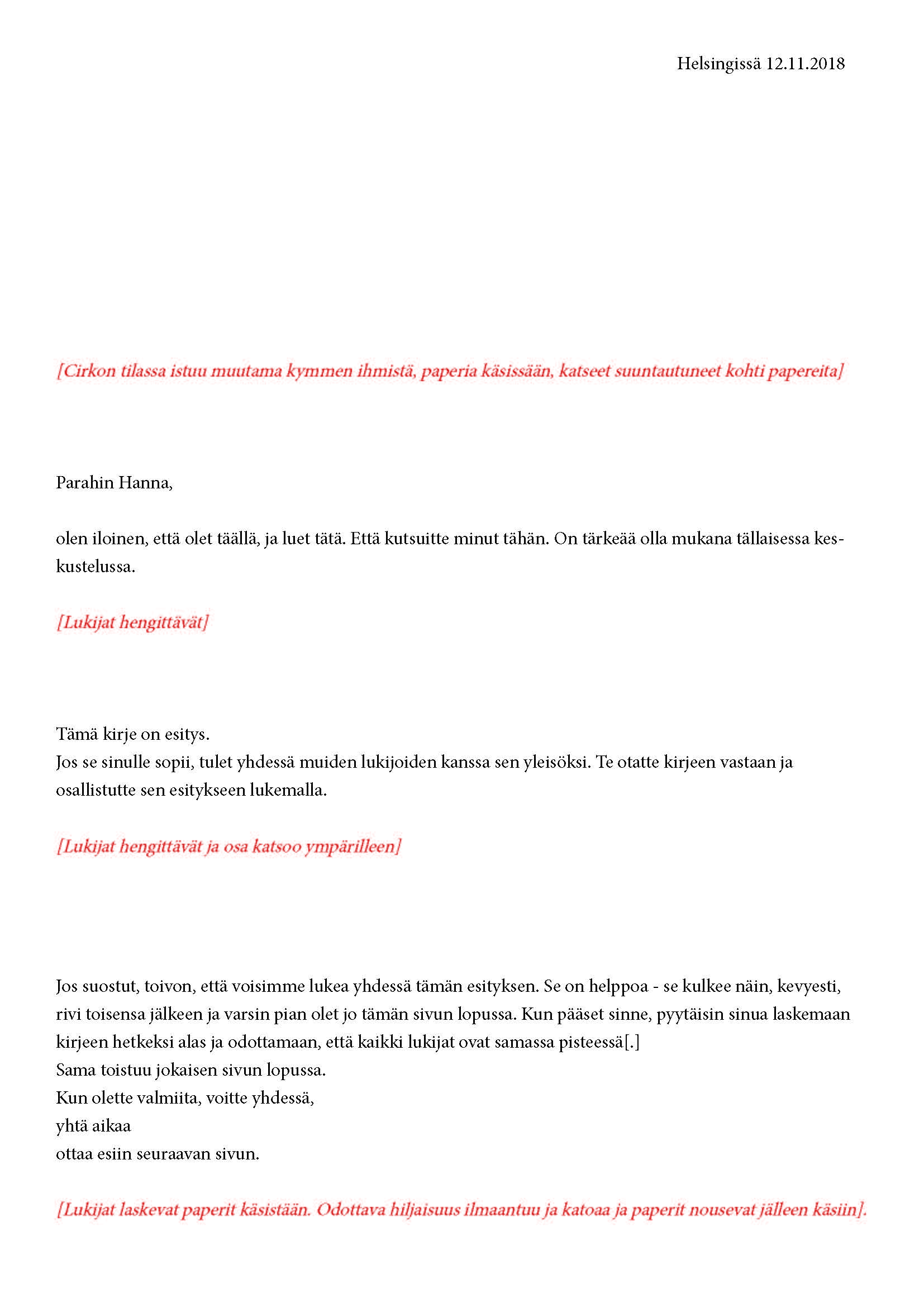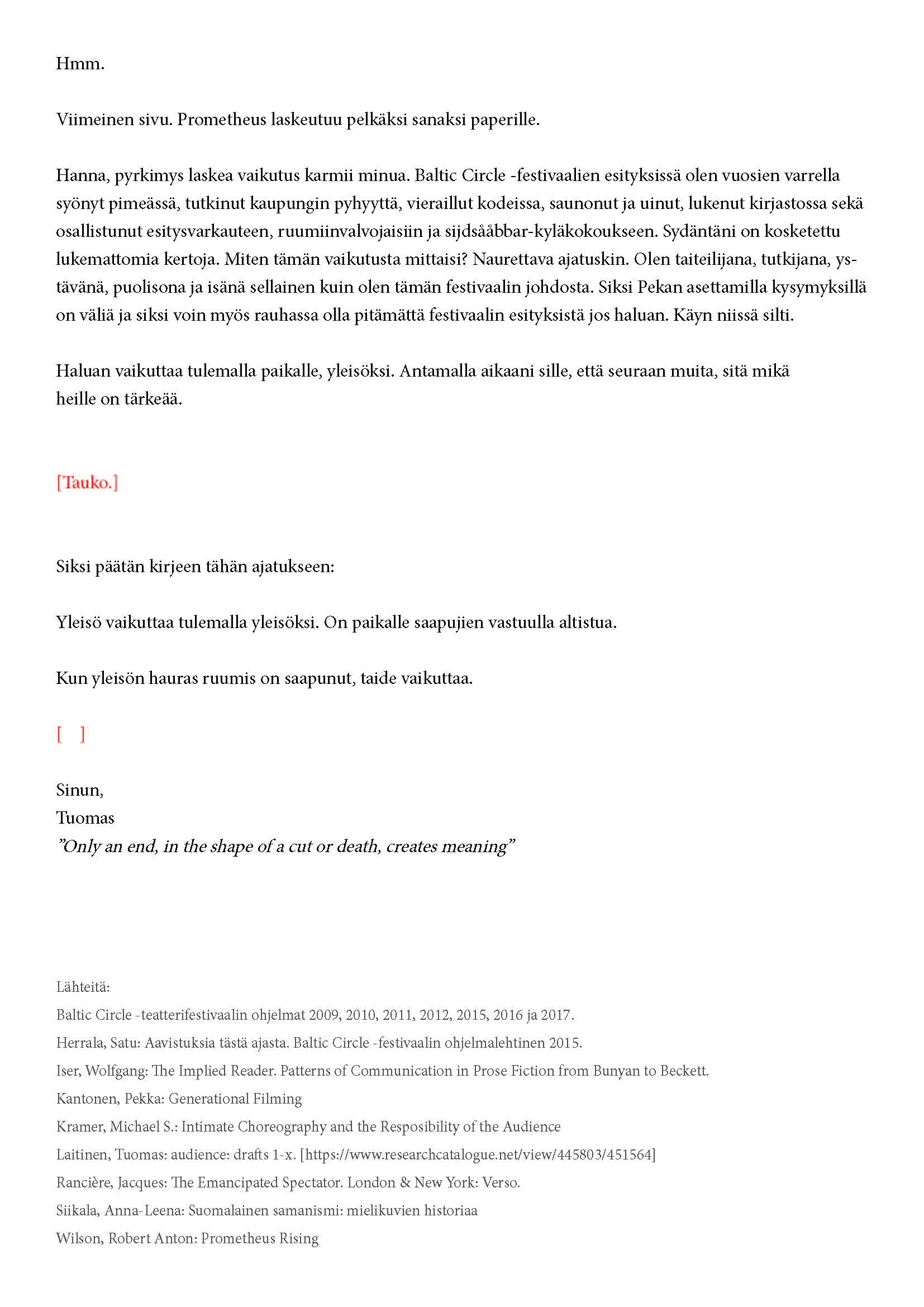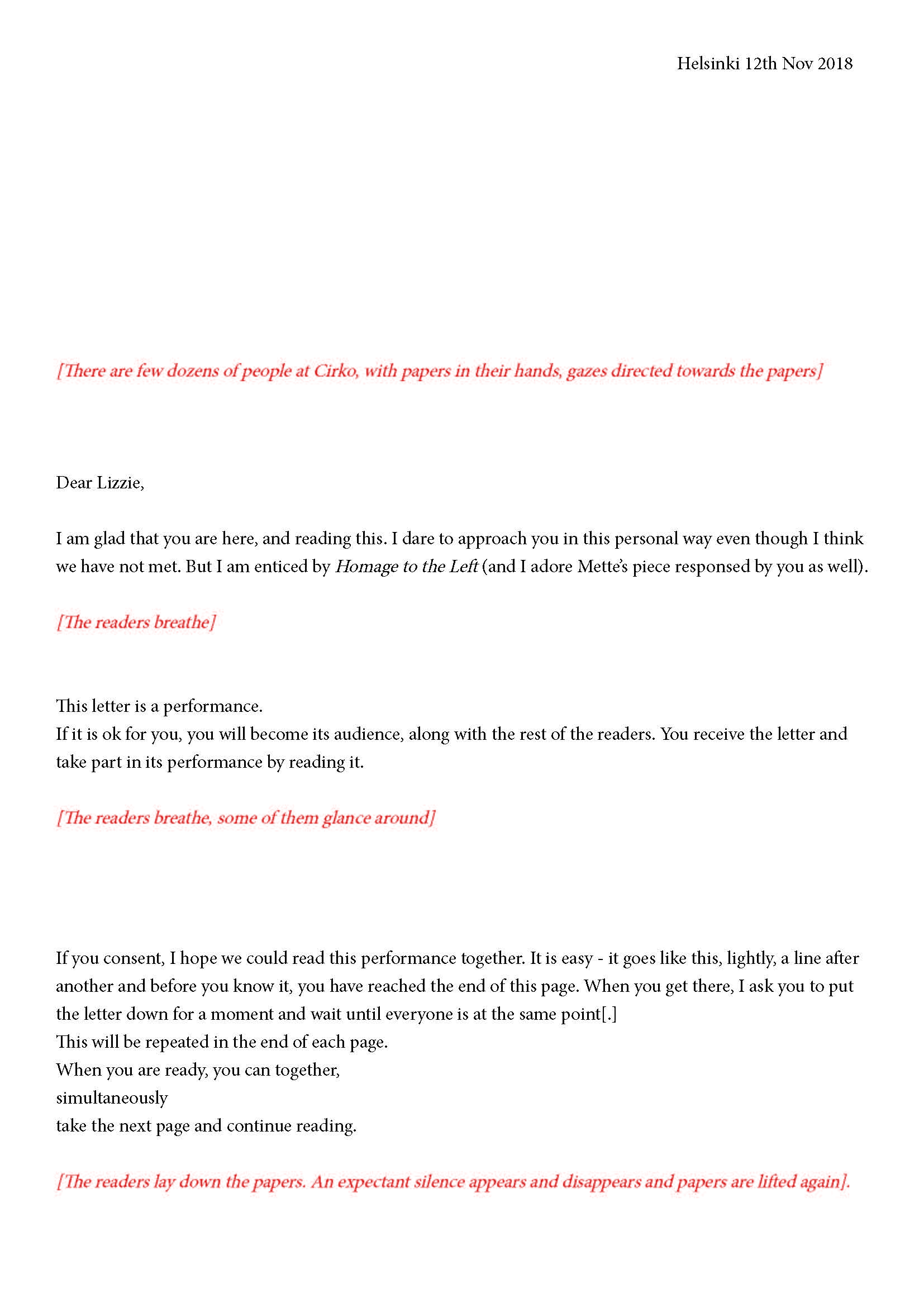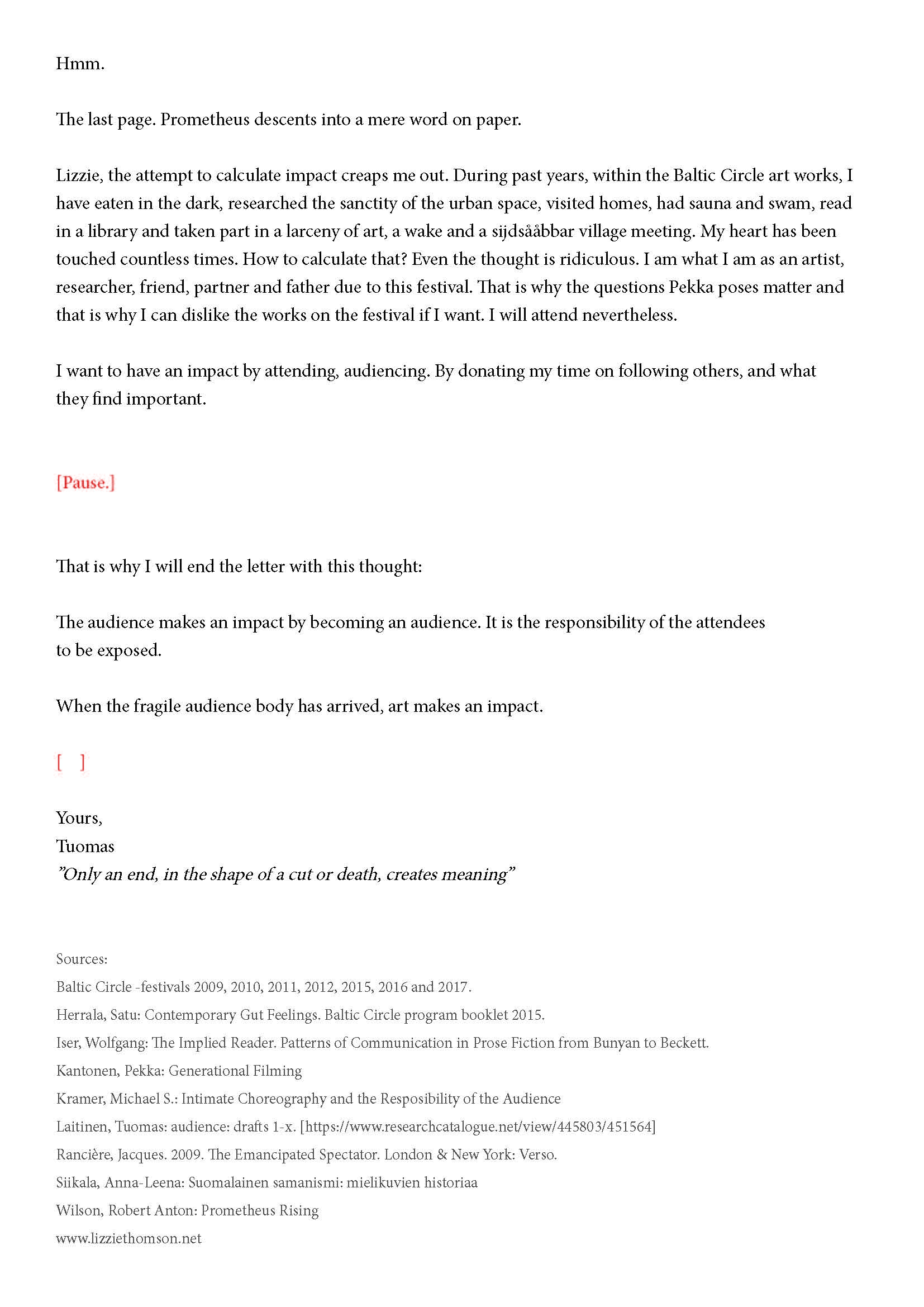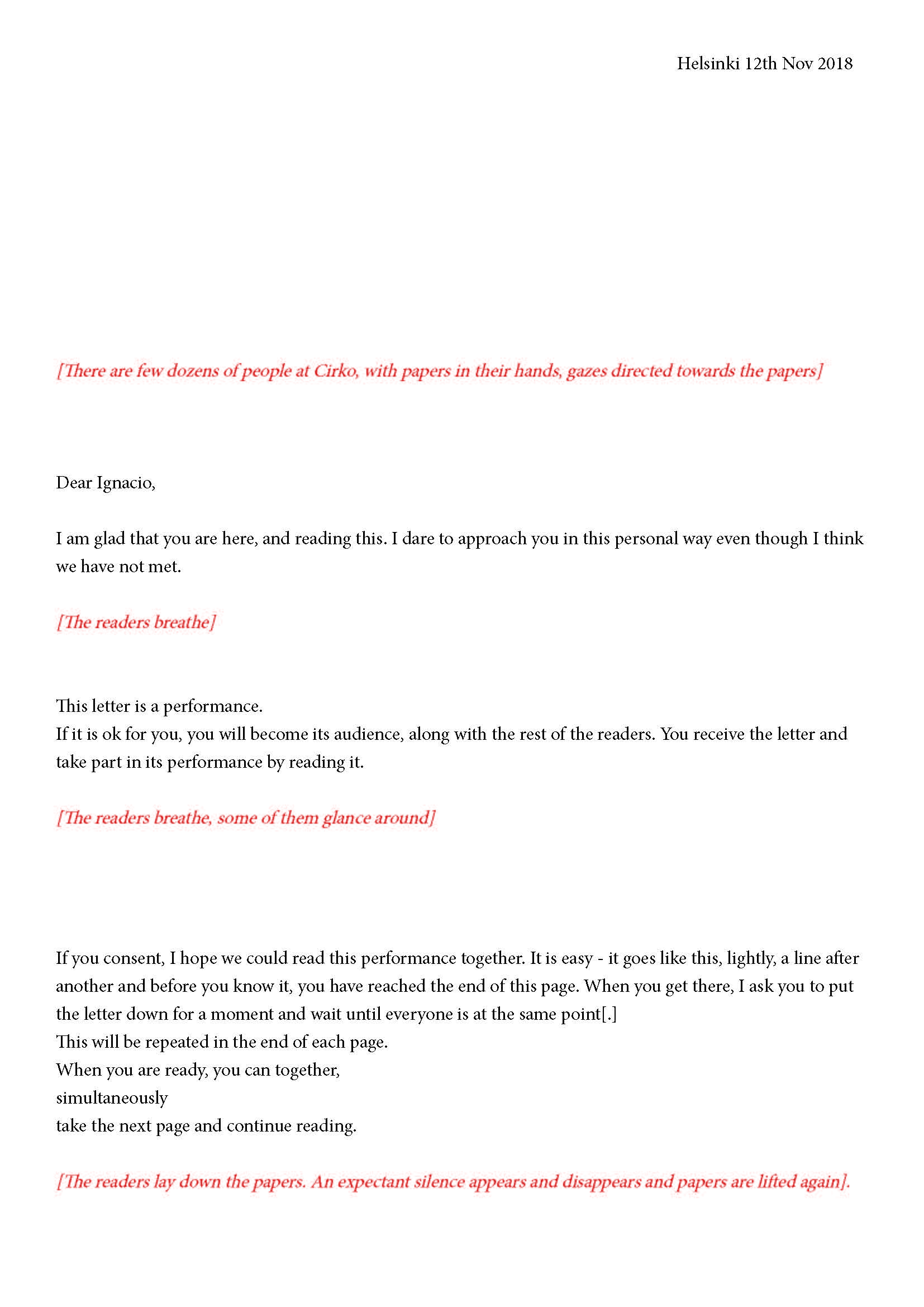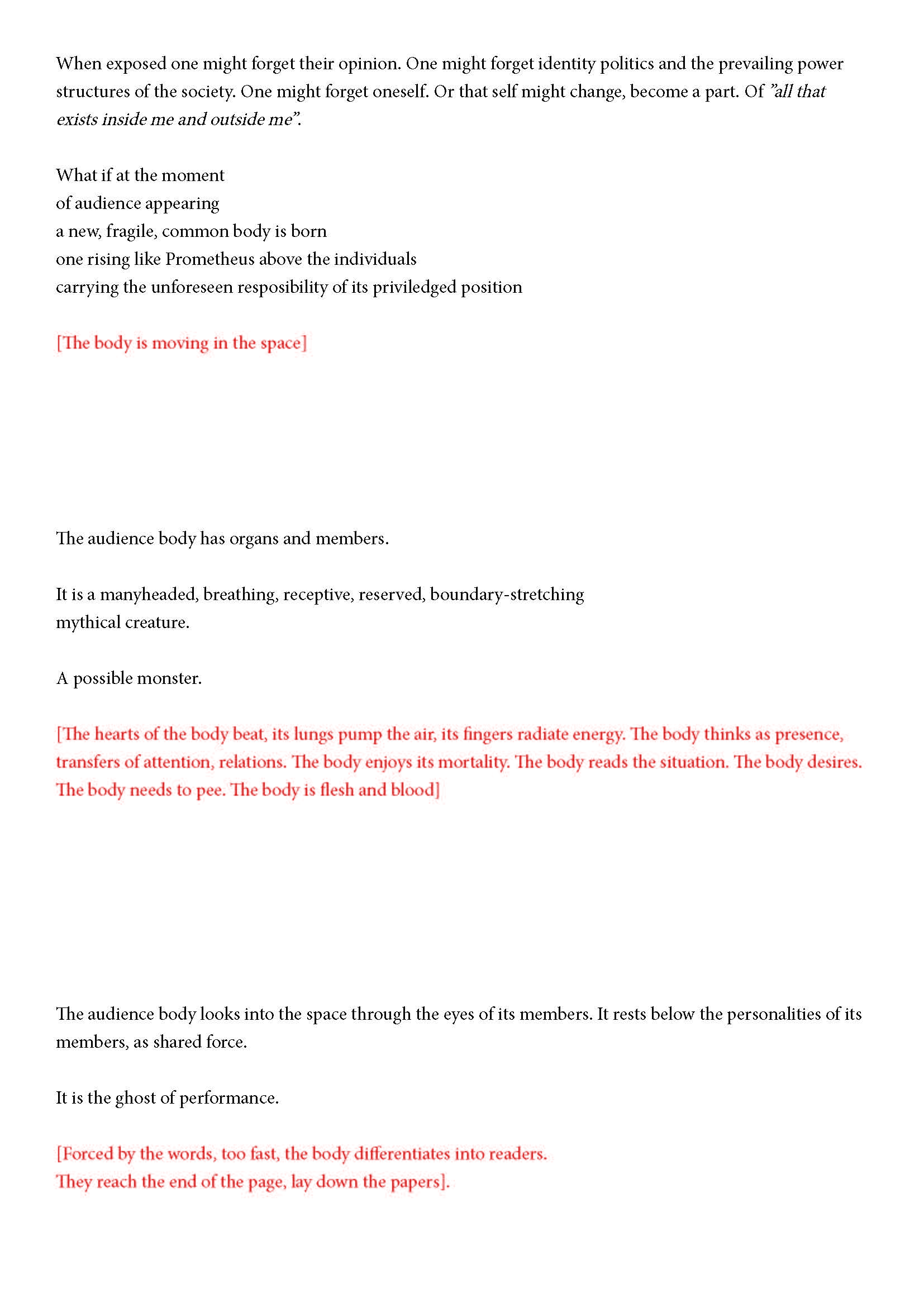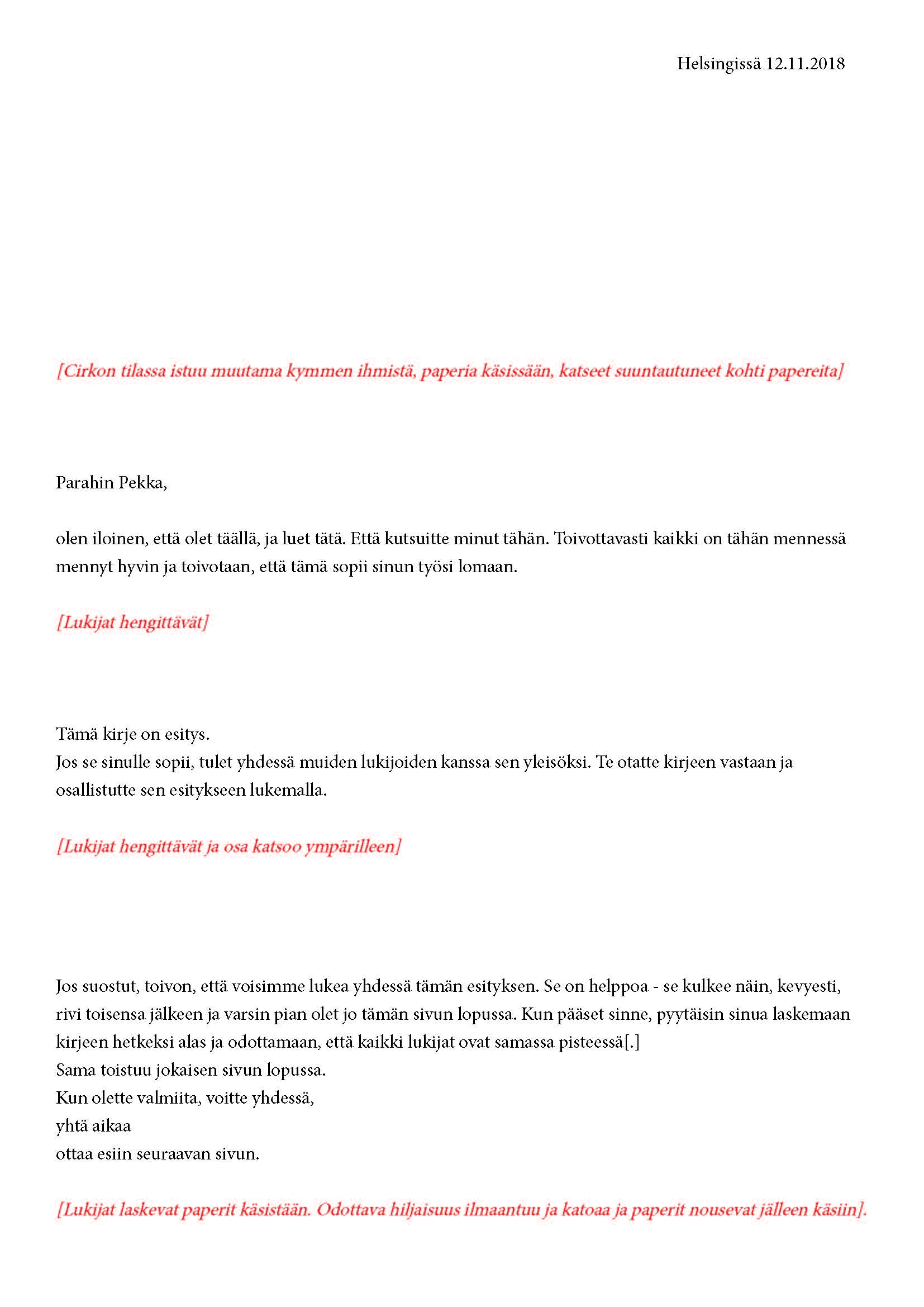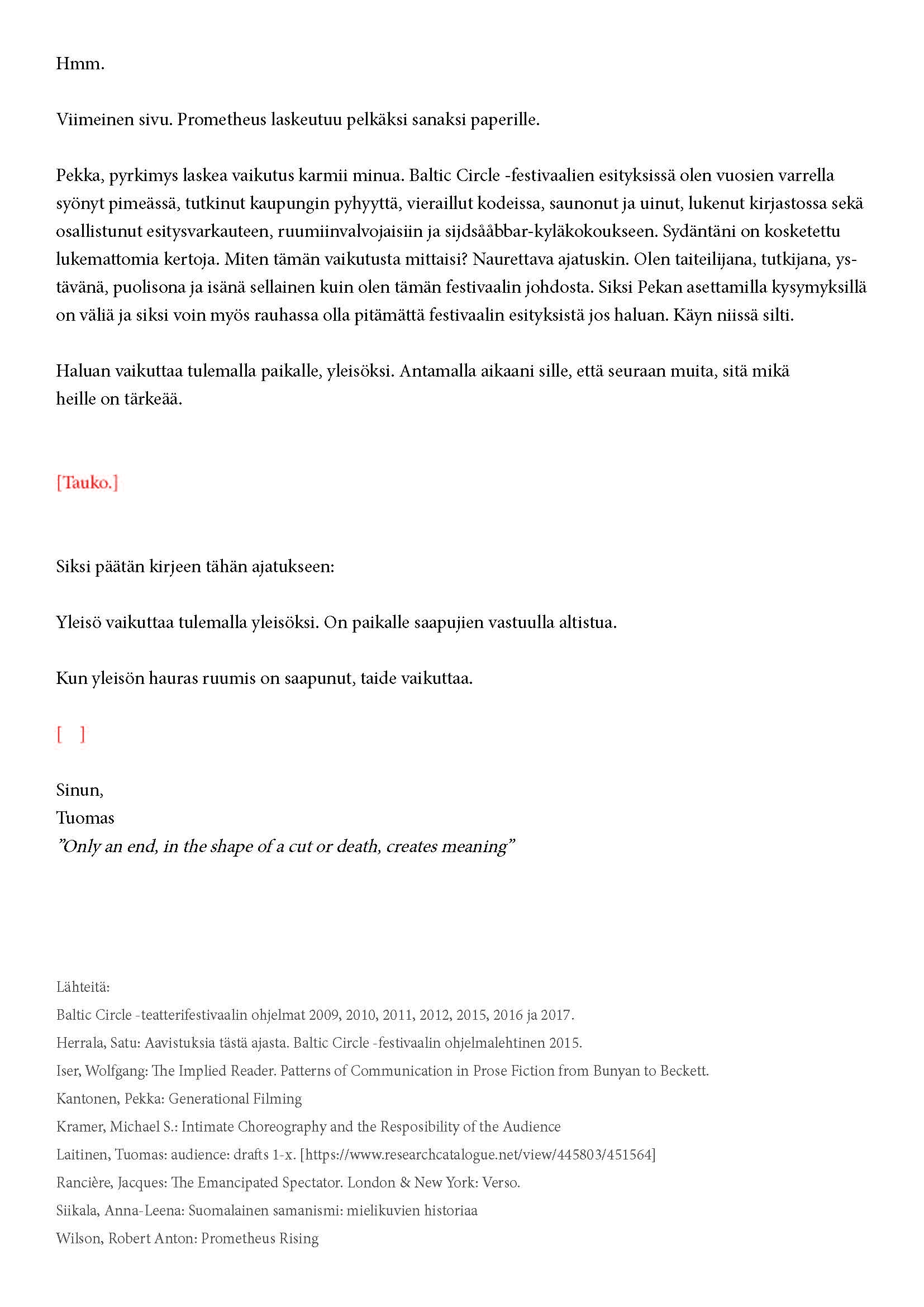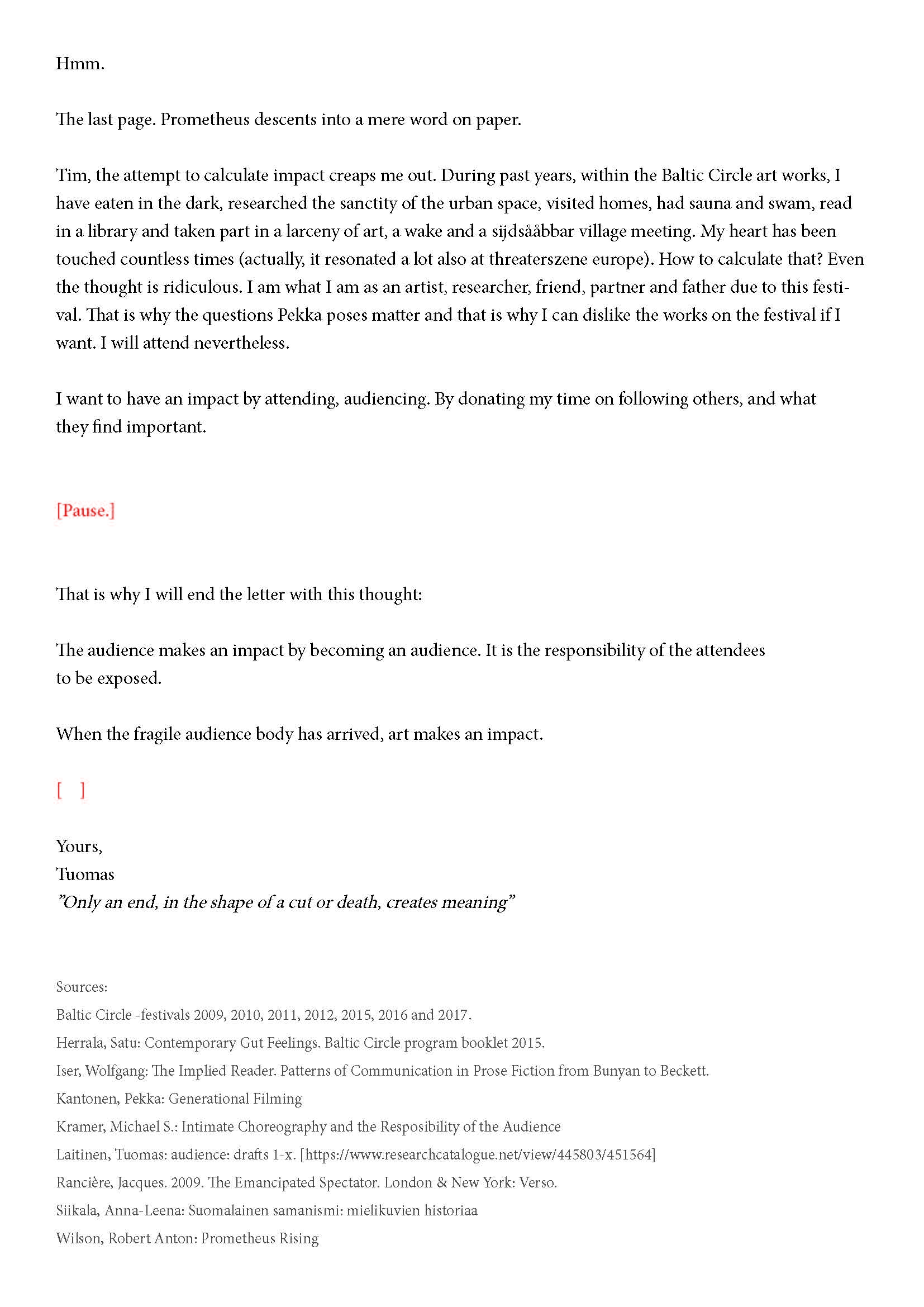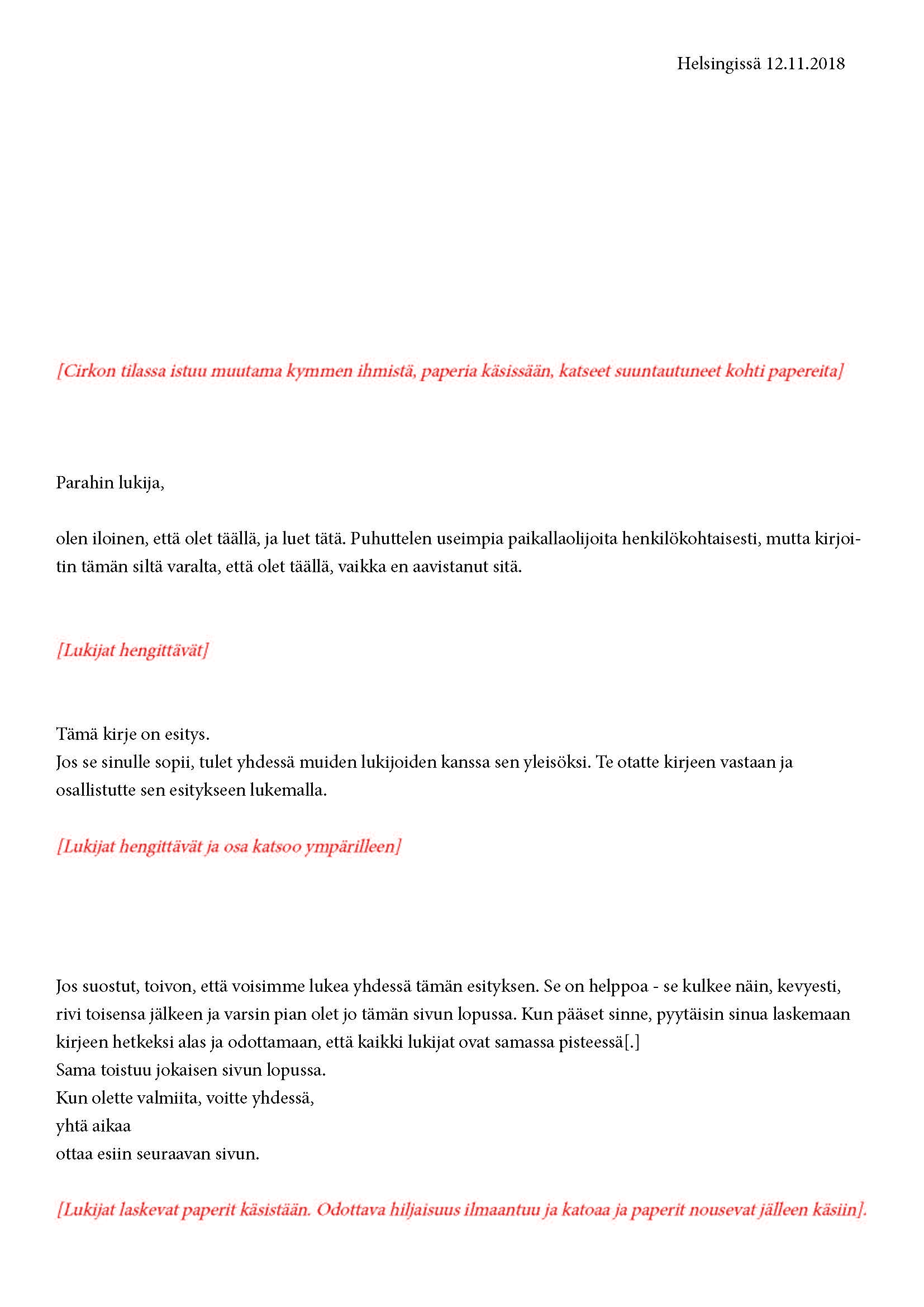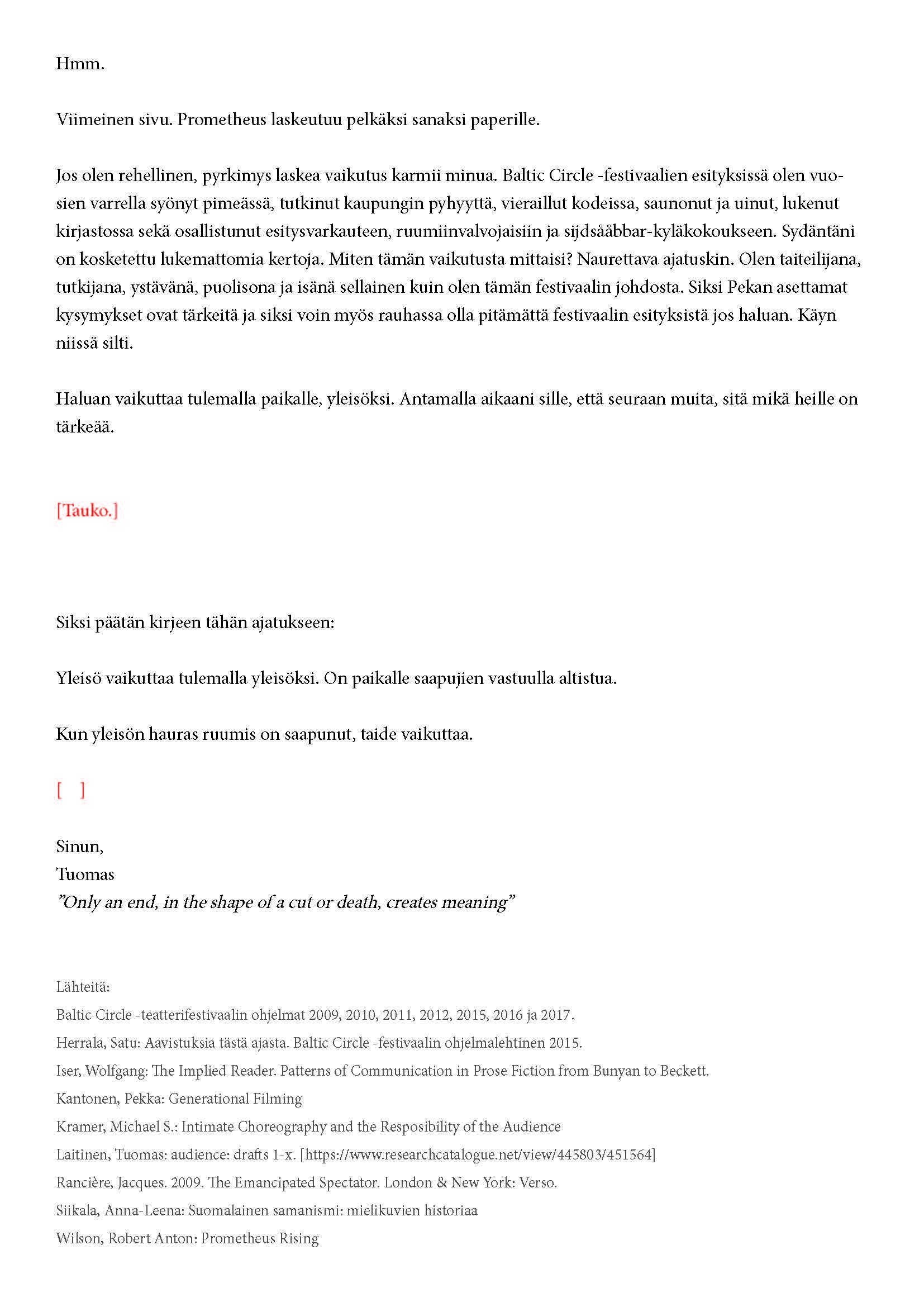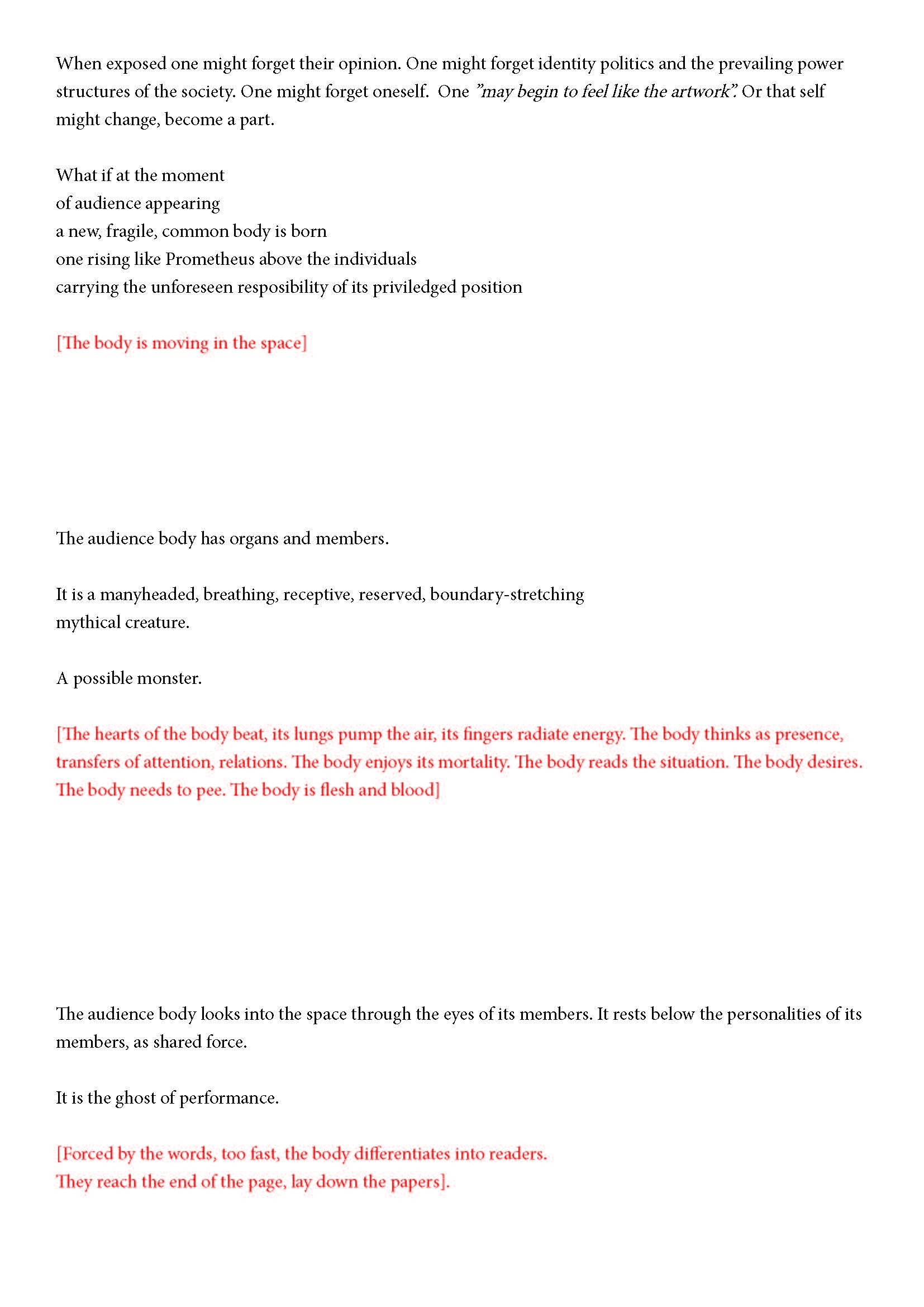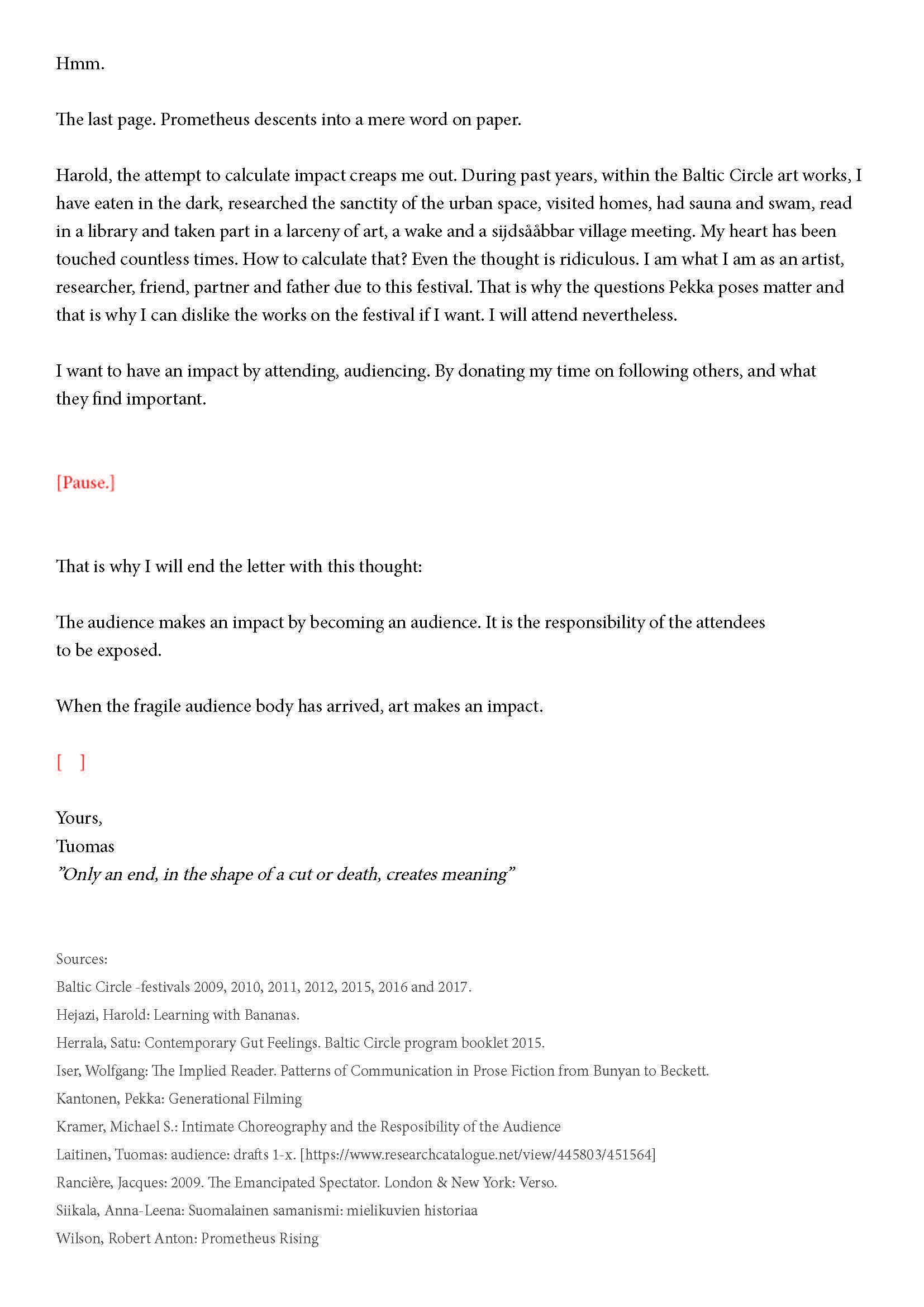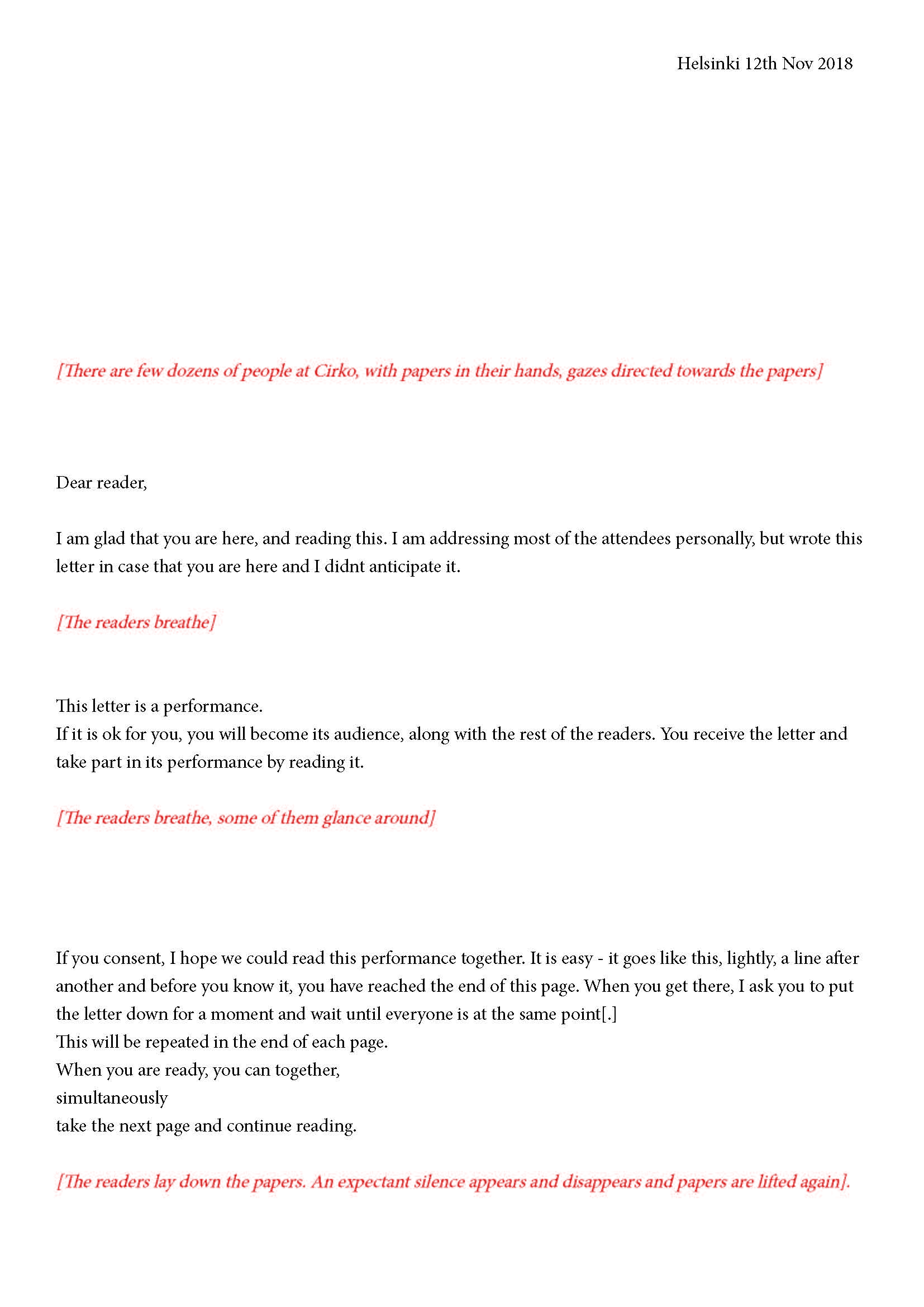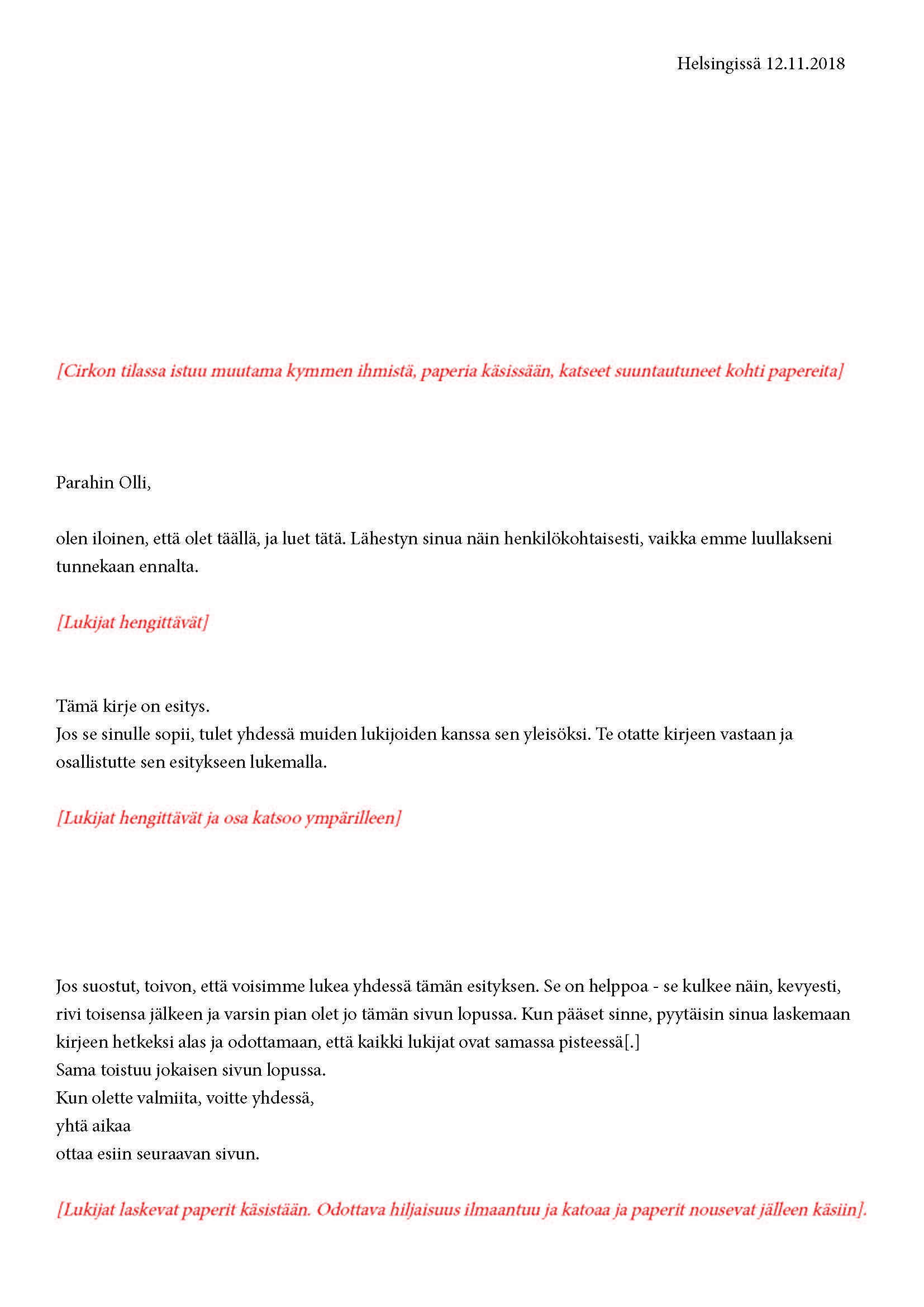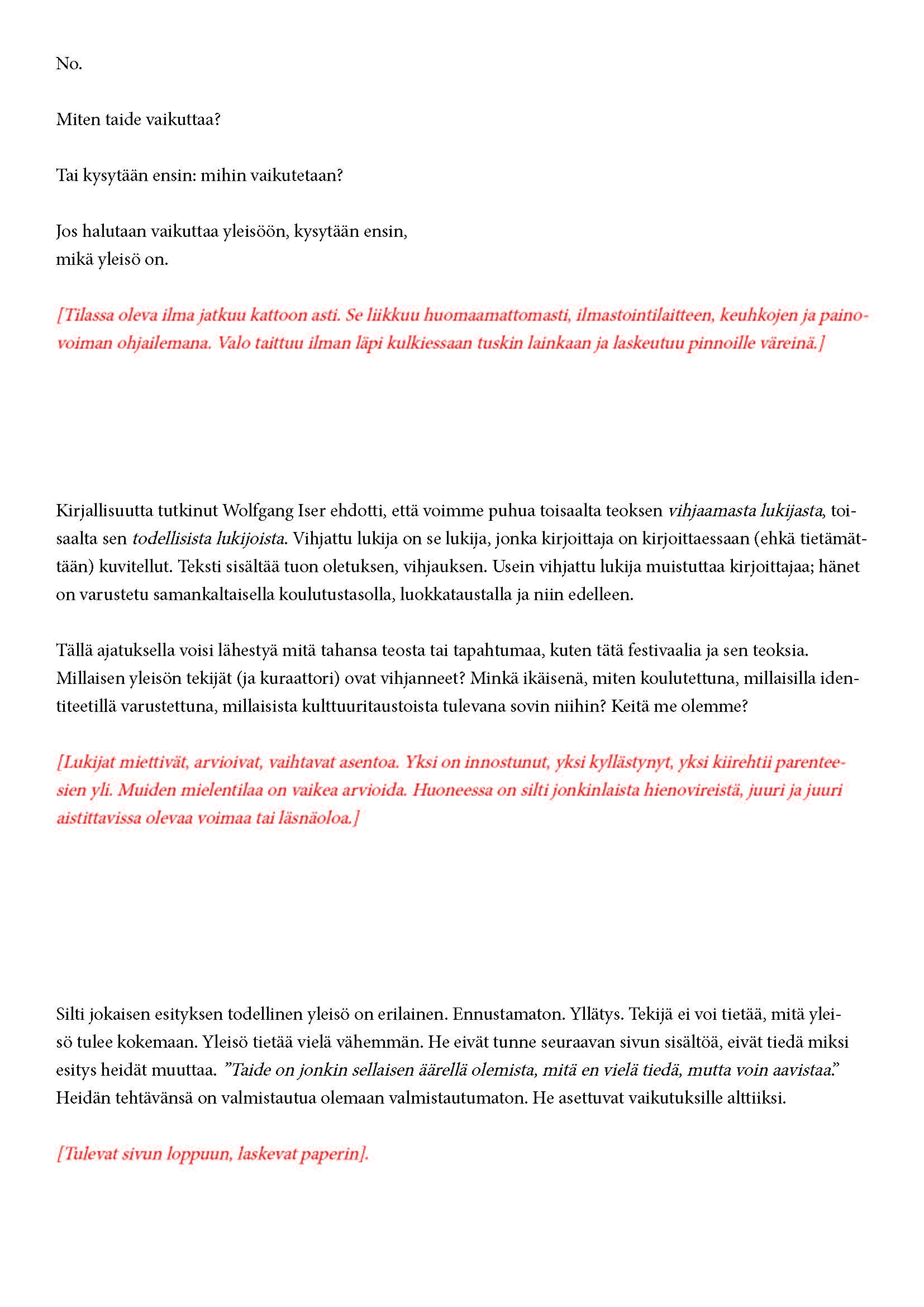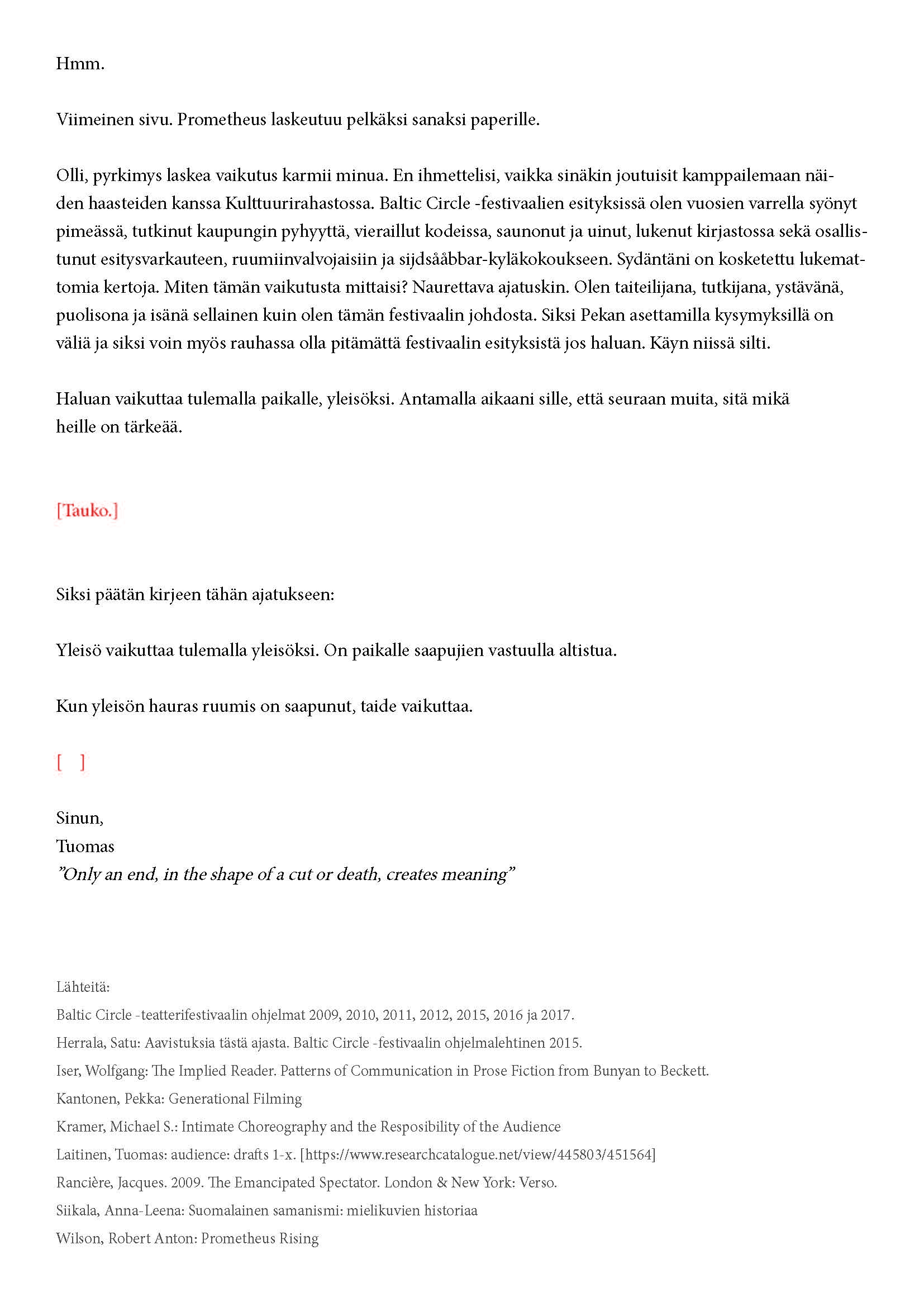Luonnos 1
Metodologinen pluralismi -seminaari, Esittävän taiteen tutkimuskeskus Tutke, Teatterikorkeakoulu, Helsinki 24.1.2018.
Ensimmäinen luonnos loi formaatin, jota olen käyttänyt kautta luonnossarjan: valmistin seminaarin osallistujille kirjallisen käsiohjelman, joka orientoi tapahtumaan. Tarkoituksenani oli esitellä tutkimustani metodologian näkökulmasta. Tämä ensimmäinen kokeilu poikkesi itse sarjasta sikäli, että en vielä ollut rajannut esiintyjäntyötä pois, ja teksti oli vain yksi osa koko presentaatiosta.
Käsiohjelman kannessa luki:
audience function
draft 1
sisäsivulla luki:
paragraph 1.
what do we want and why were we there
paragraph 2.
what are the questions
paragraph 3.
what then
Yleisön luonnostelua
Mikä yleisö on? Miksi esityksessä on yleisö? Väitöstutkimuksessani käsittelen näitä kysymyksiä ja pyrin luonnostelemaan teoreettista esitystä yleisöstä. Hahmottaakseni asiaa olen toteuttanut sarjan esityksellisiä luonnoksia, joissa yleisö katsoo itseään ja esitystilannetta. Näissä luonnoksissa yleisö on paikalla, mutta esitys, näyttämötapahtumien merkityksessä, puuttuu. Näyttämötapahtumien sijaan olen kussakin luonnoksessa valmistanut yleisölle tekstin, joka toimii käsikirjoituksena tai lukuohjeena. Valitsin tapahtumallisen tekstin, jotta voisin käsitellä esitystä sen tavanomaisessa ympäristössä, elävänä tapahtumana, ja samalla rakentaa teoriaa sen tavanomaisessa ympäristössä, tekstinä. Olen kokeillut luonnosteksteille erilaisia muotoja: käsiohjelma, kirje, vihko. Vaihtelua on myös siinä, puhuttelenko yleisöä enemmän ryhmänä vai yksilöinä sekä anonyymeinä vai tiettyinä henkilöinä. Toisissa luonnoksissa kaikilla on sama teksti, toisissa tekstejä on useita, joissain jokaisella on oma henkilökohtainen tekstinsä. Luonnokset ovat aina tilannesidonnaisia.
Metodologinen pluralismi -seminaari, Esittävän taiteen tutkimuskeskus Tutke, Teatterikorkeakoulu, Helsinki 24.1.2018.
Ensimmäinen luonnos
Praktikum-seminaari, Esittävän taiteen tutkimuskeskus Tutke, Teatterikorkeakoulu, Helsinki 16.2.2018.
Toinen luonnos koostui kahdestakymmenestä henkilökohtaisesta käsiohjelmasta, jotka ohjasivat osallistujat tutkimaan käynnissä olevaa tapahtumaa yleisöpositiosta käsin.
Tutkimusseminaari, Esittävän taiteen tutkimuskeskus Tutke Teatterikorkeakoulu, Helsinki 15.3.2018.
Danse Hallernen järjestämä Choreography in Action -tapahtuma, Kööpenhamina 9.4.2018.
Neljäs luonnoskompositio koostui kahdeksasta käsiohjelmasta.
Palestine Performance Symposium -tapahtuma, Kahlil Sakakini Cultural Center, Ramallah 8.5.2018.
Viidennessä luonnoskompositiossa kaikki osallistujat saivat saman käsiohjelman.
Summer Academy for Artistic Research, Inter Arts Center, Malmö 15.8.2018.
Kuudennessa luonnoskompositiossa osallistujat valitsivat kolmesta erilaisesta vihkosta.
Liikkeellä Marraskuussa -festivaali sekä Baltic Circle -teatterifestivaali, Helsinki, 3., 5. ja 13.11.2018.
Seitsemäs luonnoskompositio poikkesi sarjan muista sikäli, että näyttämö ei ollut tyhjä. Sen sijaan osallistujat saivat käsiohjelman ja menivät sen ohjaamina katsomaan kahden festivaalin ohjelmistoissa olevia esityksiä.
Kilo taidetta -seminaari, Baltic Circle -teatterifestivaali, Helsinki 14.11.2018.
Kahdeksas luonnoskompositio koostui kolmestakymmenestä kolmesta henkilökohtaisesta kirjeestä.
How to Do Things with Performance -tutkimushankkeen järjestämä Research Day III: Performance Pedagogy, Teatterikorkeakoulu, Helsinki 16.11.2018.
Yhdeksäs luonnoskompositio oli muistikirjan muodossa.
Luonnos 72
(dokumentaatio työn alla)
Luonnos 73
(dokumentaatio työn alla)
Fenomenologinen lukupiiri, Teatterikorkeakoulu, Helsinki
Luonnokset 74-86
(dokumentaatio työn alla)
Research Pavilion, Venetsian Biennaali, 7.5.-28.8.2019.
Luonnos 87
(dokumentaatio työn alla)
Katsojalähtöiset dramaturgiat -kurssi, Teatterikorkeakoulu, Helsinki. 20.5.2019.
Luonnos 88
(dokumentaatio työn alla)
Landing Sites -hankkeen residenssi, Saaren Kartano, Mynämäki, 27.6.2019.
Luonnokset 89-109
(dokumentaatio työn alla)
Future Manifestos, Artistic Doctorates in Europe -hanke, Uuden tanssin keskus Zodiak, Helsinki 31.8.2019.
Luonnokset 21-22
Tutkimusseminaari, Esittävän taiteen tutkimuskeskus Tutke Teatterikorkeakoulu, Helsinki 15.3.2018.
Luonnokset 21 ja 22 olivat samalla tavalla poikkeuksellisia kuin ensimmäinen luonnos, että käytin käsiohjelmatekstiä vain laajemman presentaation kehystämiseen. Osa osallistujista sai luonnoksen 21, osa luonnoksen 22. Luonnokset olivat identtisiä lukuunottamatta yhtä sanaa. Luonnoksen 21 lukijaa puhutteleva teksti päättyy toivotukseen "I hope will find ways of consenting". Luonnoksessa 22 vastaava lause on "I hope you will find ways of dissenting".
Käsiohjelmassa luki:
"Dear participant,
welcome to the Research Seminar. I wanted to make a program in paper format to have the context of performance present already from the start.
This does not have to mean anything more flamboyant than that. Quite the contrary, it allows me to give a voice to my past self, the one who is planning the presentation. It allows that past self to tune into you, to the quality of your presence in the presentation. That atunement fills me up with warmth.
It is here after all that we have chosen to drift. It is here that our past becomes present, tangible.
But. The question lingers. Why are you here? Why is the audience here? How can I tell, when I am not part of you?
I hope you will find ways of consenting.
Yours,
Tuomas"
Luonnos 31
Palestine Performance Symposium, Kahlil Sakakini Center, Ramallah, 8.5.2018
Viidennessä luennassa kaikki yleisön jäsenet saivat saman käsiohjelman.
Luenta oli osa Palestine Performance Symposiumia Recall - Reflect - Return. Symposium ajoittui Nakban (arab. "katastrofi"), Israelin valtion perustamisen myötä toteutetun palestinalaisväestön pakkosiirron, 70-vuotismuistopäivää edeltävälle viikolle. Se toteutettiin kolmessa paikassa Palestiinan alueella: Al Arroubin pakolaisleirillä, Betlehemissä sekä Ramallahissa.
Ramallahissa Kahlil Sakakini -kulttuurikeskuksessa järjestämässäni luennassa jokainen yleisön jäsen otti vastaan taitetun A4-arkin muotoisen käsiohjelman, joka oli saatavissa englanniksi ja arabiaksi.
Draft 31
Palestine Performance Symposium, Kahlil Sakakini Center, Ramallah, 8th of May 2018
In the fifth reading all audience members received the same program leaflet.
The reading was part of the program of Palestine Performance Symposium Recall - Reflect - Return. The symposium took place on the week preceding the 70th commemoration of Nakba (arab. "catastrophe"), the deportation of Palestine population in connection with the founding of the State of Israel. It was realized in three locations in Palestine: Al Arroub refugee camp, Betlehem and Ramallah.
In the reading which I organized at the Kahlil Sakakini cultural center in Ramallah, each audience member received a program leaflet in the format of a folded A4 paper, which was available in English and in Arabic.
عزيزي الجمهور
عند كتابتي لهذا النص، أتخيّل أنّني في فلسطين.
أتخيل أنّني اقرأه لكم في مركز خليل السكاكيني الثقافي. بينكم
أتخيل تقارب المسافة بين الوقت والمكان، وأنّني نفسي كجزء من ”نحن”. ”نحن” الموجودين الآن، والغائبين عند كتابتي للنص
الأمر ليس سهلًا. أستمر في تشتيت نفسي لعدم كتابتي لهذا النص، وإيجاد أعذار للقيام بشيء آخر. أغسل الصحون. أقوم بالتحضير للدرس. وألعب مع أطفالي
يؤلمني رأسي، أي شيء لألّا أفكر بفلسطين
الأمر يلاحقني. يقلب معدتي. من الصعب علي أن أفهم موقفي منه. كيف تكون لي علاقة بكارثة سمعت بها فقط؟ كيف أكون شاهداً على العنف من بعد؟ كيف أكون مسؤولاً؟
كيف أفهم وكيف أدعي الإكتراث؟ كيف، كيف، كيف؟
والآن، نحن هنا
Dear audience member,
When writing this, I imagine being in Palestine. I imagine being in the garden of Kahlil Sakakini Cultural Center, reading this text among you. Among us. I imagine this distance of time and space bridged, and myself as a part of an us. An ”us” that is now, when writing this, absent.
It is not easy. I keep distracting myself from writing this, finding excuses to do something else. I do the dishes. Prepare a class to teach. Play with my kids. Get a headache. Anything not to think about Palestine.
Because it haunts me. It turns my stomach around. It is increasingly hard to position myself in relation to it. How to take part in a catastrophe, of which I have only heard? How to witness violence from distance? How to take responsibility? How to understand, how to claim to care, how, how, how?
And now, we are here.
* * *
To honor that presence, I have a suggestion for you. I invite you to create something together, for a period of 30 minutes.
That something is the creation of an audience.
I propose that an audience is a way of conjuring a ”we”, a way of taking and giving power. As an audience I become complicit from distance, and thus a part, a member. It is a river and a bridge; a border and a union.
I propose our bodies step into 30 minutes of audience time
– a time not organized by me but by us –
a time to be with questions:
Who are we? What deserves our gaze? What is our part?
Before you start,
I ask you to close your eyes for a moment.
Take a few deep breaths.
The audience time starts at the moment when you open your eyes.
Once your eyes are open
you are free to move in the garden space
in the way you choose, for 30 minutes.
This time consists of the audience composing itself.
See you in the after-time.
Yours,
Tuomas
Ps. I suggest that we discuss after.
لتكريم وجودنا معا، لدي اقتراح لكم. أدعوكم لعمل ”شيء” سوياً، لمدة 30 دقيقة
.
وهذا ”الشيء” هو أن نخلق ”جمهور”
بنظري، أعتقد أن ”الجمهور” وسيلة لإحضار ”النحن”، وطريقة لأخذ وإعطاء القوة والسلطة
كوني جزءً من الجمهور، أصبح متواطئً عن بعد، وبالتالي أصبح جزءاً وعضواً. كنهرٍ وجسر; حدود واتحاد
اقترح أن نمضي ٣٠ دقيقة من وقتنا للدخول في ”وقت وعالم الجمهور”
وقت غير منظم من ”قبلي” بل من ”قبلنا”، نحن سوياً
وقت ”لنكون” مع الأسئلة التالية
من نحن؟ ماذا يستحق اهتمامنا؟ وما هو دورنا؟
قبل أن نبدأ
أطلب منكم أن تغلقوا أعينكم للحظة
خذوا نفساً عميقاً عدة مرات
يبدأ وقت الجمهور في اللحظة التي تفتحون فيها أعينكم
بمجرد أن تفتحوا أعينكم
أنتم أحرار في التحرك
بالطريقة التي تختارونها، لمدة ٣٠ دقيقة
هذا الوقت مخصص حتى يقوم الجمهور بتمالك نفسه
أراكم بعدها
شكرا
توماس
ملاحظة: أقترح المناقشة بعده
Luonnokset 2-20
Praktikum-seminaari, Esittävän taiteen tutkimuskeskus Tutke, Teatterikorkeakoulu, Helsinki 16.2.2018.
Toinen luonnos koostui kahdestakymmenestä henkilökohtaisesta käsiohjelmasta, jotka ohjasivat osallistujat tutkimaan käynnissä olevaa tapahtumaa yleisöpositiosta käsin.
Luonnos 71
How to Do Things with Performance -tutkimushankkeen järjestämä Research Day III: Performance Pedagogy, Teatterikorkeakoulu, Helsinki 16.11.2018.
Kuten luonnokset 32-34, myös luonnos 71 toimi ready-made-hengessä. Se toteutettiin jo olemassa olevan tapahtuman kerroksena, jolloin yleisö ei kokoontunut tyhjän näyttämön äärelle vaan tarkkaili kokemustaan tapahtuman yleisönä. Kun luonnoksissa 32-34 kyseinen tapahtuma oli teatteri- tai tanssiesitys, luonnoksessa 71 kyseessä oli tutkimusseminaari.
Laitoin seminaaripäivän alussa osallistujien joukkoon kiertämään tyhjän muistikirjan, jonka ensimmäisellä sivulla oli käyttöohje. Seminaarin päätteeksi otin kirjan talteen.
Drafts 2-20
Praktikum Seminari, Performing Arts Research Center Tutke, Theatre Academy, Helsinki, February 16th 2018.
The second draft composition consisted twenty personal program notes, which directed the participants to stury the event from the audience position. Each program addressed its reader by name, incorporated their own research questions and quoted their texts or texts they had previously referred to.
The drafts were either in Finnish or English, depending on the language skills of each participant.
Luonnokset 23-30
Danse Hallernen järjestämä Choreography in Action -tapahtuma, Kööpenhamina 9.4.2018.
Neljäs luonnoskompositio koostui kahdeksasta käsiohjelmasta.
Kahdeksas luenta koostui kolmestakymmenestä kolmesta henkilökohtaisesta kirjeestä.
Baltic Circle -festivaali järjesti osana ohjelmaansa taiteen vaikuttavuutta käsitelleen Kilo of Art -seminaarin, johon oli kutsuttu taiteilijoita, tutkijoita, rahoittajien edustajia ja muita taidealan vaikuttajia. Minulta tilattiin tilaisuuteen "interventio".
Pyysin tapahtuman järjestäjiltä osallistujalistan ja kirjoitin jokaiselle ilmoittautuneelle henkilökohtaisen kirjeen. Kirjeissä oli sama rakenne, joka toimii lukemisen dramaturgiana, sitoen lukijoita osin samaan rytmiin. Rakenteen sisällä tekstin sisältö osin vaihteli kirjeestä toiseen. Osan osallistujista tunsin etukäteen ja käytin yhteistä historiaamme ja tietojani heidän työstään materiaalina. Itselleni vieraista osallistujista otin selvää tutustumalla heidän työhönsä verkon kautta.
Tapahtumaan saapuessaan kukin osallistuja sai tapahtumaan saapuessaan kirjekuoren, jossa luki hänen nimensä sekä "Avaa klo 14.30".
Drafting the Audience
What is audience? Why is there an audience in performances?
In my artistic doctorate I process these questions and aim to draft a theoretical reading of audience. To approach the subject I have realized a series of performance drafts, in which the audience spectates itself and the event of audiencing. In these drafts the audience is present but the performance, in the sense of events on stage, is missing. Instead of events on stage I have in each event prepared a text to be read by the audience, which functions as a script or an orientation. I chose an event text as the medium to deal with performance in its habitual environment, as a live event, and simultaneously construct a theory in its habitual environment, as writing. I have experimented with different formats of textual drafts: program notes, letters, booklets. I have varied also whether I address the audience more as a collective or as individuals, and more as anonymous or particular individuals. In some of the drafts everyone has the same text, in some there are several to choose from, in some each audience member has a personalized text. All the drafts are situation specific.
Metodological pluralism -seminar, Performing Arts Research Center Tutke, Theatre Academy, Helsinki 24th of January 2018.
Practicum-seminar, Performing Arts Research Center Tutke, Theatre Academy, Helsinki 16th of February 2018.
Research Seminar, Performing Arts Research Center Tutke, Theatre Academy, Helsinki 15th of March 2018.
Choreography in Action -event organized by Danse Hallerne, Copenhagen 9th of April 2018.
Palestine Performance Symposium, Kahlil Sakakini Cultural Center, Ramallah 8th of May 2018.
Summer Academy for Artistic Research, Inter Arts Center, Malmö 15th of August 2018.
Moving in November dance festival and Baltic Circle theatre festival, Helsinki. 3rd, 5th and 13th of November 2018.
A Kilo of Art -seminar, Baltic Circle Theatre Festival, Helsinki. 14th of November 2018.
Research Day III: Performance Pedagogy, organized by the research project How to Do Things with Performance. Theatre Academy, Helsinki 16th of November 2018.
Draft 72
(documentation under construction)
at the performance Yleisö by Raekallio corp
Draft 73
(documentation under construction)
Fenomenological reading circle, Theatre Academy, Helsinki.
Drafts 74-86
(documentation under construction)
Research Pavilion, Venice Biennale, 7th of May - 28th of August 2019.
Draft 87
(documentation under construction)
Spectator-oriented dramaturgies. A course for MA students, Theatre Academy, Helsinki. 20th of May 2019.
Draft 88
(documentation under construction)
Landing Sites. A residence at Saari, Mynämäki. 27th of June 2019.
Drafts 89-109
(documentation under construction)
Future Manifestos, event organized by the project Artistic Doctorates in Europe, Zodiak Center for New Dance, Helsinki. 31st of August 2019.
the audience:
draft 2
dedicated to Karolina Kucia
[prologue]
Dear Karolina,
thank you for being here, refusing to be carried to a place of safety. Well, that’s a joke really (because we joke, don’t we) - this actually is quite a safe place. But I appriciate that sentence.
I have a proposal for you. I am interested in the creation of an audience -- as a collectivity of some sort. I hope you could help me a bit with it. Actually, already when reading this, you and the others are creating a plural entity that, if consenting, takes the form of an audience.
[act]
When you have finished reading the program, I ask you to enter the space. The act starts when you step through the door.
The act consists of the audience composing itself.
How is the audience born? What and why is it? How does it function? How could the concept of monstrosity relate to such form of organization? Who are we?
These are things that I do not understand; I hope that you will use the time of the act to bodily contemplate these questions. Or I hope that we will - myself included in this monster of an audience. That’s all. I hope the instructions suffice. The act will take less than 30 minutes.
[epilogue]
I am looking forward to discuss the above with you after the act.
Yours,
Tuomas
”We are soft and wet, impotent and feeble.”
the audience:
draft 23
the emancipated spectator
***
[prologue]
Dear member,
welcome to draft the audience with me. It is a pleasure to have you here.
I have a proposition for you. It is an invitation to create something together. The audience is a great interest and love of mine. Having arrived here, I assume it interests you as well. So, I would like to ask you to be my co-researcher for the following 30 minutes. Ok?
If you consent, here is how it works:
[act]
The French philosopher Jaqcues Ranciere writes that the reformists of theatre always want to activate the audience. He continues that this activation is redundant - the audience is never passive, or even better: the binary of active/passive is not what we need. The audience does not need liberation, they are already free.
Now, for the duration of 30 minutes, and in your own personal way, I would ask you to study these questions inspired by Ranciere:
Am I free as a spectator? How can I practice this freedom here and now?
The act starts at the moment when you step into to theatre space. During the act, you can use this space and time to practice your spectatorship in the way you choose.
The act consists of the audience composing itself.
Yours,
Tuomas
[epilogue]
P.S. After the act, there is a panel and a discussion.
Drafts 38-70
A Kilo of Art -seminar, Baltic Circle Theatre Festival, Helsinki 14th of November 2018
The eighth reading was composed of 33 personal letters.
The international Baltic Circle theatre festival organized as a part of its program a seminar on the influence of art, in which a collection of artists, reseachers, funders and other influencers were invited. I received a commission to realize an "intervention" into the event.
This book is a part of the doctoral research project by Tuomas Laitinen, titled The Question of the Audience. The project is realized as artistic research at the Performing Arts Research Center Tutke, Theatre Academy, Uniarts Helsinki. The main interests of the project are what is an audience, who are in the audience, why to audience and how to audience1.
When writing in this book anonymously you give your consent for the text to be sited anonymously and used anonymously according to the privacy notice.
When writing in the book with your name you give your consent for the text to be sited with your name and used according to the privacy notice.
The privacy notice is readable at the back of the book and available on the table by the auditorium door.
Contact
Tuomas Laitinen
phone: +358 xx xxxxxxx
email: tuomas.laitinen@uniarts.fi
audience: drafts 1-x -series available in Research Catalogue:
https://www.researchcatalogue.net/view/445803/451564
1 Audience is here used as a verb instead of the common use as a noun. This approach has been used previously also by Olive Bieringa and Otto Ramstad from BodyCartography Project.
I asked the organizers to provide me with a list of participants, based on which I wrote a personal letter to each registered attendee. The letters contained a shared structure, which functioned as a dramaturgy of reading, tying the readers into a partly similar rhythm. Within that structure the part of the content varied from a letter to a letter. Some of the participants I knew from beforehand and used our shared history and my information on their work as my material. In the case of the participants whom I did not know previously, I searched for the info online, familiarising myself with their work as much as possible.
As the particopants arrived to the event, they received an envelope, which was marked with their name and an instruction to "Open at 2.30pm".
yleisö:
luonnos 3
omistettu Esa Kirkkopellolle
[prologi]
Parahin Esa,
Kiitos kun tulit. Pidin kovasti maanantaiaamun sessiosta. Tuntuu, että osa niistä kysymyksistä, joita käsittelet, ovat lähellä minuakin. Tuli myös mieleen, että olen käynyt Toisissa tiloissa -esityksissä vuodesta 2004 lähtien.
Nyt minulla on ehdotus sinulle. Olen kiinnostunut yleisön synnystä, luomisesta ja luonteesta -- jonkinlaisena yhteisyytenä. Toivon, että voit auttaa minua siinä hieman. Itse asiassa, jo lukiessasi tätä luot yhdessä muiden kanssa monikollista olemusta. Suostuessaan se olemus ottaa yleisön muodon.
[näytös]
Pyydän sinua siirtymään tilaan, kun olet lukenut tämän käsiohjelman. Näytös alkaa sillä hetkellä, kun astut sisään.
Näytös koostuu yleisöstä, joka muodostaa itseään.
Miten yleisö syntyy? Mitä ja miksi se on? Miten se toimii? Tarvitseeko se näyttämön? Tai - mikä on sen institutionaalinen potentiaali?
Näitä asioita en ymmärrä ja toivonkin, että käytätte näytökseen varatun ajan näiden kysymysten ruumiilliseen pohdiskeluun. Tai käytämme - sallikaamme minut osaksi samaa yleisöä. Siinä kaikki. Näytös kestää alle 30 minuuttia.
[epilogi]
Odotan innolla, että sanat tulevat avuksemme ja pääsen keskustelemaan näistä asioista kanssanne näytöksen jälkeen.
Sinun,
Tuomas
”The target of it’s transformative effect is not in the receiving subject.”
the audience:
draft 24
the narcissistic participant
***
[prologue]
Dear member,
welcome to draft the audience with me. It is a pleasure to have you here.
I have a proposition for you. It is an invitation to create something together. The audience is a great interest and love of mine. Having arrived here, I assume it interests you as well. So, I would like to ask you to be my co-researher for the following 30 minutes. Ok?
If you consent, here is how it works:
[act]
The British theatre scholar Adam Alston compares the participants of immersive and participatory theatre to Narcissus, the mythical character that falls in love with his own reflection and eventually dies due to this self-absorbtion. Alston suggests that immersive theatre directs the attention of the participant to their own affective experience, rendering the audience into productive and narcissistic participants.
Now, for the duration of 30 minutes, and in your own personal way, I would ask you to study these questions inspired by Alston:
Am I a narcissistic participant? How to create the best experience for myself?
The act starts at the moment when you step into to theatre space. You are free to move and act in the space in the way you choose.
The act consists of the audience composing itself.
Yours,
Tuomas
[epilogue]
P.S. After the act, there is a panel and a discussion.
audience:
draft 71
how to audience
workbook
what is an audience?
In the context of a seminar, conference or research day, audience can be considered a counterpart to each speaker, lecturer, presenter, performer or such. Then the audience would be those who are present, but are not presenting at the moment. One way to check who are in the audience at any given moment is to read the program: the one whose name is mentioned along with the title of each session, is the one who is not in the audience. The rest of the attendees are.
what is this book for?
The purpose of this book is to gather observations, thoughts and ideas on how to audience. This aims to address a lack of pedagogical material on methods, practices or skills of audiencing. To respect the collective nature of most audiences the generation of such material is through this book opened as a collective endeavor.
how to use this book?
If and when you are at the moment in the audience, I invite you to describe the nature of this being in words. You are welcome to write these descriptions on the pages of this book. As help for writing, you may want to use following questions:
how does/did the audience appear?
how are we audiencing?
what is happening in/to the audience/us/me?
what do I/we sense?
what do I/we feel?
what do I/we do?
how am I a part?
how am I / are we related?
what does audiencing require from me/us?
Also, you are welcome to read what has already been written in the book and make use of any pedagogical, artistic or para-artistic information that these writings may contain, or any inspiration that they may offer to what you write.
When you are ready, please give the book to someone else in the audience.
yleisö:
luonnos 4
omistettu Pilvari Pirtolalle
[prologi]
Parahin Pilvari,
Kiitos kun tulit. Vastarinta vallan väärinkäyttölle ja auktoriteettiuskolle on tervetullutta ja kiinnostavaa tällaisissa muodoissa, joissa valtaa jaetaan ja kysytään.
No, minulla on ehdotus sinulle. Olen kiinnostunut yleisön luomisesta -- jonkinlaisena yhteisyytenä. Toivon, että voit auttaa minua siinä hieman, mikäli anarkismisi sen suo. Itse asiassa, jo lukiessasi tätä luot yhdessä muiden kanssa monikollista olemusta. Suostuessaan se olemus ottaa yleisön muodon.
[näytös]
Pyydän sinua siirtymään tilaan, kun olet lukenut tämän käsiohjelman. Näytös alkaa sillä hetkellä, kun astut sisään.
Näytös koostuu yleisöstä, joka muodostaa itseään.
Miten yleisö syntyy? Mitä ja miksi se on? Miten se toimii? Vastustaako se jotain?
Näitä asioita en ymmärrä ja toivonkin, että käytätte näytökseen varatun ajan näiden kysymysten ruumiilliseen pohdiskeluun. Tai käytämme - sallikaamme minut osaksi samaa yleisöä. Siinä kaikki. Näytös kestää alle 30 minuuttia.
[epilogi]
Odotan innolla, että pääsen keskustelemaan näistä asioista kanssanne näytöksen jälkeen.
Sinun,
Buckminster Fulleria muistaen,
Tuomas
”We live alone.”
the audience:
draft 25
the entrepreneural participant
***
[prologue]
Dear member,
welcome to draft the audience with me. It is a pleasure to have you here.
I have a proposition for you. It is an invitation to create something together. The audience is a great interest and love of mine. Having arrived here, I assume it interests you as well. So, I would like to ask you to be my co-researher for the following 30 minutes. Ok?
If you consent, here is how it works:
[act]
The British theatre scholar Adam Alston suggests that audiences of immersive theatre are offered a role as an entrepreneur, in line with neoliberal ethos. The ideal participant is then the self-starter, the independent, autonomous, motivated subject who is ready to take risks in order to receive more experiences.
Now, for the duration of 30 minutes, and in your own personal way, I would ask you to study these questions inspired by Alston:
How can I practice entrepreneuralism in my participation? How to become the autonomous risk-taker?
The act starts at the moment when you step into to theatre space. You are free to move and act in the space in the way you choose.
The act consists of the audience composing itself.
Yours,
Tuomas
[epilogue]
P.S. After the act, there is a panel and a discussion.
yleisö:
luonnos 5
omistettu Henna Lainiselle
[prologi]
Parahin Henna,
Hienoa, että olet täällä, tarvitsemme uskoa maailman hyvyyteen ja rakentavan muutoksen mahdollisuuteen. Sellaista ainakin sinussa aistin. Terveisiä myös anopinkieleltä.
Minulla on ehdotus sinulle. Olen kiinnostunut yleisön luomisesta ja luonteesta -- jonkinlaisena yhteisyytenä. Toivon, että voit auttaa minua siinä hieman. Itse asiassa, jo lukiessasi tätä luot yhdessä muiden kanssa monikollista olemusta. Suostuessaan se olemus ottaa yleisön muodon.
[näytös]
Pyydän sinua siirtymään tilaan, kun olet lukenut tämän käsiohjelman. Näytös alkaa sillä hetkellä, kun astut sisään.
Näytös koostuu yleisöstä, joka muodostaa itseään.
Miten yleisö syntyy? Mitä ja miksi se on? Miten se toimii? Tai kuten sinua kuunneltuaan voisi kysyä, millainen yleisö on ekologisesti kestävä? Millainen voisi olla mytologinen yleisö?
Näitä asioita en ymmärrä ja toivonkin, että käytätte näytökseen varatun ajan näiden kysymysten ruumiilliseen pohdiskeluun. Tai käytämme - sallikaamme minut osaksi samaa . Siinä kaikki. Toivon, että tämä ohjeistus riittää. Näytös kestää alle 30 minuuttia.
[epilogi]
Odotan innolla, että pääsen keskustelemaan näistä asioista kanssanne näytöksen jälkeen.
Sinun,
Tuomas
”...an artistic response to the crumbling of the empires of the mind [...] we believe it is time to look down.”
the audience:
draft 26
dissensus
***
[prologue]
Dear member,
welcome to draft the audience with me. It is a pleasure to have you here.
I have a proposition for you. It is an invitation to create something together. The audience is a great interest and love of mine. Having arrived here, I assume it interests you as well. So, I would like to ask you to be my co-researher for the following 30 minutes. Ok?
If you consent, here is how it works:
[act]
The French philosopher Jaqcues Rancière bases his political philosophy on the idea of dissensus. Dissensus is the opposite of consensus; it is disagreement on the level of sensing, of distribution of the sensible. ”The essence of politics is the manifestation of dissensus as the presence of two worlds in one”, writes Rancière.
Now, for the duration of 30 minutes, and in your own personal way, I would ask you to study these questions inspired by Rancière:
How does dissensus appear here? How can I dissent?
The act starts at the moment when you step into to theatre space. You are free to move and act in the space in the way of your choice.
The act consists of the audience composing itself.
Yours,
Tuomas
[epilogue]
P.S. After the act, there is a panel and a discussion.
yleisö:
luonnos 6
omistettu Jaakko Ruuskalle
[prologi]
Parahin Jaakko,
Kiitos kun tulit. Kymen tehtaalta kohti metsää kulkenut kamera-ajo oli kaunis, se on kulkenut mukanani tällä viikolla. On hyvä tietää, että silmäsi on täällä.
Minulla on ehdotus sinulle. Olen kiinnostunut yleisön synnystä, luomisesta tai luonteesta -- jonkinlaisena yhteisyytenä. Toivon, että voit auttaa minua siinä hieman. Itse asiassa, jo lukiessasi tätä luot yhdessä muiden kanssa monikollista olemusta. Suostuessaan se olemus ottaa yleisön muodon.
[näytös]
Pyydän sinua siirtymään tilaan, kun olet lukenut tämän käsiohjelman. Näytös alkaa sillä hetkellä, kun astut sisään.
Näytös koostuu yleisöstä, joka muodostaa itseään.
Miten yleisö syntyy? Mitä ja miksi se on? Miten se toimii? Tarvitseeko se näyttämön?
Näitä asioita en ymmärrä ja toivonkin, että käytätte näytökseen varatun ajan näiden kysymysten ruumiilliseen pohdiskeluun. Tai käytämme - suokaamme minullekin paikka yleisössä. Siinä kaikki. Näytös kestää alle 30 minuuttia.
[epilogi]
Odotan innolla, että pääsen keskustelemaan näistä asioista kanssanne näytöksen jälkeen.
Sinun,
Tuomas
”Experience unfolds as a sphere of simultaneity, where the viewer can share the experience with the seen body.”
the audience:
draft 27
autopoietic loop
***
[prologue]
Dear member,
welcome to draft the audience with me. It is a pleasure to have you here.
I have a proposition for you. It is an invitation to create something together. The audience is a great interest and love of mine. Having arrived here, I assume it interests you as well. So, I would like to ask you to be my co-researher for the following 30 minutes. Ok?
If you consent, here is how it works:
[act]
The German theatre scholar Erika Fischer-Lichte suggests that performance has transformative power. According to her, this power is due to an autopoietic feedback loop that operates in the event of a performance. Something travels between the stage and the auditorium, between the performers and the audience, back and forth, in a loop, transforming everyone present.
Now, for the duration of 30 minutes, and in your own personal way, I would ask you to study these questions inspired by Fischer-Lichte:
Does a feedback loop appear here? Can I take part in its creation or destruction? Can we transform?
The act starts at the moment when you step into to theatre space. You are free to move and act in the space in the way you choose.
The act consists of the audience composing itself.
Yours,
Tuomas
[epilogue]
P.S. After the act, there is a panel and a discussion.
yleisö:
luonnos 7
omistettu Outi Conditille
[prologi]
Parahin Outi,
Kiitos kun tulit. Tuntuu lämpimältä, että täällä on joku, joitakin, joiden kanssa on jo vuosien tausta, joiden kanssa polut ovat leikanneet tai rinnastuneet eri kohdissa.
Minulla on ehdotus sinulle. Olen kiinnostunut yleisön synnystä, luomisesta ja luonteesta -- jonkinlaisena yhteisyytenä. Toivon, että voit auttaa minua siinä hieman. No, jo lukiessasi tätä luot yhdessä muiden kanssa monikollista olemusta. Suostuessaan se olemus ottaa yleisön muodon.
[näytös]
Pyydän sinua siirtymään tilaan, kun olet lukenut tämän käsiohjelman. Näytös alkaa sillä hetkellä, kun astut sisään.
Näytös koostuu yleisöstä, joka muodostaa itseään.
Miten yleisö syntyy? Mitä ja miksi se on? Miten se toimii? Tai - miten sen ruumiit asettuvat, miten yleisön ruumis muodostuu? Millaista on katsomoiden ruumiillinen politiikka?
Näitä asioita en ymmärrä ja toivonkin, että käytätte näytökseen varatun ajan kysymysten ruumiilliseen pohdiskeluun; tangentilla tai ilman. Tai käytämme - sallikaamme minut osaksi samaa yleisöä. Siinä kaikki. Toivon, että ohjeistus riittää. Näytös kestää alle 30 minuuttia.
[epilogi]
Odotan innolla, että pääsen keskustelemaan näistä asioista kanssasi näytöksen jälkeen.
Sinun,
Tuomas
”Gestures and desires, super-exposed, turn in on themselves. The performance that happens to itself, overabout me know.”
the audience:
draft 28
co-understanding
***
[prologue]
Dear member,
welcome to draft the audience with me. It is a pleasure to have you here.
I have a proposition for you. It is an invitation to create something together. The audience is a great interest and love of mine. Having arrived here, I assume it interests you as well. So, I would like to ask you to be my co-researher for the following 30 minutes. Ok?
If you consent, here is how it works:
[act]
The German theatre scholar Hans-Thies Lehmann suggests, that viewing in theatre is co-viewing, understanding is co-understanding - to understand individually is not the same as to understand together. ”At the moment I believe to understand something in a performance, [...] I am also identifying with the possible, virtual significance that this may have for the others”, Lehmann says.
Now, for the duration of 30 minutes, and in your own personal way, I would ask you to study these questions inspired by Lehmann:
How am I co-viewing? What and how do I understand together with the whole of the audience?
The act starts at the moment when you step into to theatre space. You are free to move and act in the space in the way you choose.
The act consists of the audience composing itself.
Yours,
Tuomas
[epilogue]
P.S. After the act, there is a panel and a discussion.
yleisö:
luonnos 8
omistettu Merja Briñón’lle
[prologi]
Parahin Merja,
Onneksi olet täällä, tuonpuoleista kantamassa. Minulle on tärkeää, että joku muistaa sen. Toivottavasti se tulee läsnäolevaksi.
Minulla on ehdotus sinulle. Olen kiinnostunut yleisön luomisesta -- jonkinlaisena yhteisyytenä. Toivon, että voit auttaa minua siinä hieman. Itse asiassa, jo lukiessasi tätä luot yhdessä muiden kanssa monikollista olemusta. Suostuessaan se olemus ottaa yleisön muodon.
[näytös]
Pyydän sinua siirtymään tilaan, kun olet lukenut tämän käsiohjelman. Näytös alkaa sillä hetkellä, kun astut sisään.
Näytös koostuu yleisöstä, joka muodostaa itseään.
Miten yleisö syntyy? Mitä ja miksi se on? Miten se toimii? Tai kuten sinä ehkä voisit kysyä - missä se ylittää ajan? Voiko yleisölle avata loven, johon langeta?
Näitä asioita en ymmärrä ja toivonkin, että käytätte näytökseen varatun ajan näiden kysymysten ruumiilliseen pohdiskeluun. Tai käytämme - sallikaamme minut osaksi samaa yleisöä. Siinä kaikki. Toivon, että tämä riittää ohjeeksi. Näytös kestää alle 30 minuuttia.
[epilogi]
Odotan innolla, että pääsen keskustelemaan näistä asioista kanssanne näytöksen jälkeen.
Sinun,
Tuomas
”[...] teos on matka aliseen ja tähän maailmaan sekä elämän loputtomaan kiertokulkuun.”
the audience:
draft 29
community without community
***
[prologue]
Dear member,
welcome to draft the audience with me. It is a pleasure to have you here.
I have a proposition for you. It is an invitation to create something together. The audience is a great interest and love of mine. Having arrived here, I assume it interests you as well. So, I would like to ask you to be my co-researher for the following 30 minutes. Ok?
If you consent, here is how it works:
[act]
The French philosopher Jean-Luc Nancy suggests, that we have not lost the sense of community. Instead he says that there never was a ”we” that had something in common. On the contrary, for Nancy, only thing in common that we have is that we do not have something in common. Lack of community is what draws us together, to become ”us”.
Now, for the duration of 30 minutes, and in your own personal way, I would ask you to study these questions inspired by Nancy:
Is there a ”we” here? If so, how does it appear? Who are we?
The act starts at the moment when you step into to theatre space. You are free to move and act in the space in the way you choose.
The act consists of the audience composing itself.
Yours,
Tuomas
[epilogue]
P.S. After the act, there is a panel and a discussion.
Luonnokset 35-37
Liikkeellä Marraskuussa -festivaali sekä Baltic Circle -teatterifestivaali, Helsinki, 3., 5. ja 13.11.2018.
Seitsemäs luonnoskompositio poikkesi sarjan muista sikäli, että näyttämö ei ollut tyhjä. Sen sijaan osallistujat saivat käsiohjelman ja menivät sen ohjaamina katsomaan kahden festivaalin ohjelmistoissa olevia esityksiä.
yleisö:
luonnos 9
omistettu Samuli Nordbergille
[prologi]
Parahin Samuli,
Kiitos kun tulit. On hienoa, että paikalla on yksi kaustislainen, yksi jonka koriassa ruumiissa on jotain samoja juurteita kuin omassa. Mitä sellainen kietouma sitten tuokaan tähän.
Olisi ehdotus sinulle. Olen kiinnostunut yleisön synnystä tai luomisesta -- jonkinlaisena yhteisyytenä. Toivon, että voit auttaa minua siinä hieman. Ja niin, jo lukiessasi tätä luot yhdessä muiden kanssa monikollista olemusta. Suostuessaan se olemus ottaa yleisön muodon.
[näytös]
Pyydän sinua siirtymään tilaan, kun olet lukenut tämän käsiohjelman. Näytös alkaa sillä hetkellä, kun astut sisään.
Näytös koostuu yleisöstä, joka muodostaa itseään.
Miten yleisö syntyy? Mitä ja miksi se on? Miten se toimii? Tai kuten sinä ehkä voisit kysyä - miten se toimii kollektiivina ja miten sen toimijuus jakaantuu?
Näitä asioita en ymmärrä ja toivonkin, että käytätte näytökseen varatun ajan näiden kysymysten ruumiilliseen pohdiskeluun. Tai käytämme - sallikaamme minut osaksi samaa yleisöä. Siinä kaikki. Toivon, että tämä riittää ohjeeksi. Näytös kestää alle 30 minuuttia.
[epilogi]
Odotan innolla, että pääsen keskustelemaan näistä asioista kanssasi näytöksen jälkeen.
Sinun,
Tuomas
”A new actor is created, a hybrid composed of both human and space; both individual and group; both group and space.”
the audience:
draft 30
aesthetic
***
[prologue]
Dear member,
welcome to draft the audience with me. It is a pleasure to have you here.
I have a proposition for you. It is an invitation to create something together. The audience is a great interest and love of mine. Having arrived here, I assume it interests you as well. So, I would like to ask you to be my co-researher for the following 30 minutes. Ok?
If you consent, here is how it works:
[act]
The American art scholar Claire Bishop suggests that the discourse on participatory art easily collapses into sociology and ethical questions. Instead, she emphasises the aesthetic -- ”in the sense of aisthesis: an autonomous regime of experience that is not reducible to logic, reason or morality”.
Now, for the duration of 30 minutes, and in your own personal way, I would ask you to study these questions inspired by Bishop:
What kind of aesthetics appear in this event? How am I, how are we aesthetic as an audience?
The act starts at the moment when you step into to theatre space. You are free to move and act in the space in the way you choose.
The act consists of the audience composing itself.
Yours,
Tuomas
[epilogue]
P.S. After the act, there is a panel and a discussion.
Hyvä yleisön jäsen,
mukava, että olet täällä. Olemme nyt menossa katsomaan esitystä yhdessä. Minulla olisi kaksi pyyntöä:
toivoisin, että seuraat esitystä haluamallasi tavalla ja kirjoitat sen jälkeen näille sivuille jotain siitä, mitä tapahtui. Viereisellä sivulla on muutamia ehdotuksia siitä, mitä ja miten voit kirjoittaa, käytä niitä jos haluat.
sitten toivoisin, että lukisit ohessa olevat tiedot tutkimukseen osallistuvalle ja allekirjoittaisit suostumuslomakkeen.
Sinun,
Tuomas
the audience:
draft 10
dedicated to Stephanie Misa
[prologue]
Dear Stephanie,
thank you for being here. It is relieving to have such intellect in the room.
With that thought in mind, I have a proposal for you. I am interested in the creation of an audience -- as a collectivity of some sort. I hope you could help me a bit with it. Actually, already when reading this, you and the others are creating a plural entity that, if consenting, takes the form of an audience.
[act]
When you have finished reading the program, I ask you to enter the space. The act starts when you step through the door.
The act consists of the audience composing itself.
How is the audience born? What and why is it? How does it function? Or in relation to your questions, could archipelagic thinking help our understanding of the audience? And what is taken for granted in the eurocentric context in relation to audiences?
This is something that I do not understand. I hope that you will use the time of the act to bodily contemplate these questions. Or I hope that we will - myself as a part of that multitude. That’s all. The act will take less than 30 minutes.
[epilogue]
I am looking forward to discuss the above with you after the act.
Yours,
Tuomas
”We refuse to be what you want us to be, we are what we are, and that’s the way it’s going to be.”
Tutkimuskysymys:
Miten olemme yleisö?
Ehdotan, että kun kirjoitat, käytät persoonia me ja/tai minä sekä aika-muotona preesensiä: ”olemme”, ”olen”, ”istumme”, ”näen” jne.
Apuna voit käyttää myös lisäkysymyksiä, esim. Mitä aistin? Mitä tapahtuu? Miltä tuntuu? Miten olen yleisön osa? Miten olemme/olen tilassa? Miten toimimme/toimin? Miten olemme/olen suhteessa näyttämöön?
Huom! Nämä ovat ehdotuksia, voit kirjoittaa myös ihan toisin!
yleisö:
luonnos 11
omistettu Mika Elolle
[prologi]
Parahin Mika,
Kiitos kun tulit. Sitä rauhaa, empatiaa ja viisautta ei voi koskaan olla liikaa.
Tässä olisi ehdotus sinulle. Olen kiinnostunut yleisön synnystä, luomisesta ja luonteesta -- jonkinlaisena yhteisyytenä. Toivon, että voit auttaa minua siinä hieman. Itse asiassa, jo lukiessasi tätä luot yhdessä muiden kanssa monikollista olemusta. Suostuessaan se olemus ottaa yleisön muodon.
[näytös]
Pyydän sinua siirtymään tilaan, kun olet lukenut tämän käsiohjelman. Näytös alkaa sillä hetkellä, kun astut sisään.
Näytös koostuu yleisöstä, joka muodostaa itseään.
Miten yleisö syntyy? Mitä ja miksi se on? Miten se toimii? Tai kuten sinä voisit sanoa - mitä tämä apparaatti ehdottaa?
Näitä asioita en ymmärrä ja toivonkin, että käytätte näytökseen varatun ajan näiden kysymysten ruumiilliseen pohdiskeluun. Tai käytämme - sallikaamme minut osaksi samaa yleisöä. Siinä kaikki. Näytös kestää alle 30 minuuttia.
[epilogi]
Odotan innolla, että pääsen keskustelemaan näistä asioista kanssasi näytöksen jälkeen.
Sinun,
Tuomas
”Katsojan täytyy tunnistaa paikkansa tällä näyttämöllä,
asettua kohtaan,[...] josta käsin kyseinen illuusio näyttäytyy.”
Hyvä yleisön jäsen,
mukava, että olet täällä. Olemme nyt menossa katsomaan esitystä yhdessä. Minulla olisi kaksi pyyntöä:
toivoisin, että seuraat esitystä haluamallasi tavalla ja kirjoitat sen jälkeen näille sivuille jotain siitä, mitä YLEISÖLLE eli meille tai sinulle tapahtui. Viereisellä sivulla on muutamia ehdotuksia siitä, mitä ja miten voit kirjoittaa, käytä niitä jos haluat.
sitten toivoisin, että lukisit ohessa olevan tietosuojailmoituksen ja allekirjoittaisit suostumuslomakkeen.
Sinun,
Tuomas
yleisö:
luonnos 12
omistettu Saara Hannulalle
[prologi]
Parahin Saara,
Sinulle on ihan erilaista kirjoittaa kirjettä kuin näille muille. Olen kirjoittanut sinulle niin monta kirjettä joskus, satoja. Rakkauskirjeitä. Ehkä se henkilökohtaisuus tuo jotain olennaista tähän. Onko tutkimuskaan niin tärkeää, jos ihmiset ovat läpäisseet toisensa?
Ehdotan silti jotain. Olen kiinnostunut yleisön synnystä tai luomisesta -- jonkinlaisena yhteisyytenä. Toivon, että voit auttaa minua siinä hieman. Jo lukiessasi tätä luot yhdessä muiden kanssa monikollista olemusta. Suostuessaan se olemus ottaa yleisön muodon.
[näytös]
Pyydän sinua siirtymään tilaan, kun olet lukenut tämän käsiohjelman. Näytös alkaa sillä hetkellä, kun astut sisään.
Näytös koostuu yleisöstä, joka muodostaa itseään.
Miten yleisö syntyy? Mitä ja miksi se on? Miten se toimii? Tai kuten voisit ehkä kysyä - miten yleisö syntyy antroposentrismin jälkeisellä ajalla? Mitä on yleisön energia?
Näitä asioita en ymmärrä ja toivonkin, että käytätte näytökseen varatun ajan kysymysten ruumiilliseen pohdiskeluun. Tai käytämme - sallikaamme minut osaksi samaa materiaalisuutta. Siinä kaikki. Näytös kestää alle 30 minuuttia.
[epilogi]
Odotan innolla, että pääsen keskustelemaan näistä asioista kanssasi näytöksen jälkeen.
Sinun,
Tuomas
”To yet another side / To become this and that / We are”
Näyttämötapahtumien sijaan pyri kuvailemaan sitä,
MITEN OLEMME YLEISÖ?
Apuna voit käyttää myös lisäkysymyksiä, esim.
Mitä aistin? Mitä tapahtuu? Miltä tuntuu?
Miten olen yleisön osa? Miten olemme/olen tilassa? Miten toimimme/toimin? Miten olemme/olen suhteessa näyttämöön?
the audience:
draft 13
dedicated to Max McBride
[prologue]
Dear maxing,
thank you for being here. I cheriss the fact that we have things that we do not speak about here, even if they are artistic. I’m sure you are able to animate any secrecy, right?
Whatever that might mean, I have a proposal for you. I am interested in the creation of an audience -- as a collectivity of some sort. I hope you could help me a bit with it. Actually, already when reading this, you and the others are creating a plural entity that, if consenting, takes the form of an audience.
[act]
When you have finished reading the program, I ask you to enter the space. The act starts when you step through the door.
The act consists of the audience composing itself.
How is the audience born? What and why is it? How does it function? How is it animated and who is animating who? What is the matter of audience?
This is something that I do not understand. I hope that you will use the time of the act to bodily contemplate these questions. Or that we will - myself as a part of that materiality. That’s all. The act will take less than 30 minutes.
[epilogue]
I am looking forward to discuss the above with you after the act.
Yours,
Tuomas
”[...] any visible, tangible form that meets my gaze may also be
an experiencing subject.”
Hyvä yleisön jäsen,
mukava, että olet täällä. Olemme nyt menossa katsomaan esitystä yhdessä. Minulla olisi kaksi pyyntöä:
toivoisin, että seuraat esitystä haluamallasi tavalla ja kirjoitat sen jälkeen näille sivuille jotain siitä, mitä YLEISÖLLE eli meille tai sinulle tapahtui. Viereisellä sivulla on muutamia ehdotuksia siitä, mitä ja miten voit kirjoittaa, käytä niitä jos haluat.
sitten toivoisin, että lukisit ohessa olevan tietosuojailmoituksen ja allekirjoittaisit suostumuslomakkeen.
Sinun,
Tuomas
yleisö:
luonnos 14
omistettu Tuire Collianderille
[prologi]
Parahin Tuire,
Kiitos kun tulit. Toivottavasti oma ekspositiosi meni hyvin. Kuulosti osuvalta ja jännittävältä, että tuot lapsesi mukaan. Toivottavasti olette molemmat yhä täällä.
Minulla on ehdotus sinulle tai teille. Olen kiinnostunut yleisön synnystä tai luomisesta -- jonkinlaisena yhteisyytenä. Toivon, että voit auttaa minua siinä hieman. Jo lukiessasi tätä luot yhdessä muiden kanssa jonkinlaista monikollista olemusta. Suostuessaan se olemus ottaa yleisön muodon.
[näytös]
Pyydän sinua siirtymään tilaan, kun olet lukenut tämän käsiohjelman. Näytös alkaa sillä hetkellä, kun astut sisään.
Näytös koostuu yleisöstä, joka muodostaa itseään.
Miten yleisö syntyy? Mitä ja miksi se on? Miten se toimii? Tai kuten sinun kanssasi voisi kysyä, onko yleisönä oleminen lapsille jotain muuta kuin aikuisille?
Näitä asioita en ymmärrä ja toivonkin, että käytätte näytökseen varatun ajan kysymysten ruumiilliseen pohdiskeluun. Tai käytämme - mukaanlukien minut osaksi samaa yleisöä. Siinä kaikki. Näytös kestää alle 30 minuuttia.
[epilogi]
Odotan innolla, että pääsen keskustelemaan näistä asioista kanssanne näytöksen jälkeen.
Sinun,
Tuomas
”This is a game; I am hereby placing myself on a different register of existence.”
Näyttämötapahtumien sijaan pyri kuvailemaan sitä,
MITEN OLEMME YLEISÖ?
Apuna voit käyttää myös lisäkysymyksiä, esim.
Miten yleisö syntyy? Mitä aistin / aistimme? Mitä tapahtuu? Miltä
tuntuu? Miten olen yleisön osa? Miten olemme/olen tilassa? Miten toimimme/toimin? Miten olemme/olen suhteessa näyttämöön?
the audience:
draft 15
dedicated to Erick Beltran Flores
[prologue]
Dear Erick,
thank you for being here. It is great that the cornucopic imageologic universes that your mind seems to access are present here.
To set them free, I have a proposal for you. I am interested in the creation of an audience -- as a collectivity of some sort. I hope you could help me a bit with it. When reading this, you and the others are creating a plural entity that, if consenting, takes the form of an audience.
[act]
When you have finished reading the program, I ask you to enter the space. The act starts when you step through the door.
The act consists of the audience composing itself.
How is the audience born? What and why is it? How does it function? What does the ’multiplicity in one’, in your words, mean here and how is it exposed?
These are things that I do not understand and would need some help with. I hope that you will use the time of the act to bodily contemplate these questions. Or I hope that we will - myself included in this monster of an audience. That’s all. The act will take less than 30 minutes.
[epilogue]
I am looking forward to discuss the above with you after the act.
Yours,
Tuomas
”Reading from the periphery towards the center.”
Dear audience member,
so nice that you are here. We are about to go and attend a performance together. I have two requests:
I ask you to follow the performance in the way you choose and then write on these pages something about what happened to
the AUDIENCE, i.e. we or you. On the right-hand page there are some suggestions on what and how to write. Use them if possible.
then I ask you to read the attached data proctection information and sign the consent form.
Yours,
Tuomas
the audience:
draft 16
dedicated to Gabriele Goria
[prologue]
Dear Gabriele,
thank you for being here. I value the presence of a meditator. Maybe there is a way to use your experience for the benefit of this exposition, who knows.
Anyway, I have a proposal for you. I am interested in the creation of an audience -- as a collectivity of some sort. I hope you could help me a bit with it. Actually, already when reading this, you and the others are creating a plural entity that, if consenting, takes the form of an audience.
[act]
When you have finished reading the program, I ask you to enter the space. The act starts when you step through the door.
The act consists of the audience composing itself.
How is the audience born? What and why is it? How does it function? Does it need a stage? Is being an audience a meditation of sorts or how can it become such?
This is something that I do not understand. I hope that you will use the time of the act to bodily contemplate these questions. Or I hope that we will - myself as a part of that meditative (?) comstellation. That’s all. The act will take less than 30 minutes.
[epilogue]
I am looking forward to discuss the above with you after the act.
Yours,
Tuomas
“It’s not enough to be compassionate. We must act!”
Instead of events on stage, describe
HOW ARE WE AN AUDIENCE?
You may use the following questions as extra help:
How does the audience appear? What do I / we perceive? What is happening? How does it feel? How am I a part of the audience? How are we / am I in the space? How do I / we act? How are we / am I in relation to the stage?
yleisö:
luonnos 17
omistettu Tuomas Laitiselle
[prologi]
Parahin Tuomas,
Kiitos kun tulit. Tätä onkin jännittävää kirjoittaa. Tiedät kirjeen sisällön jo ennalta, joten noidankehästä ei pääse eroon. Tämä on tutkijan paradoksi, jota en voi olla käsittelemättä. Toivon, että pääset osaksi yleisöä.
Minulla on ehdotus sinulle. Olen kiinnostunut yleisön luomisesta -- jonkinlaisena yhteisyytenä. Toivon, että voit auttaa minua siinä hieman. Itse asiassa, jo lukiessasi tätä luot yhdessä muiden kanssa monikollista olemusta. Suostuessaan se olemus ottaa yleisön muodon.
[näytös]
Pyydän sinua siirtymään tilaan, kun olet lukenut tämän käsiohjelman. Näytös alkaa sillä hetkellä, kun astut sisään.
Näytös koostuu yleisöstä, joka muodostaa itseään.
Miten yleisö syntyy? Mitä ja miksi se on? Miten se toimii?
Näitä asioita en ymmärrä ja toivonkin, että käytätte näytökseen varatun ajan näiden kysymysten ruumiilliseen pohdiskeluun. Siinä kaikki. Näytös kestää alle 30 minuuttia.
[epilogi]
Odotan innolla, että pääsen keskustelemaan näistä asioista muidenkin kanssa näytöksen jälkeen.
Sinun,
Tuomas
”Neula puhkaisi reiän paitsi Dionysoksen nänniin, myös esityksellisyyden metaforisten rakenteiden läpi.”
yleisö:
luonnos 18
omistettu Katariina Nummiselle
[prologi]
Parahin Katariina,
Kiitos kun tulit. Dramaturginen näkökulma palaa toistuvasti mieleeni, se miten tutkimukselliset eleet ja prosessit rakentuvat dramaturgisesti. Kun näitä asioita miettii, on arvokasta olla sinun työsi vaikutuspiirissä. No, on ilo tuntea sinut muutenkin.
Nyt minulla on ehdotus sinulle. Olen kiinnostunut yleisön synnystä, luomisesta tai paljastumisesta -- jonkinlaisena yhteisyytenä. Toivon, että voit auttaa minua siinä hieman. Itse asiassa, jo lukiessasi tätä luot yhdessä muiden kanssa monikollista olemusta. Suostuessaan se olemus ottaa yleisön muodon.
[näytös]
Pyydän sinua siirtymään tilaan, kun olet lukenut tämän käsiohjelman. Näytös alkaa sillä hetkellä, kun astut sisään.
Näytös koostuu yleisöstä, joka muodostaa itseään.
Miten yleisö syntyy? Mitä ja miksi se on? Miten se toimii? Mitä on yleisön dramaturgia?
Näitä asioita en ymmärrä ja toivonkin, että käytätte näytökseen varatun ajan kysymysten ruumiilliseen pohdiskeluun. Tai käytämme - niin että myös minä olen osa tuota yleisöä. Siinä kaikki. Toivon, että ohjeistus riittää. Näytös kestää alle 30 minuuttia.
[epilogi]
Odotan innolla, että pääsen keskustelemaan näistä asioista kanssasi näytöksen jälkeen.
Sinun,
Tuomas
”Jonkin manipuloiminen alkaa kutsua puoleensa ”dream meaning”.”
yleisö:
luonnos 19
omistettu Lea Kantoselle
[prologi]
Parahin Lea,
Kiitos kun tulit. Muistelen, että olet tullut vastaani eri vaiheissa elämääni - ainakin isän kautta, lapseni äidin kautta, jota opetit Kuvataideakatemiassa vuosituhannen vaihteessa, ja nyt täällä. Tällaiset jatkumot lämmittävät.
Minulla on ehdotus sinulle. Olen kiinnostunut yleisön luomisesta -- jonkinlaisena yhteisyytenä. Toivon, että voit auttaa minua siinä hieman. Itse asiassa, jo lukiessasi tätä luot yhdessä muiden kanssa monikollista olemusta. Suostuessaan se olemus ottaa yleisön muodon.
[näytös]
Pyydän sinua siirtymään tilaan, kun olet lukenut tämän käsiohjelman. Näytös alkaa sillä hetkellä, kun astut sisään.
Näytös koostuu yleisöstä, joka muodostaa itseään.
Miten yleisö syntyy? Mitä ja miksi se on? Miten se toimii?
Näitä asioita en ymmärrä ja toivonkin, että käytätte näytökseen varatun ajan näiden kysymysten ruumiilliseen pohdiskeluun. Tai käytämme - minutkin mukaan luettuna samaan yleisöön. Siinä kaikki. Näytös kestää alle 30 minuuttia.
[epilogi]
Odotan innolla, että pääsen keskustelemaan näistä asioista muidenkin kanssa näytöksen jälkeen.
Sinun,
Tuomas
yleisö:
luonnos 20
omistettu Pilvi Porkolalle
[prologi]
Parahin Pilvi,
Kiitos kun tulit. Mellä on niin paljon historiaa, että en tiedä mistä aloittaisin. Sanotaan nyt vaikka, että olen tosi iloinen, että se jatkuu nyt tässä muodossa.
Minulla on ehdotus sinulle. Olen kiinnostunut yleisön luomisesta -- jonkinlaisena yhteisyytenä. Toivon, että voit auttaa minua siinä hieman. Itse asiassa, jo lukiessasi tätä luot yhdessä muiden kanssa monikollista olemusta. Suostuessaan se olemus ottaa yleisön muodon.
[näytös]
Pyydän sinua siirtymään tilaan, kun olet lukenut tämän käsiohjelman. Näytös alkaa sillä hetkellä, kun astut sisään.
Näytös koostuu yleisöstä, joka muodostaa itseään.
Miten yleisö syntyy? Mitä ja miksi se on? Miten se toimii?
Näitä asioita en ymmärrä ja toivonkin, että käytätte näytökseen varatun ajan näiden kysymysten ruumiilliseen pohdiskeluun. Tai käytämme - minutkin mukaan luettuna samaan yleisöön. Siinä kaikki. Näytös kestää alle 30 minuuttia.
[epilogi]
Odotan innolla, että pääsen keskustelemaan näistä asioista muidenkin kanssa näytöksen jälkeen.
Sinun,
Tuomas



